Twelve years ago, Kuala Terengganu felt like a sleepy seaside town with an eclectic array of storefronts and seemingly no visible town theme. It was real, raw, and unfamiliar. Beyond the Perhentian Islands, this part of Terengganu felt like secret handshake territory to me (at the time) and a little uncomfortable. Returning this year on a media trip, I expected the same. Maybe a few more cafés or widened roads, but nothing too noteworthy. What I found instead was a coastal community that has quietly grown more tourism-friendly without selling their soul.
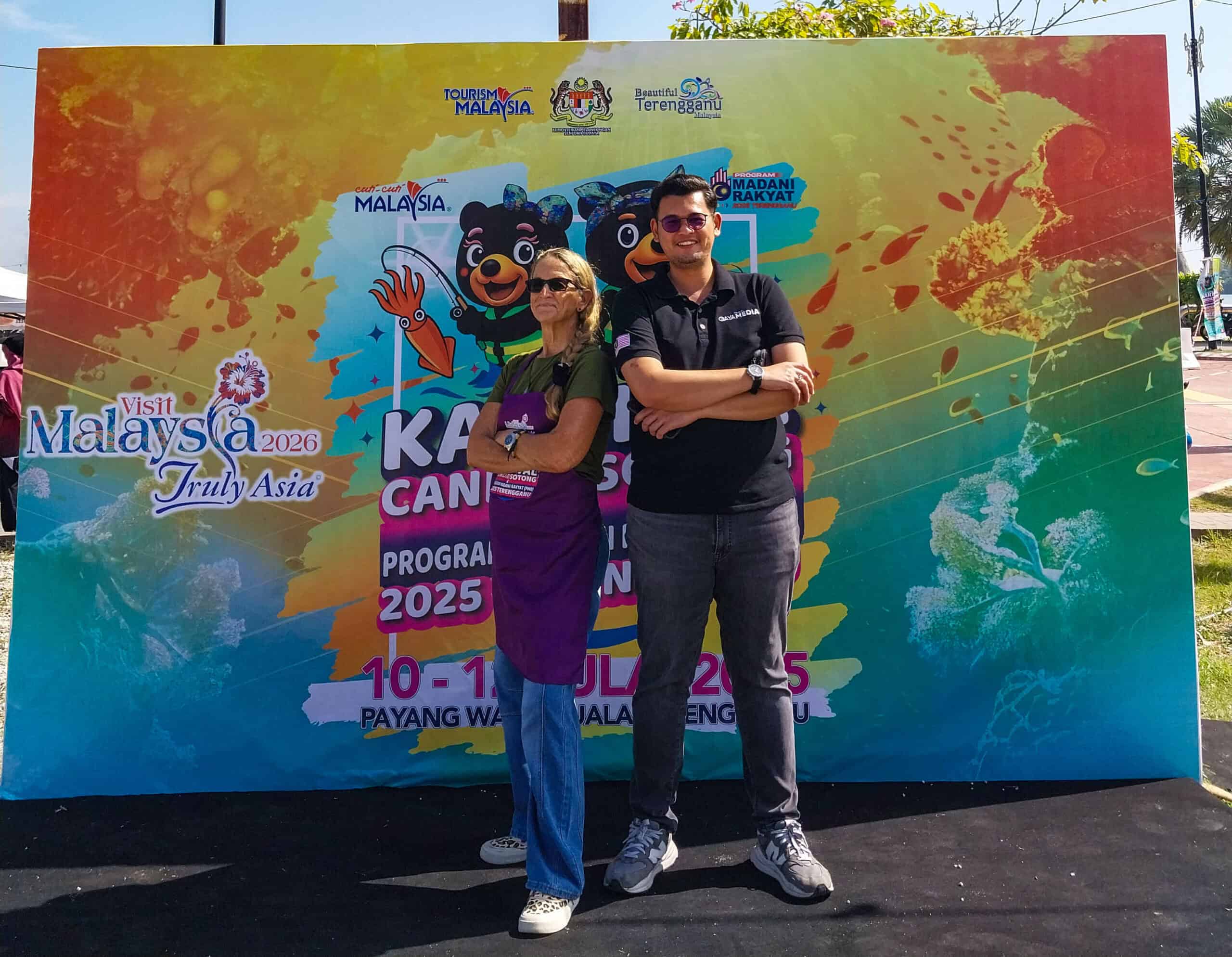
My media trip visit wasn’t just a sightseeing and familiarization tour. This particular trip was centered around sotong (squid) jigging, a century-old Malaysian fishing tradition now offered as a seasonal (roughly April through August) activity for visitors, not just during the annual Karnival Candat Sotong (festival). Along the way, I experienced Terengganu’s food, culture, and a surprisingly fresh identity: still slightly old-school, definitely less sleepy, but with a little more sparkle and accessibility for travelers (with or without a media team buffer zone).
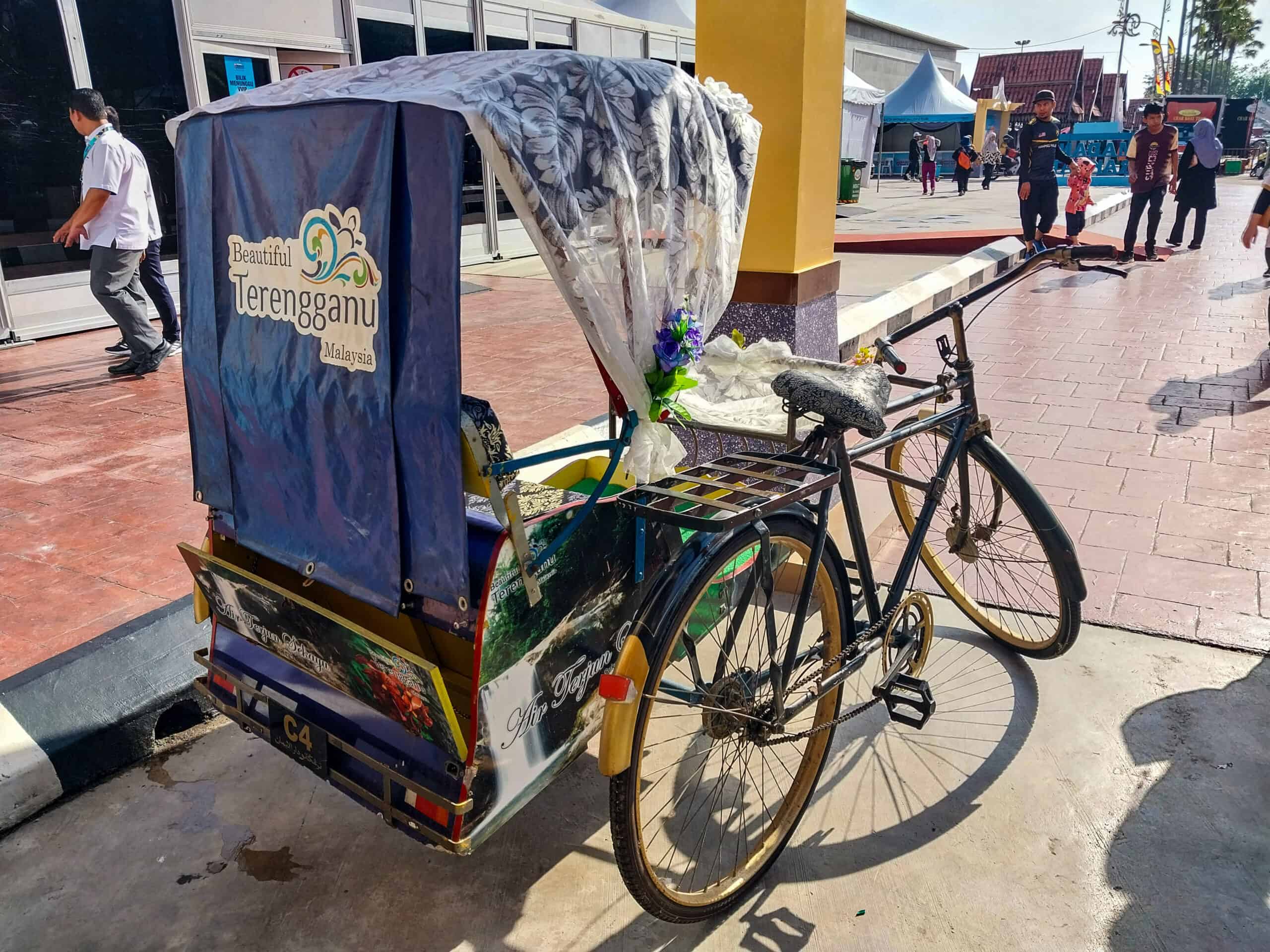
The Long Road from Kuala Lumpur to Terengganu
Our group trip began at sunrise in Kuala Lumpur, heading eastward by bus along the East Coast Expressway (LPT), a route that cuts through the heart of Peninsular Malaysia. Buses aren’t my favorite mode of transportation, but I find land travel in Peninsular Malaysia is far from boring. Even the highway scenery is often picturesque and surprisingly interesting to watch roll by. I just zone out and let my thoughts wander.
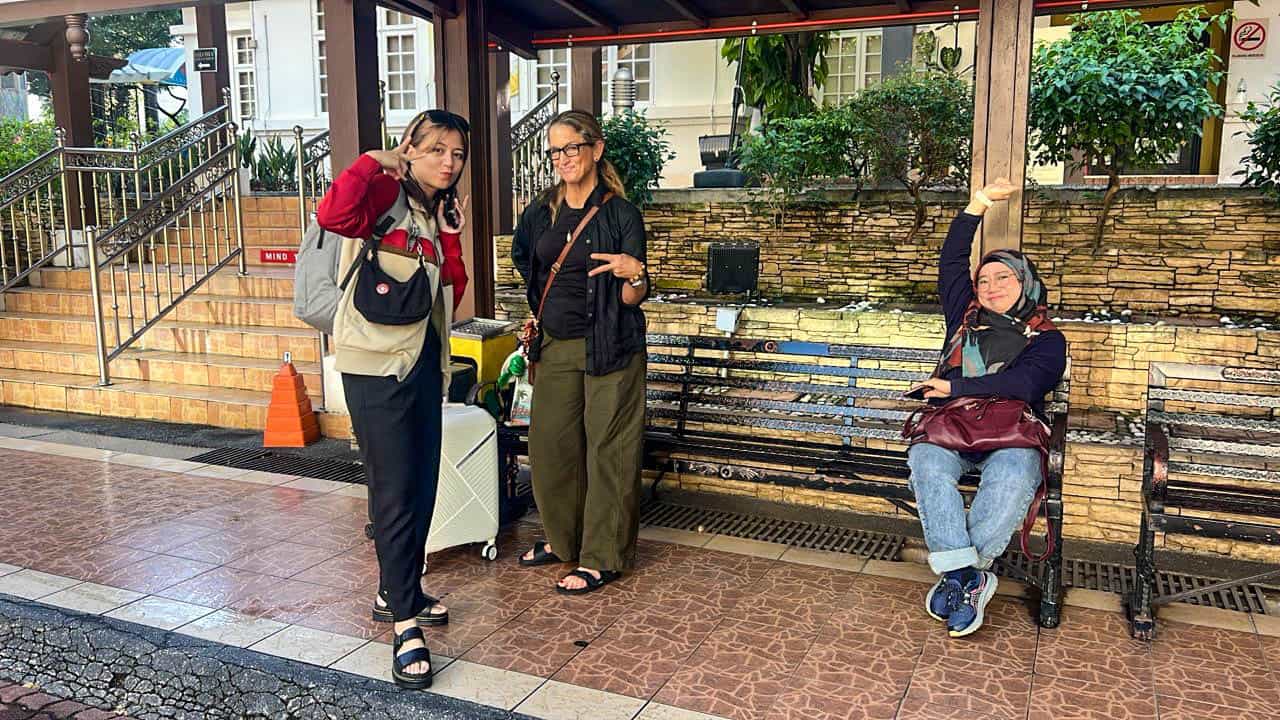
There are at least two well-established rest stops along this route, offering plenty of delicious food options and clean toilets (and even showers). They feel very safe too. A far cry from the rest stops I’m used to back home. There’s a distinct travel vibe at Malaysia rest stops, and the excitement of the open road seems to be shared among strangers. These stops can feel almost festive if you’re in the right mind set.
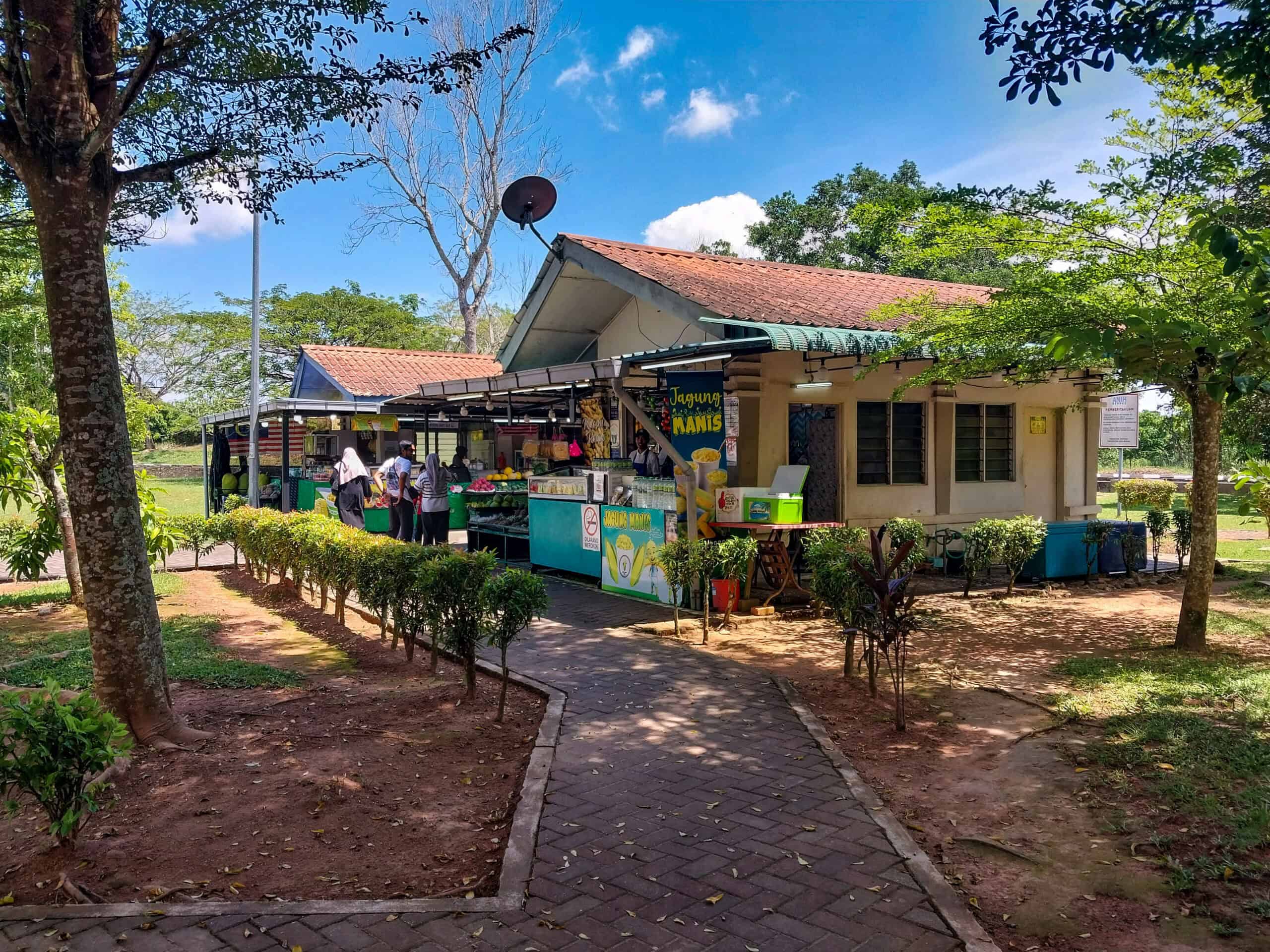
The journey takes around six to eight hours, but if I can handle it, so can you. In fact, if I had to choose between a car or a bus, I might go with the bus because I think the bus’s higher vantage point gives better views of the unique countryside (during the day).
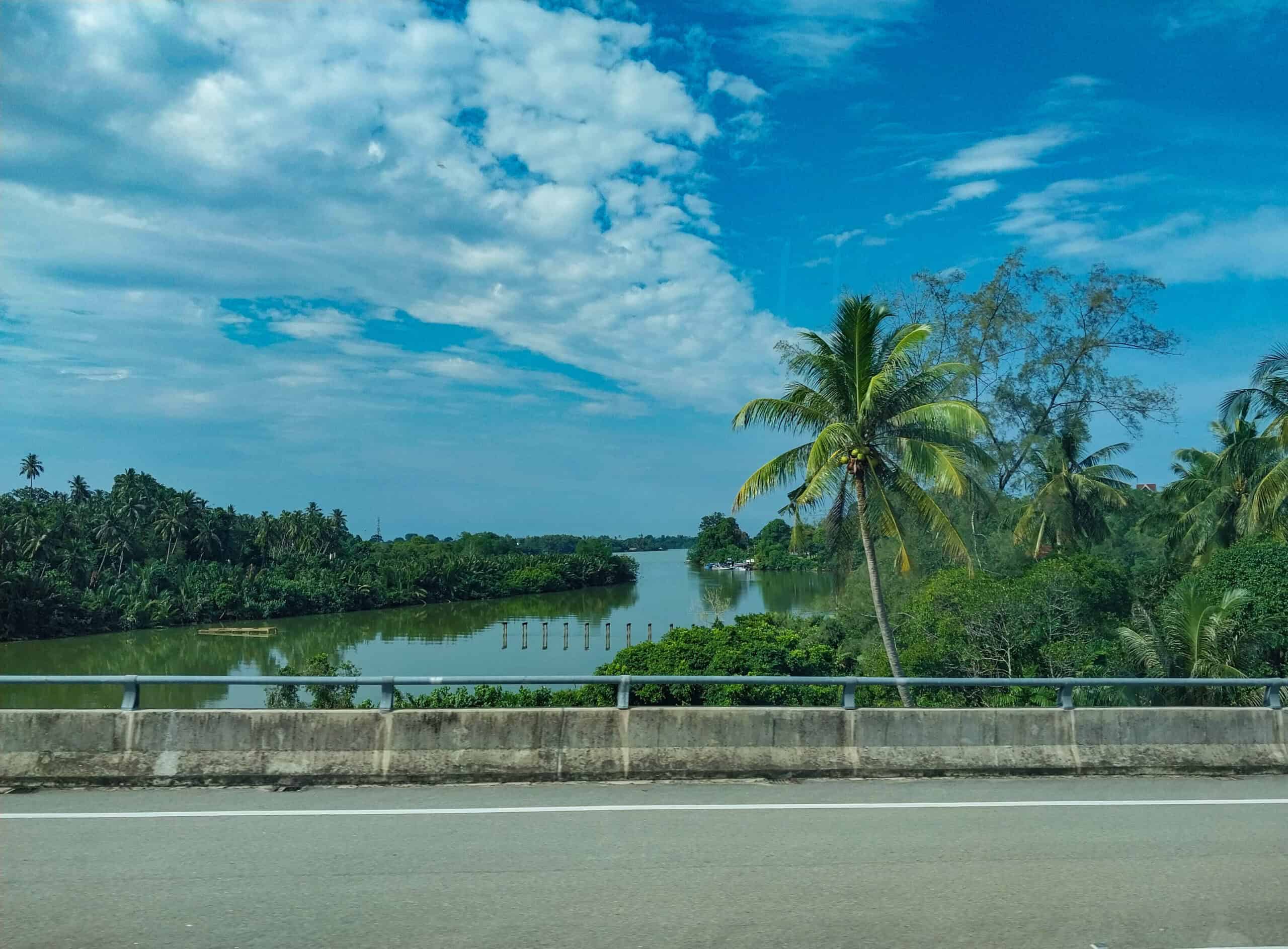
When we finally arrived in Kuala Terengganu, my mouth dropped open a little. I didn’t recognize the place, because it looked far more alive than I remembered. I definitely appreciate pleasant surprises like this! But the best part of that long travel day came when we checked into the Primula Beach Hotel, an old-style Malaysian hotel that ticks all the right boxes for me, and offers direct beachfront views.
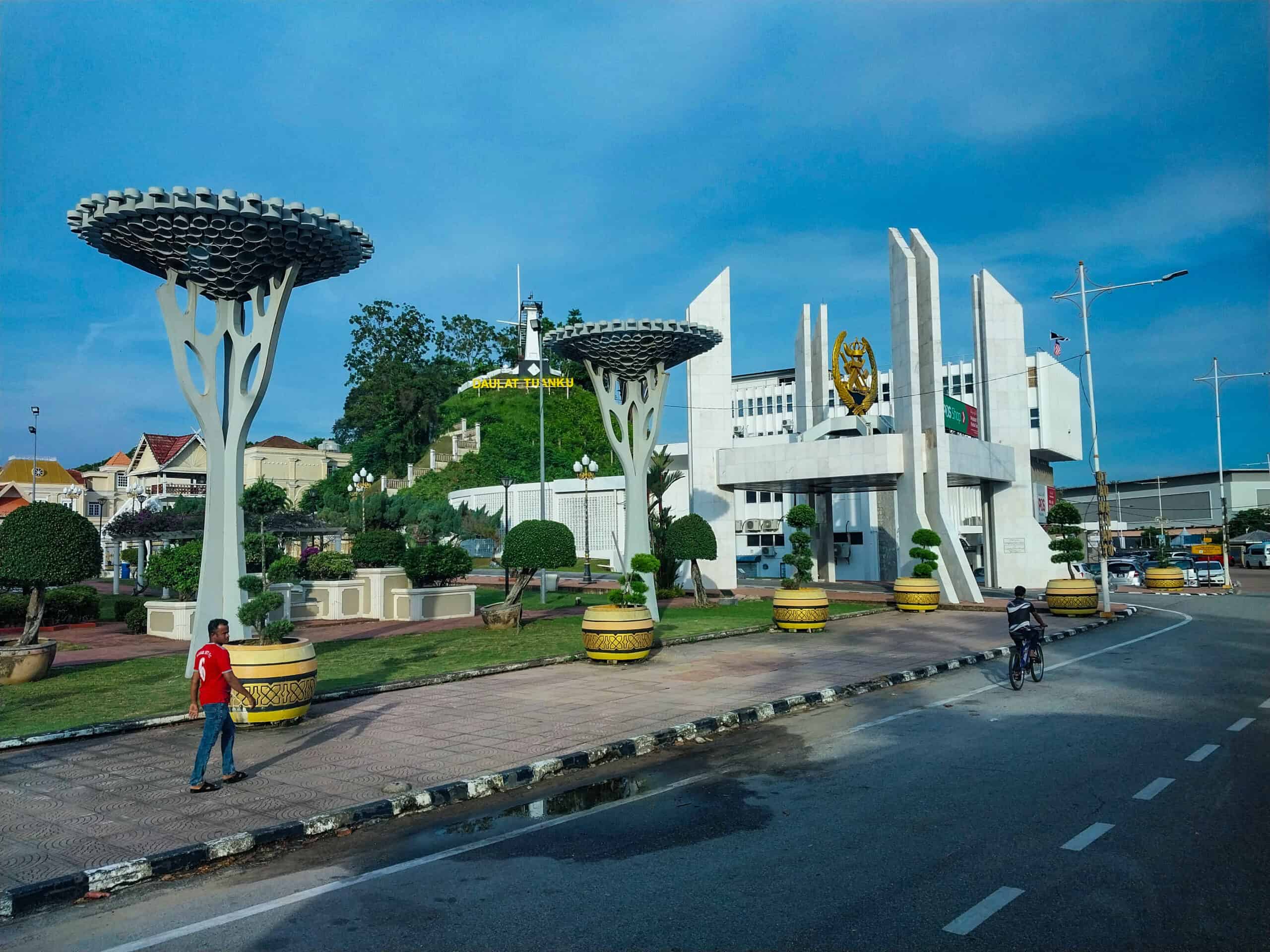
One tip I’ve picked up from years of traveling around Malaysia: older hotels often have much bigger rooms than their modern competitors. And if a hotel’s been around that long, it usually means the management is doing something right. Good management, happy staff. Primula Beach Hotel is no exception, it originally opened in 1984.
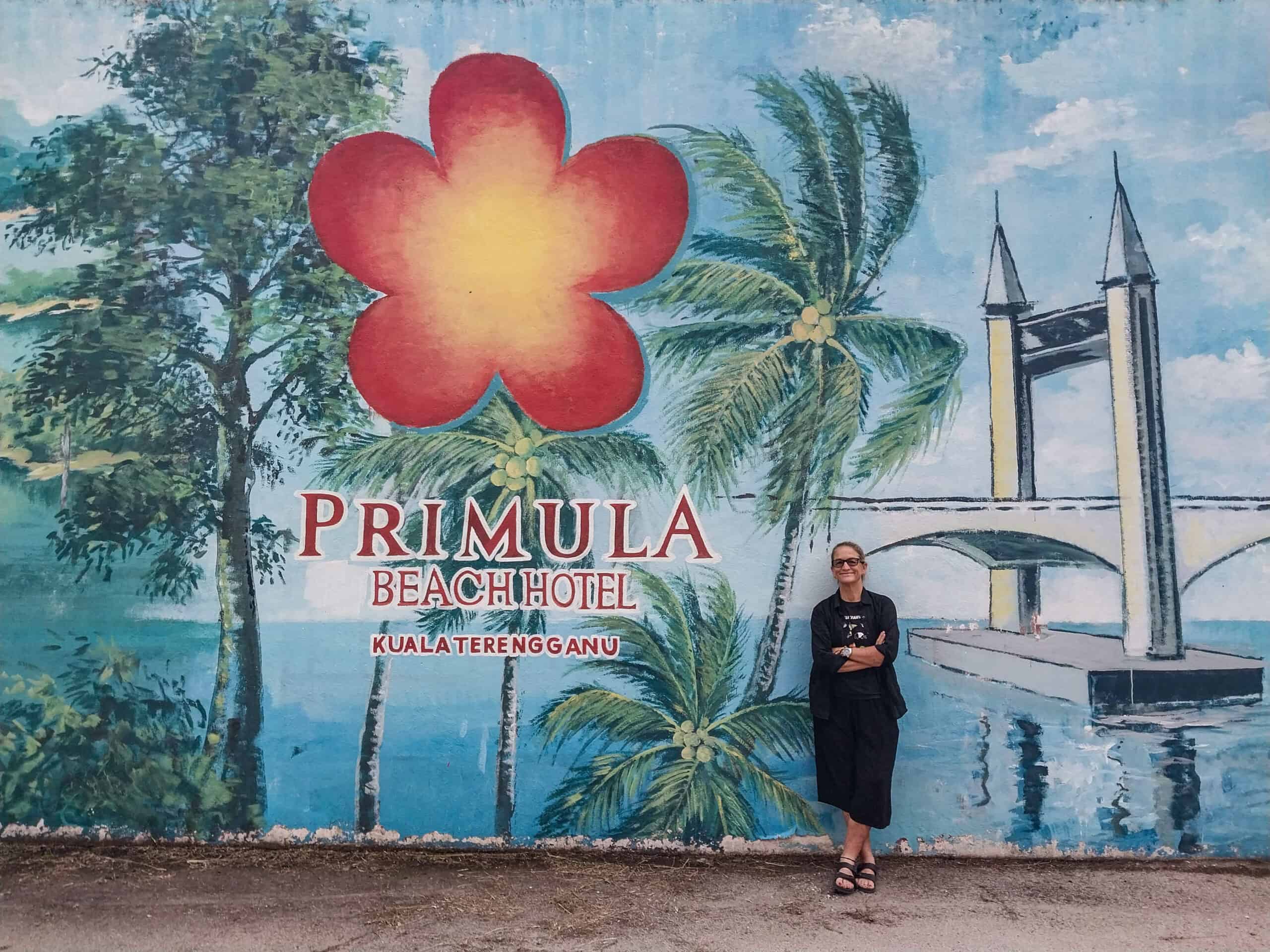
My shared room was spacious and quiet, the beds on the small side but comfortable, and the amenities practical. Bonus points for the fabulous rain shower, private balcony with a sea view, and incredible sunrises. It’s not the newest place in town, but with that view and space to breathe, I’d stay at the Primula Beach Hotel again in a heartbeat.
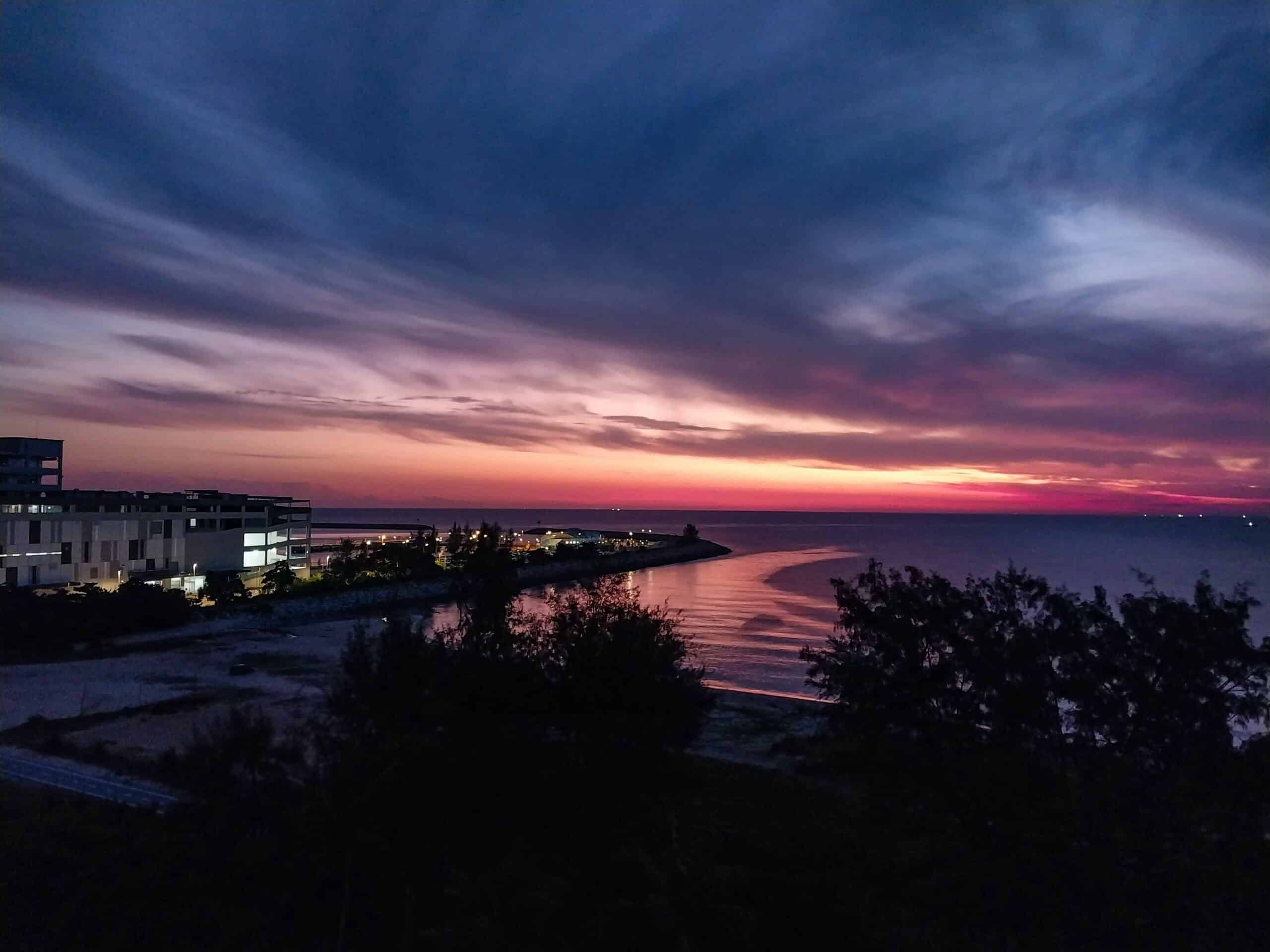
Festival Life: From Morning Markets to Midnight Squid Jigging
The next morning, we hit the ground running at Karnival Candat Sotong 2025, which had already kicked off the day before. Karnival Candat Sotong is an annual Kuala Terengganu festival celebrating candat sotong, a form of night squid fishing unique to the east coast, where it’s closely tied to everyday life and local tradition. Terengganu began hosting organized squid jigging festivals in 1991, and the event expanded to include international participants by 2014.
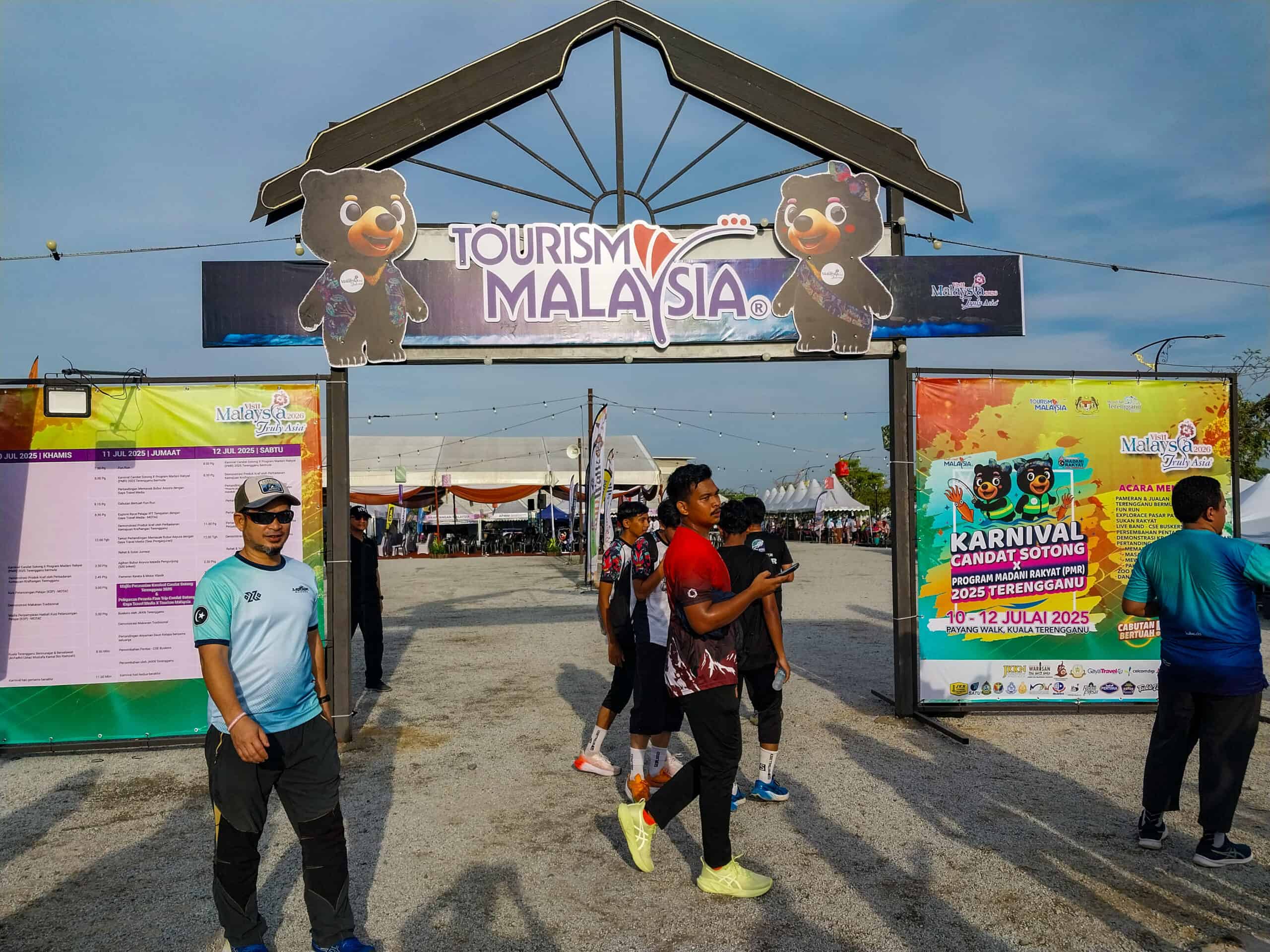
The event was standard family friendly fun with cooking demos, food stalls, contests, and cultural performances, but there was more to this year’s story. This year marked a first: Terengganu’s annual Candat Sotong Festival was held alongside Program Madani Rakyat, a nationwide outreach initiative that delivers public services directly to local communities.
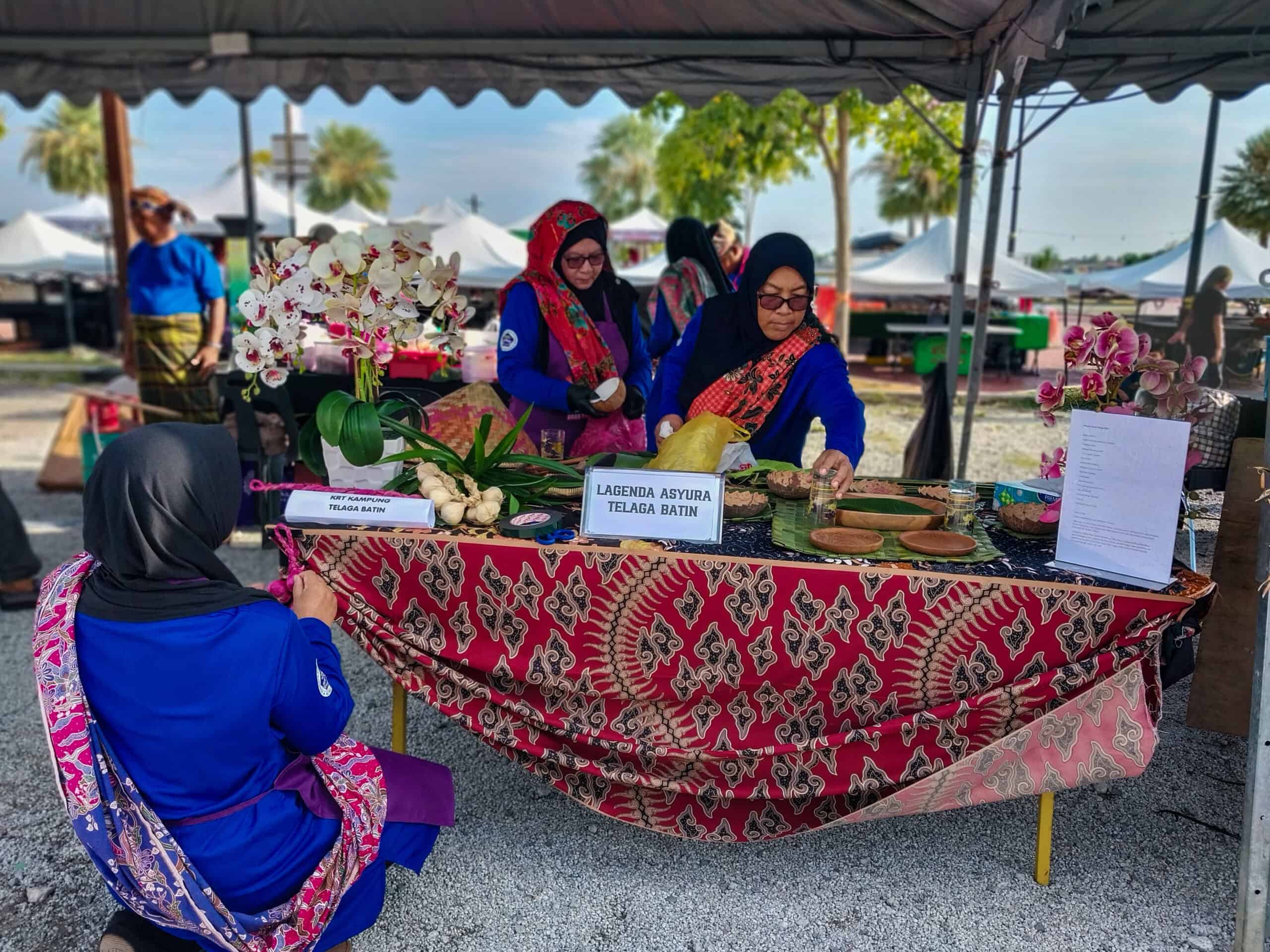
Though mainly designed with the local community in mind, the Karnival Candat Sotong x Program Madani Rakyat 2025 was open to all, including domestic and international tourists.. Between the stage shows, food stalls, squid dishes, and nighttime squid jigging, it was a fun way to experience how tradition and everyday life come together in Kuala Terengganu. What stood out most was how actively involved the local community was in cooking, selling goods, or simply enjoying the traditional style festivities as our group was.

Scavenger Hunts, Kuih & Bubur Asyura
Later that morning, our group split into teams for a scavenger hunt-style competition inside Pasar Payang, one of Kuala Terengganu’s busy central markets. As a big fan of Malaysia’s eclectic markets, I found this one to be a real standout. The two-story complex has fresh produce, seafood, and local snacks on the ground floor, with batik, songket, and household goods upstairs. I was disappointed not to have had time to come back and browse at my own pace, but there’s always next time! (It’s open daily from 7am to 6pm, and well worth a proper visit.)
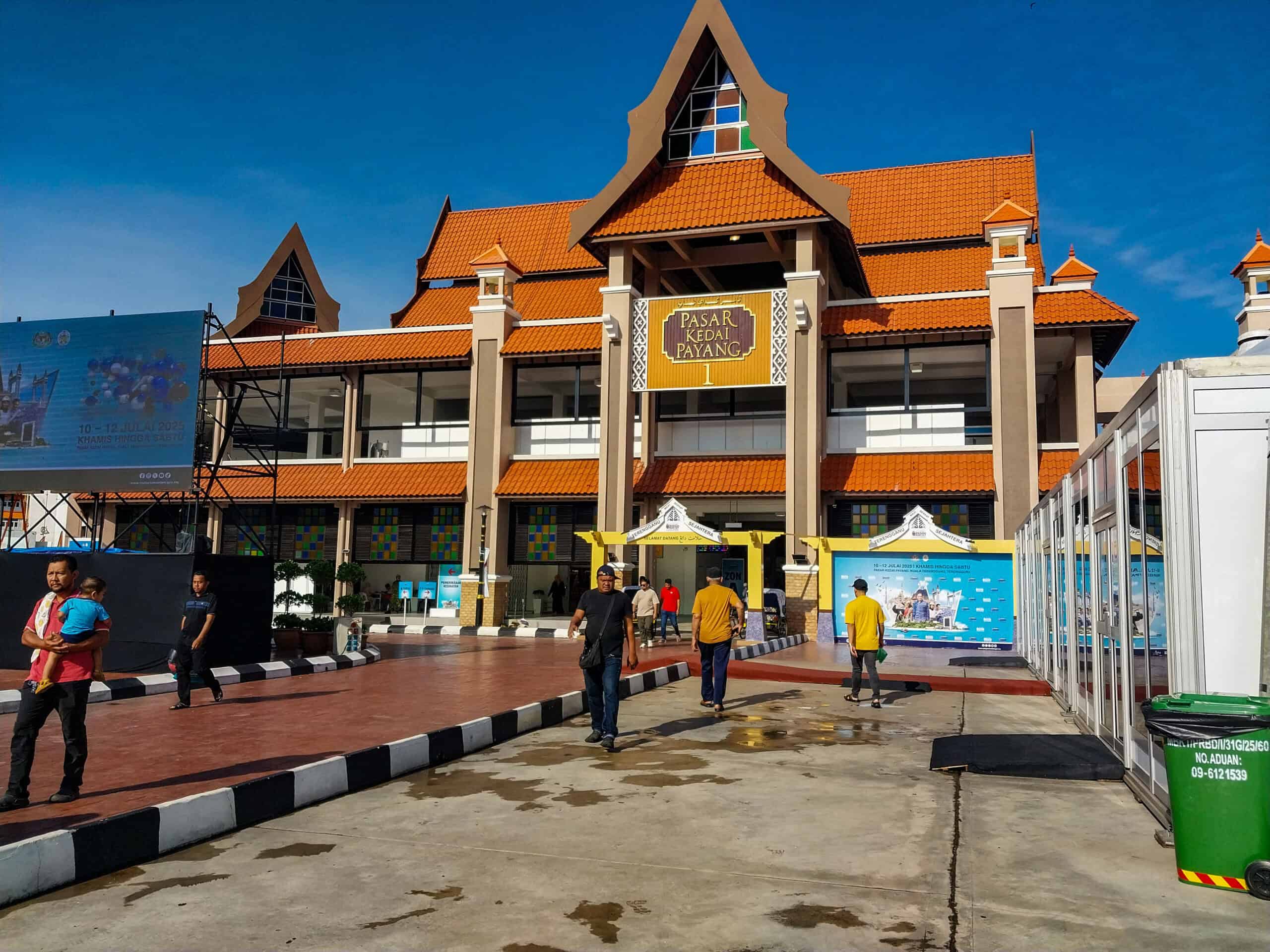
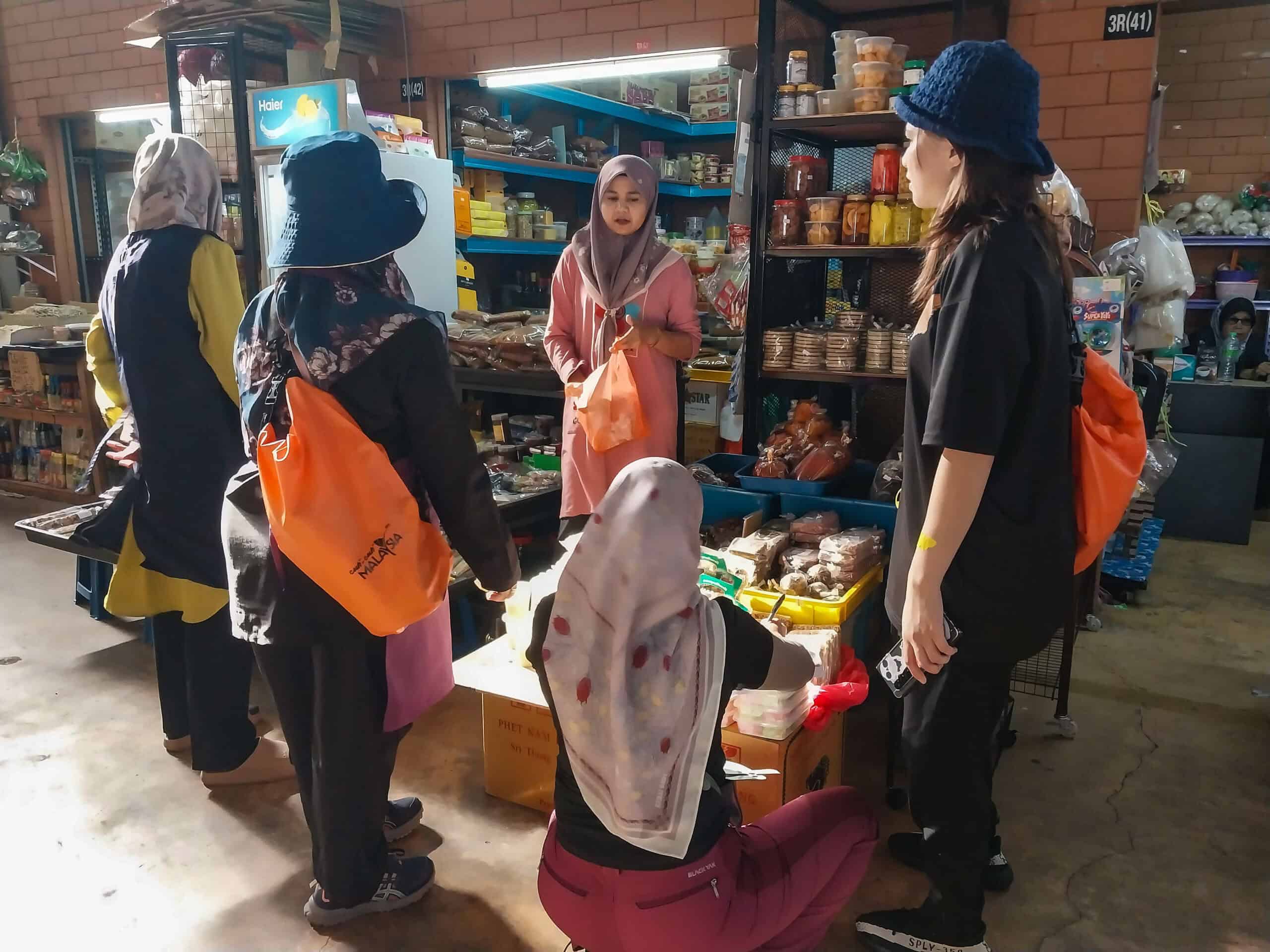
After the hunt (no, my team didn’t win), we joined the crowd for the Bubur Asyura cooking contest, a local tradition tied to Islamic New Year. We sampled different versions of the porridge and even pitched in, with helping stir some of the giant pots. It was hot, chaotic, and good old-fashioned fun.
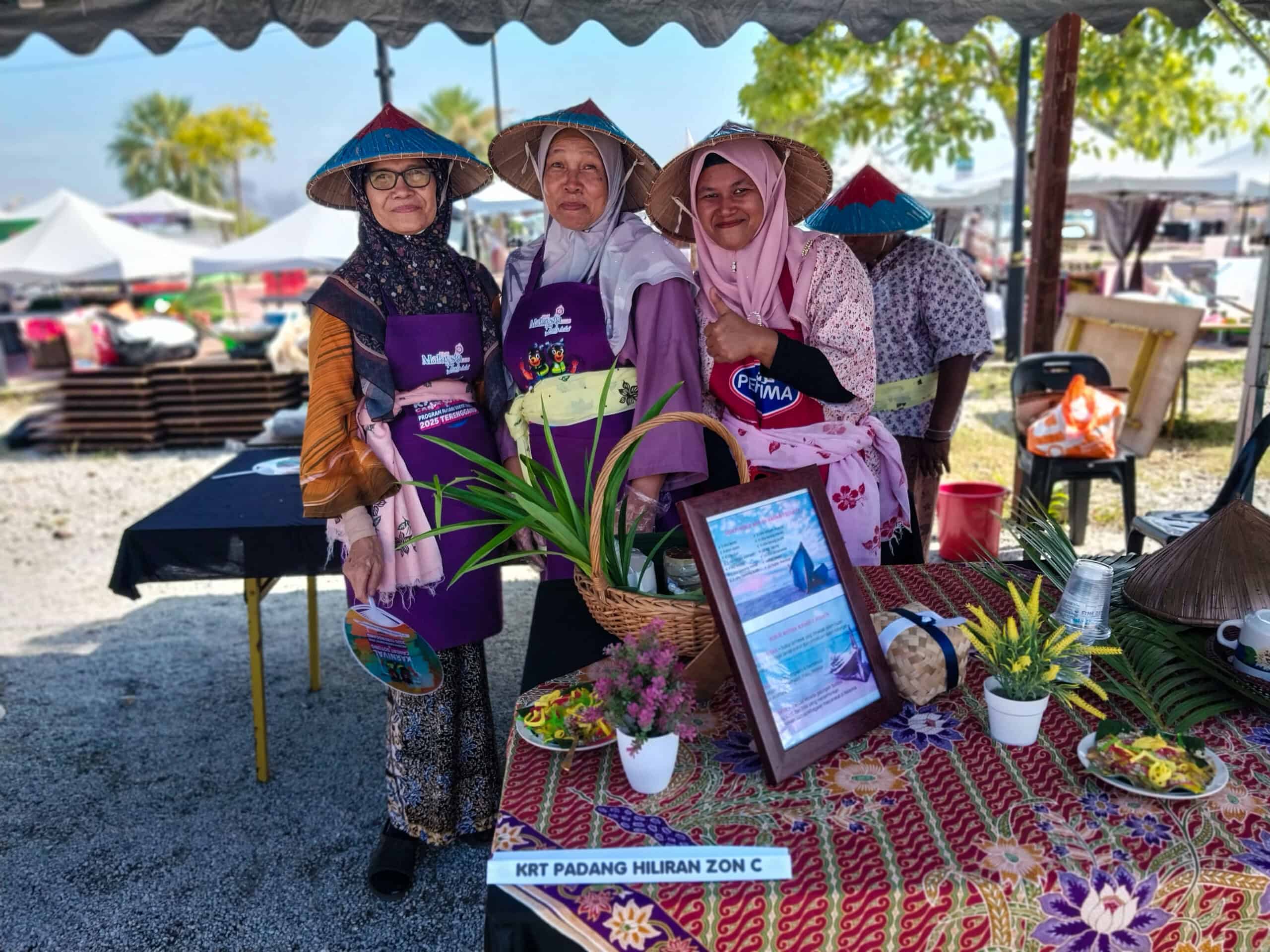

Let’s Go Squid Jigging Terengganu Style!
By afternoon it was time to regroup and prepare for our big squid jigging adventure at sea. Candat sotong literally means “squid jigging” in Malay. It refers to a traditional night fishing method using special lures (called jigs) to attract and catch squid. It’s popular on Malaysia’s east coast, especially in Terengganu, where the squid season runs from March to August and peaks around May. While it’s now gaining traction as a local and international tourism experience, squid jigging in Terengganu has actually been quietly promoted for the past ten years or so.
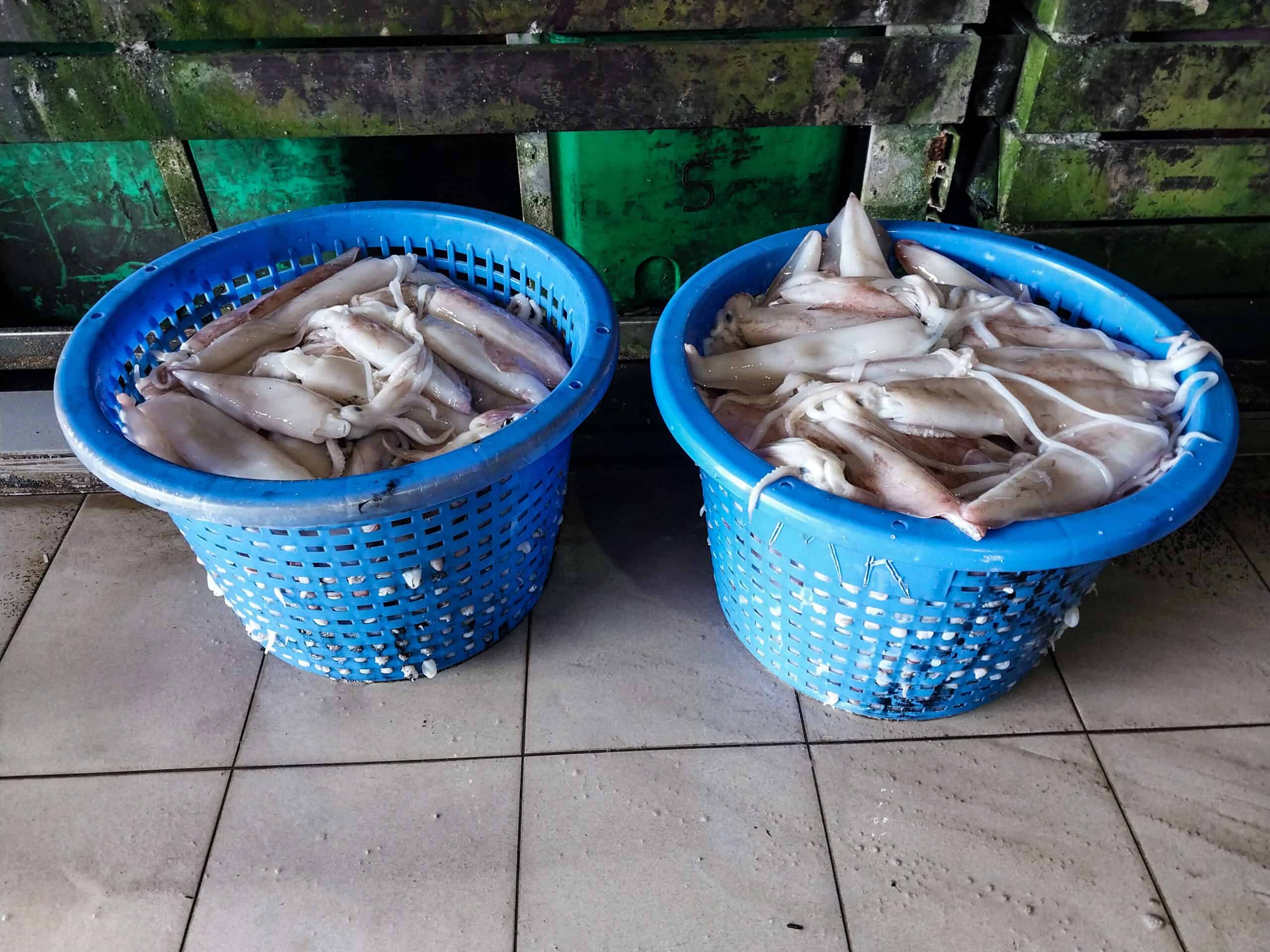
As a California transplant squid jigging isn’t new to me, nor being on rustic wooden boats with salty sailors. So, I was prepared to get dirty, be uncomfortable and hopefully live to tell the tale. Nevertheless, I was excited. Any opportunity to be on a boat is A-Okay with me.
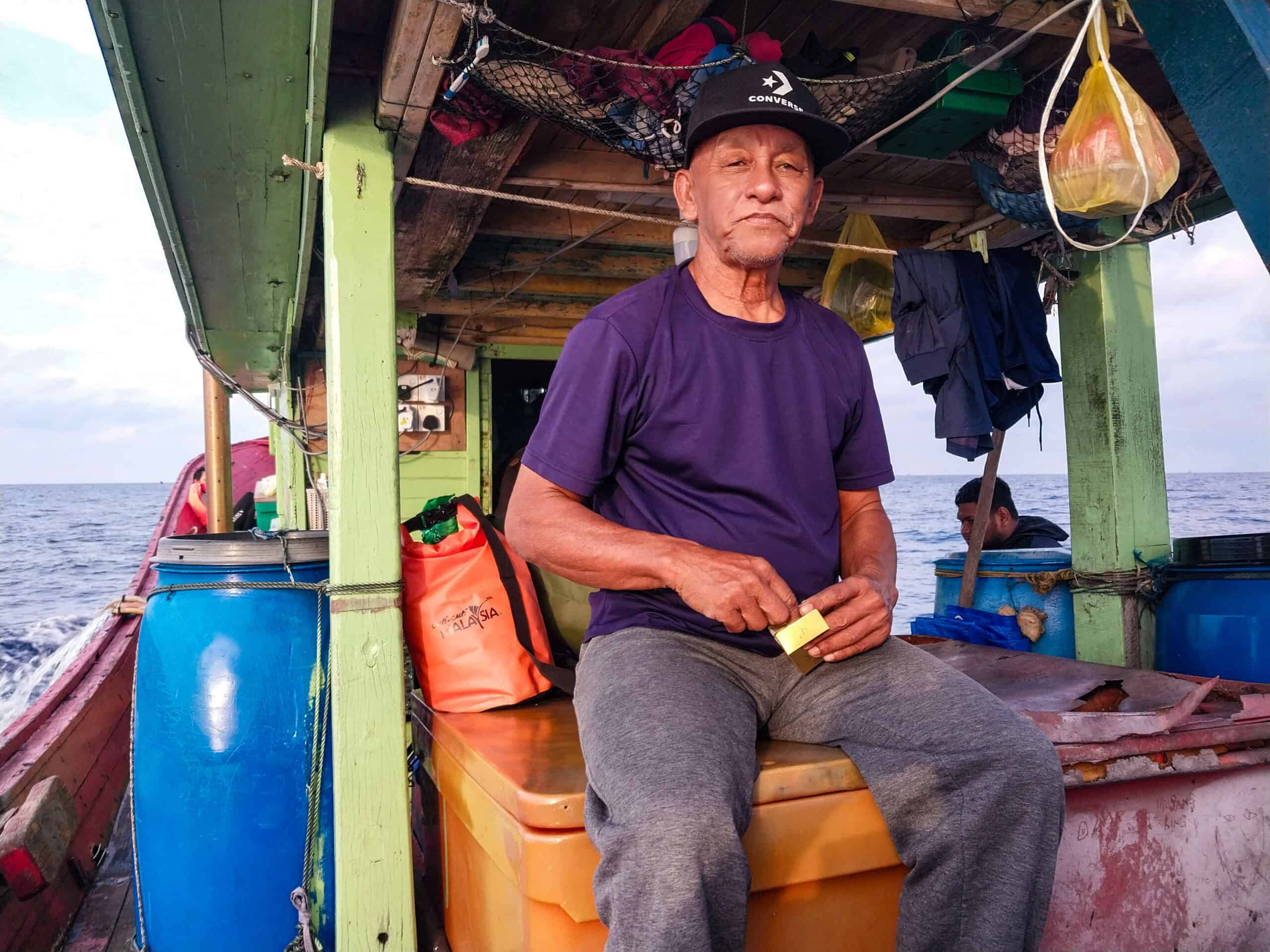
Perhaps what surprised me was how little had been done to adapt the boats for what was, essentially, a tourism promotion effort. They were very much working boats, practical, unpolished, and unapologetically real. But hey, I get it. A few boats are invited to participate and more than a few eager hands go up and a seriously authentic seasonal squid jigging event is born.
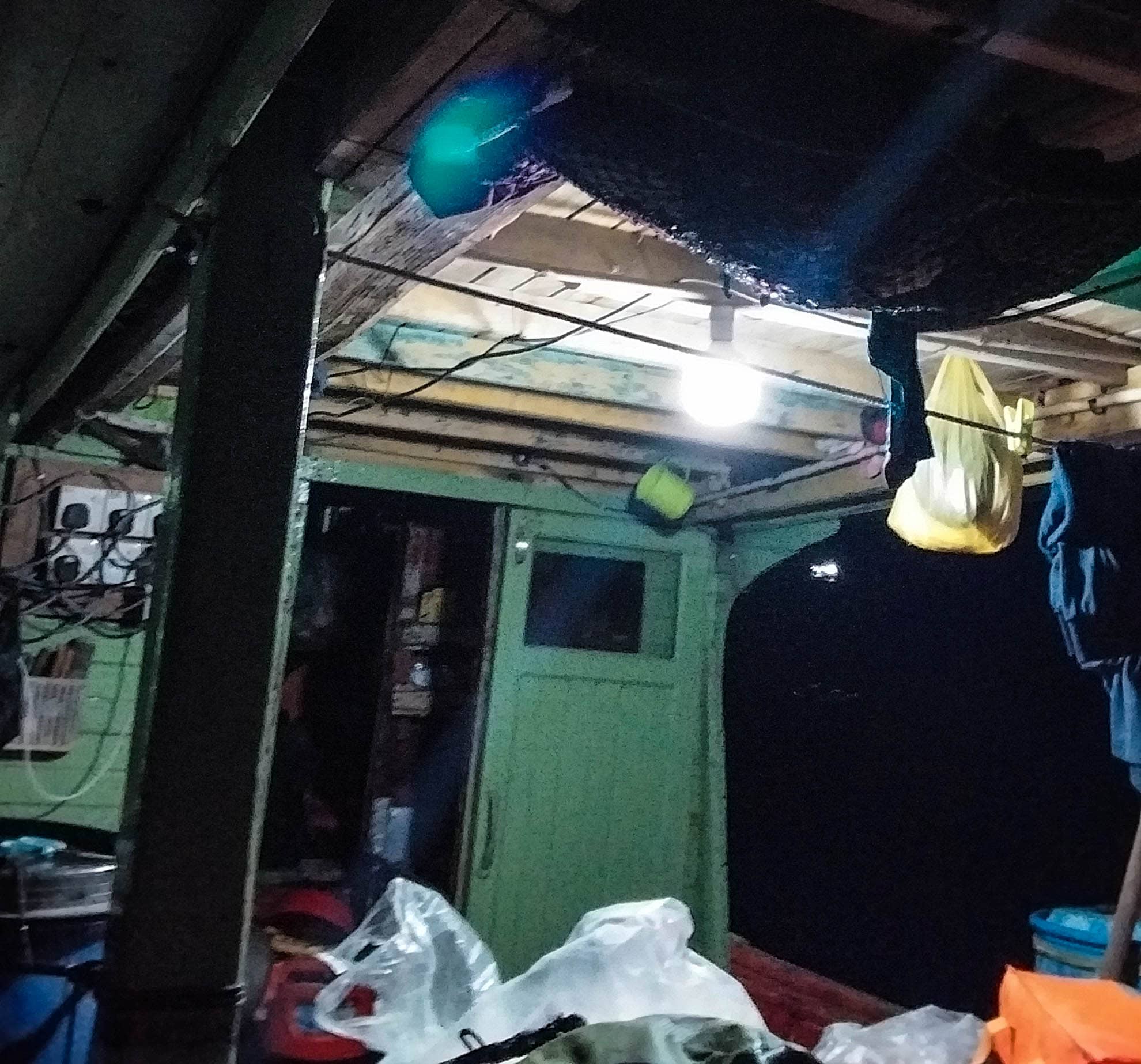
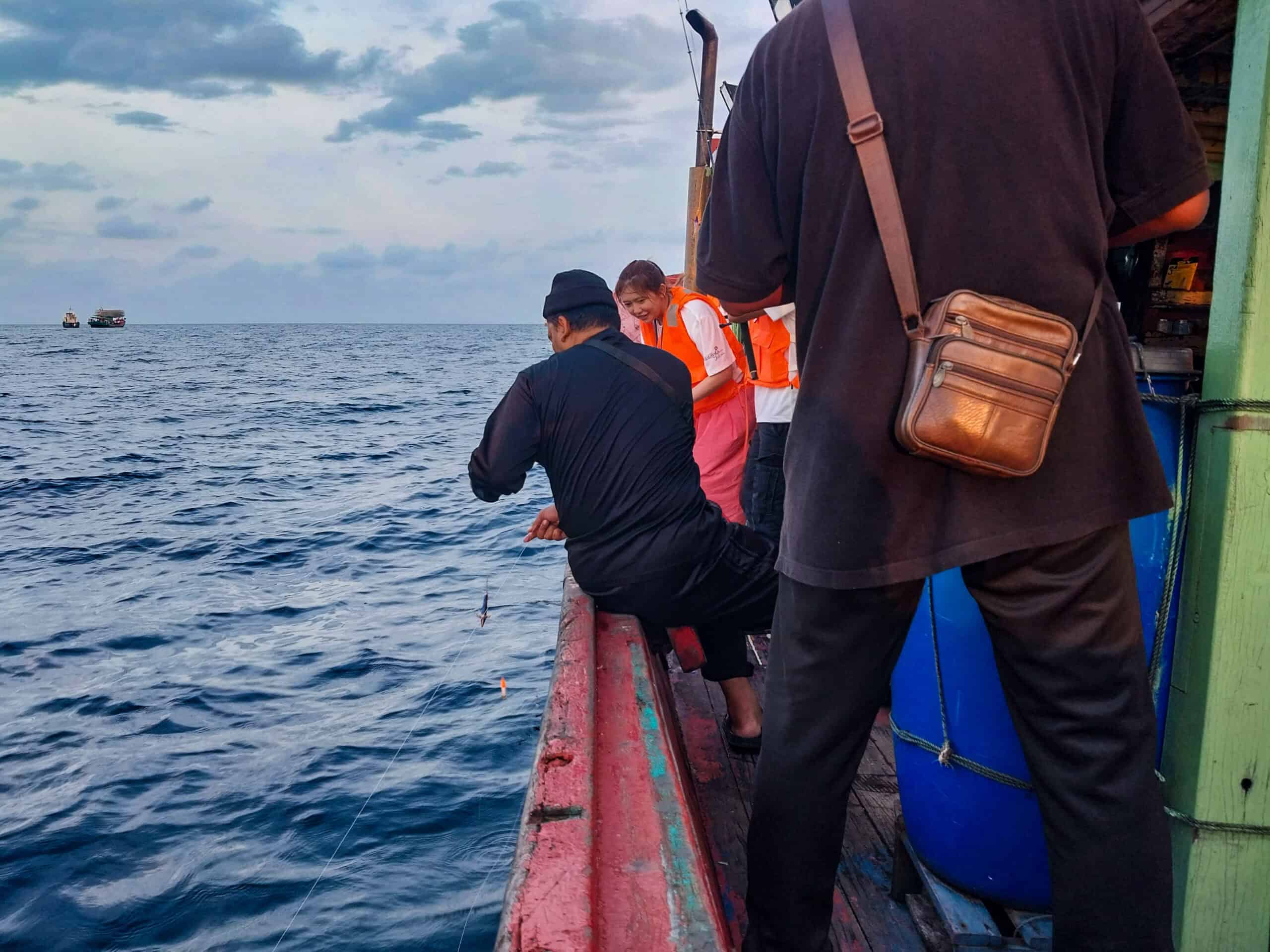
However, newbies eager to have their own squid jigging experience should indeed be prepared. This is much more than a few fun selfie moments and to be honest, a little dangerous. These boats are built for function, not comfort, which is part of the charm, if you’re ready for it. And they don’t usually have daily maid service, so they can get pretty gnarly. Especially anything resembling a toilet.
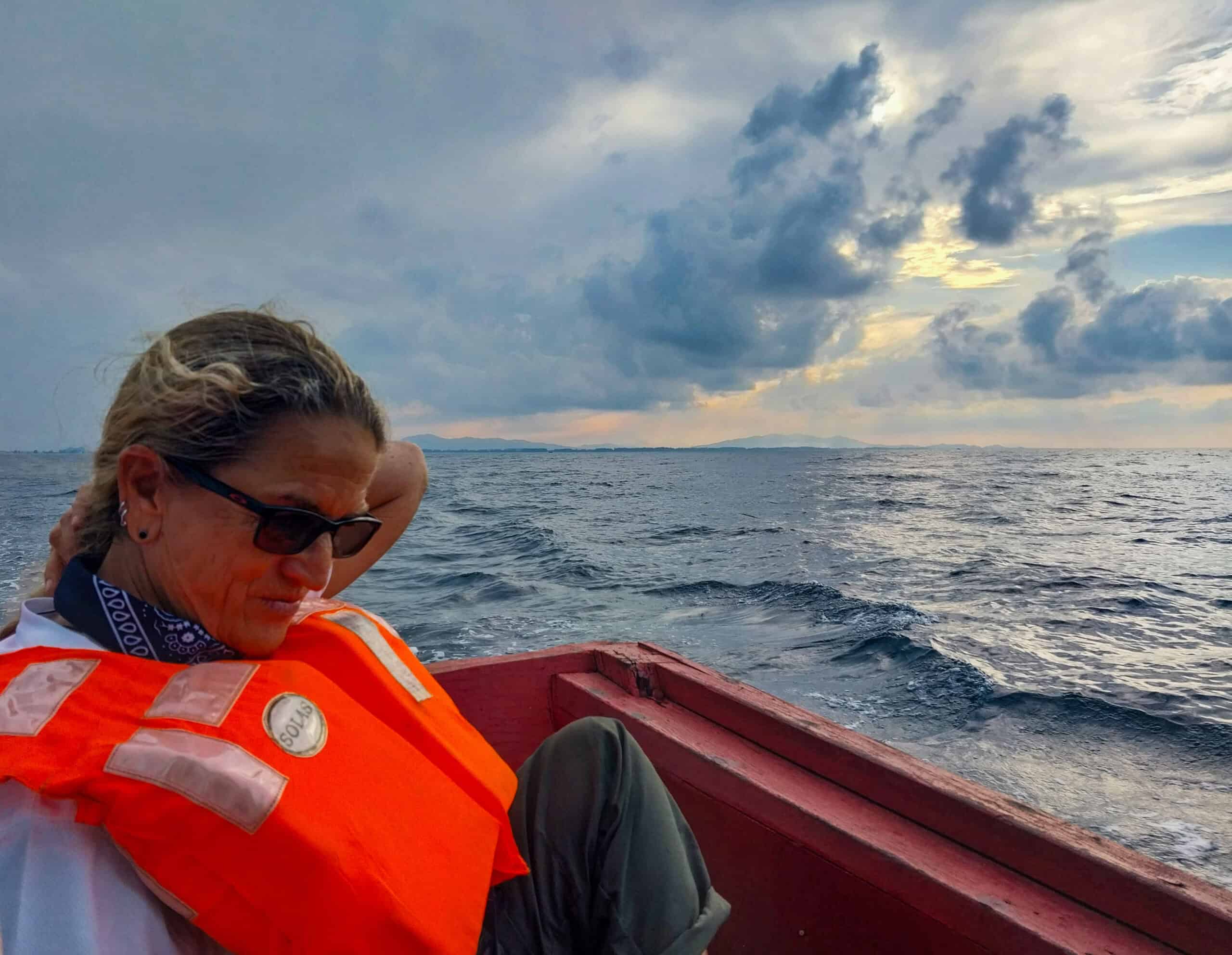
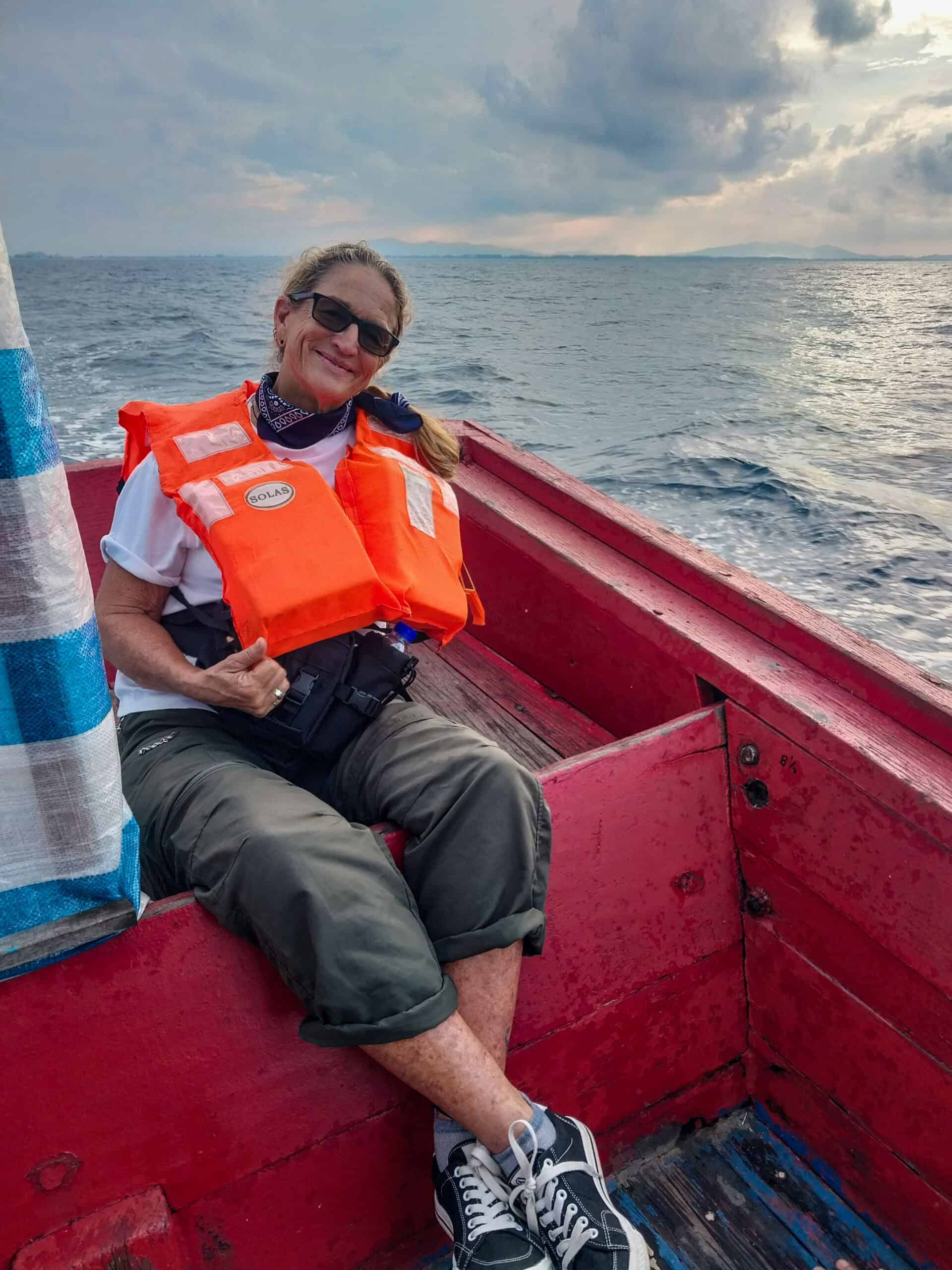
That said, the boat I was on was one of eight that departed from the nearby waters of Jeti Bot Penambang Pasar Payang in the late afternoon. Water taxis delivered us to our assigned squid boats. Although walking space was pretty tight, I found a spot in the back (next to the makeshift toilet).
Without exterior safety ropes, I wasn’t sure I could trust my rusty sea legs not to fail me, and I sure as heck didn’t want to be part of a man (or woman) overboard scenario. And with the number of influencers on board, that potential 15 minutes of Instagram fame would not have been pleasant. Embarrassing, if you will.
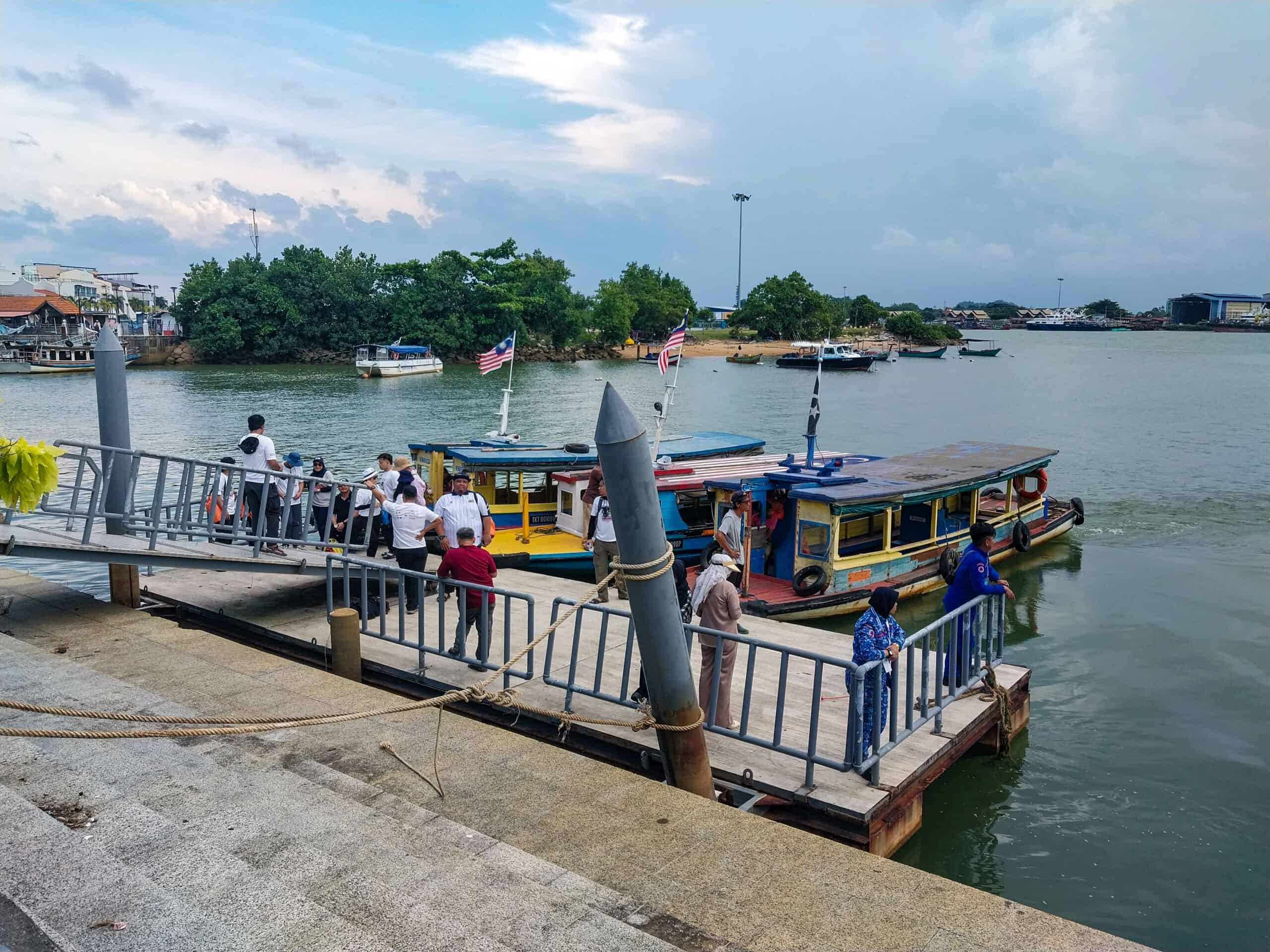
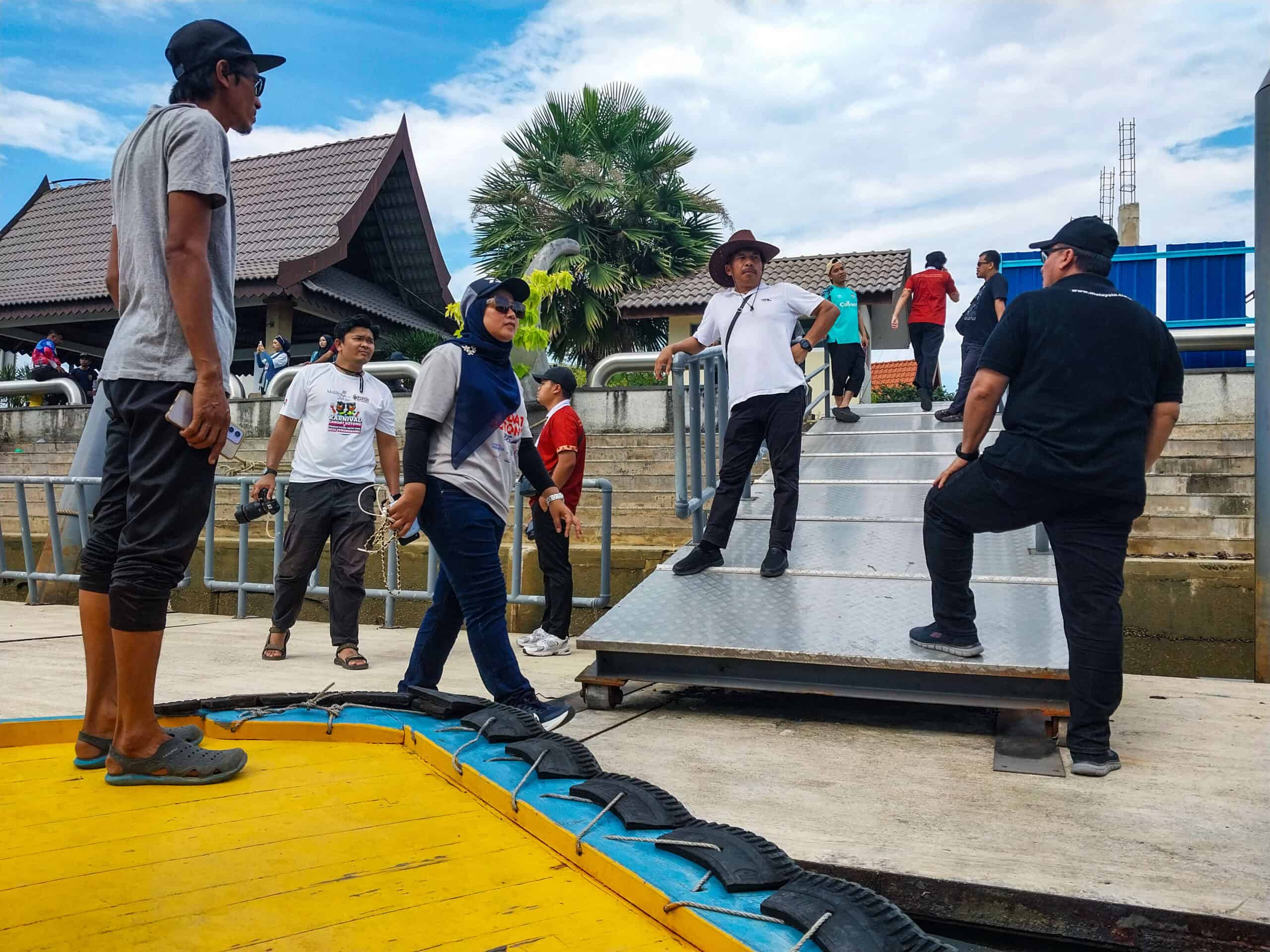
Overall, the ride out to sea was excellent. The South China Sea, a friendly emerald green, was picture perfect as we passed under the Kuala Terengganu Drawbridge. I was grinning ear to ear. I had actually wanted to join this annual Candat Sotong Festival for the past 10 years, after I first saw a few of my blogger friends had attended. But alas, it is usually by invitation only. However, this year it was finally my turn. My non-local status had deemed me as token international participant and I was very appreciative of that.
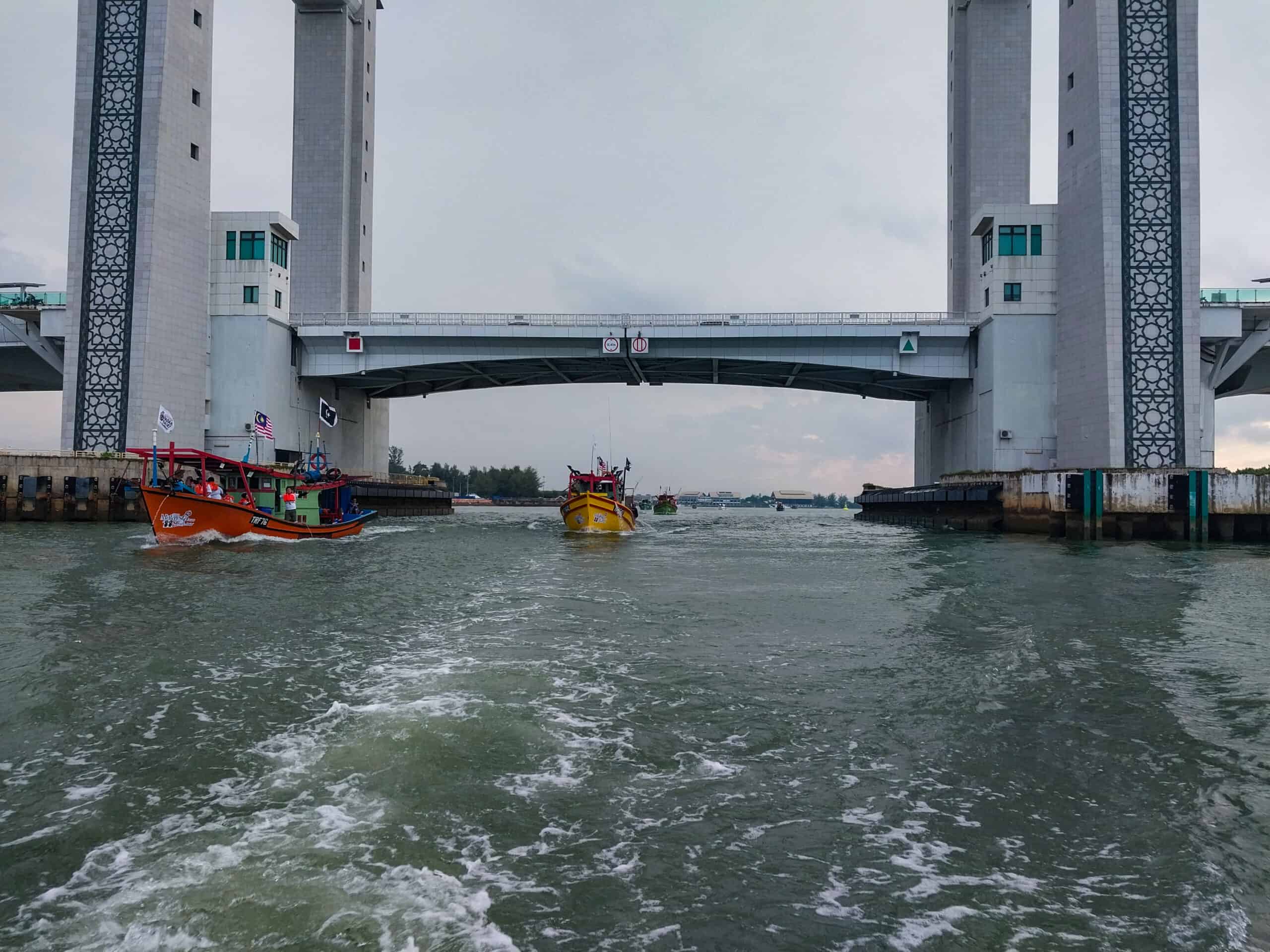
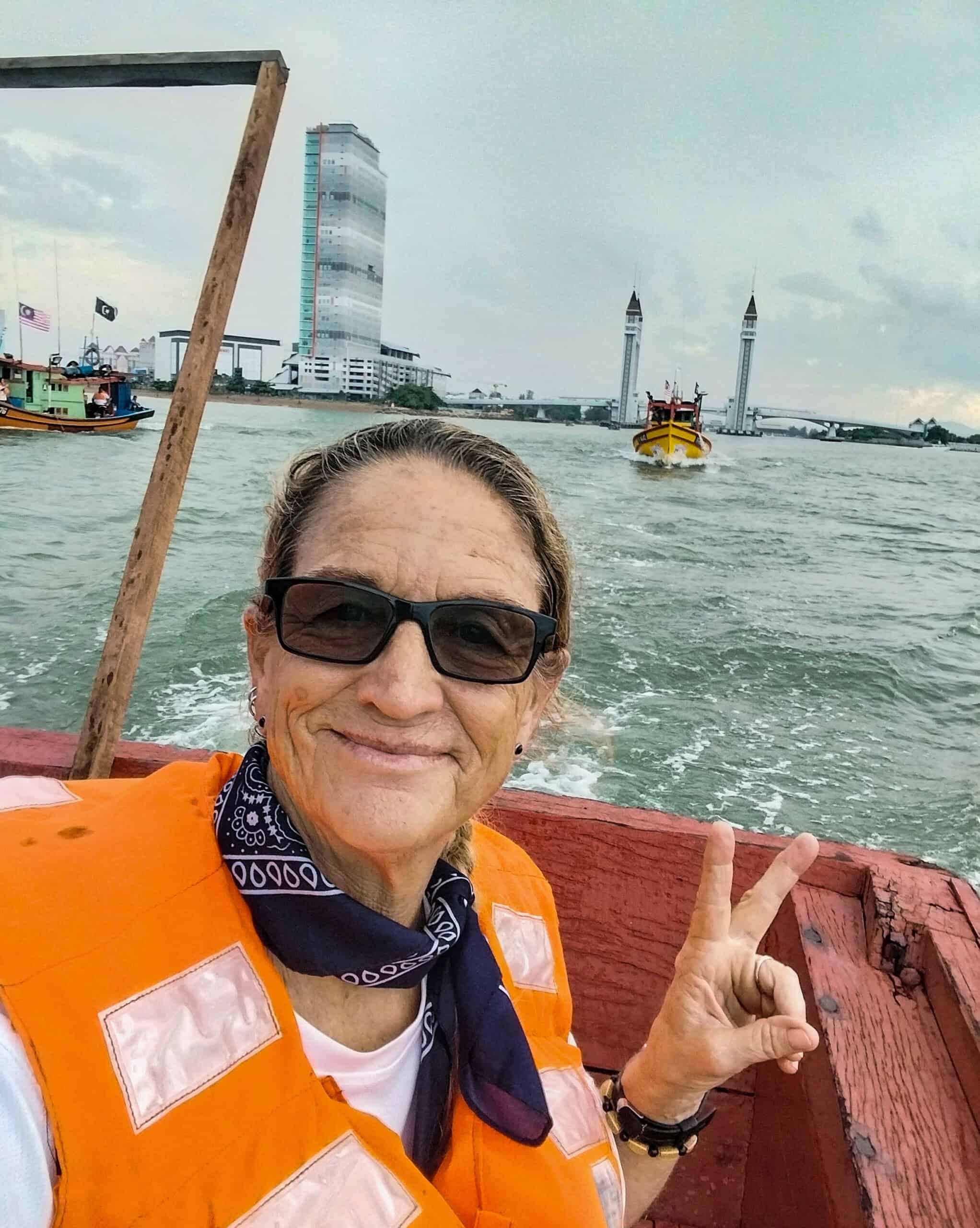
Due to the weight of these large wooden boats, it took us about an hour to reach a mere 10 kilometers offshore. But the seas were relatively calm so tossing around was thankfully minimal. Once we dropped anchor, jigging handlines were passed out with a brief demonstration and we were good to go. I’m not a big handline fan, but when in Rome (or Kuala Terengganu) you toe the line so to speak. A few on our boat had brought their own rod and reels though.
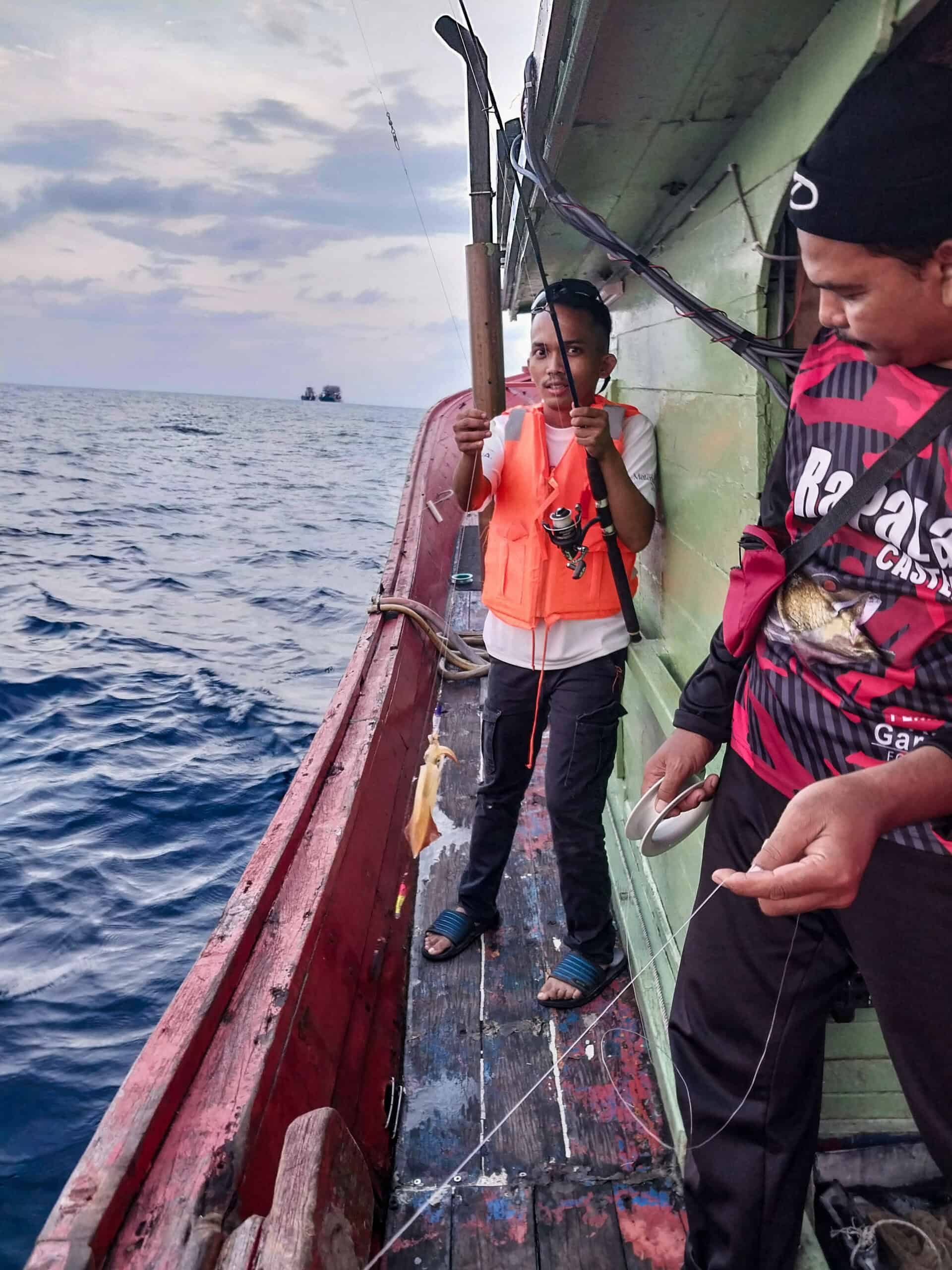
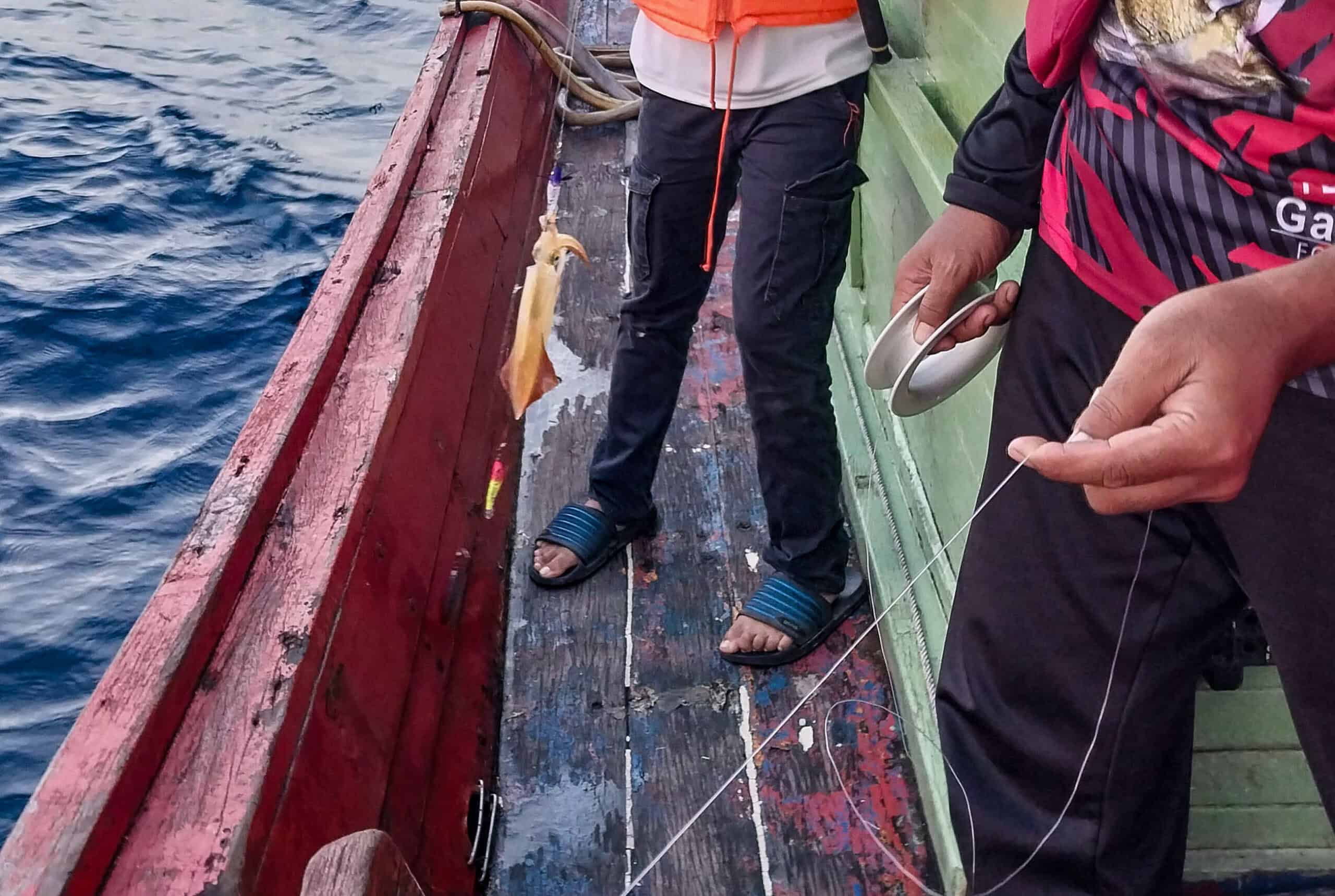
I had certainly thought this was going to be a piece of cake for an old sea gal like myself, but I was wrong. In fact, I was a complete failure. I did get one serious bite, but it got away. It wasn’t long before my disappointment turned to boredom. I was pleasantly distracted with the sunset and hearing the hoots of more successful jiggers on other boats.
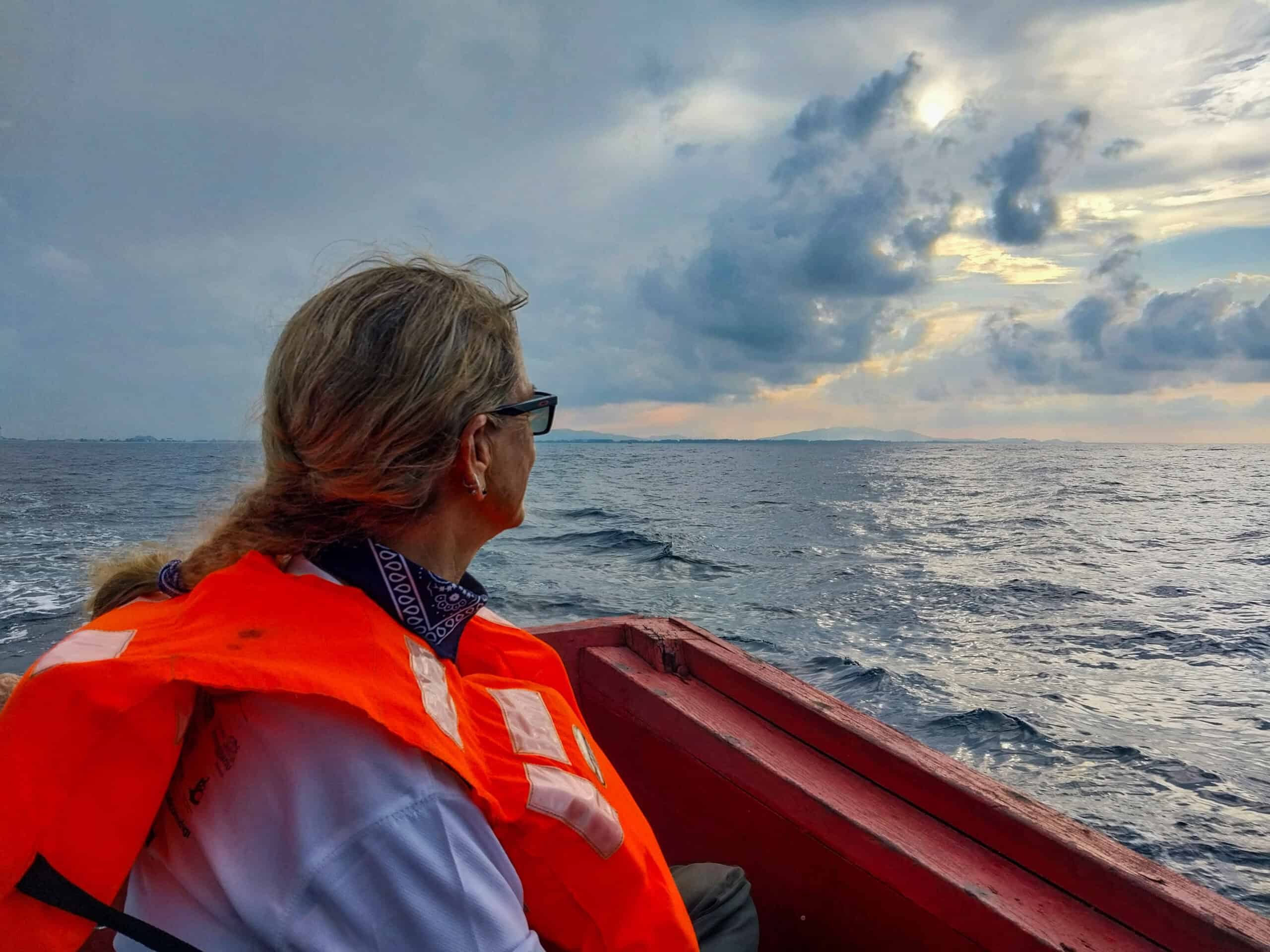

Packets of food were distributed, but it wasn’t nearly as exciting as I had hoped. I’m more of an easy finger food girl when it comes to eating on bobbing boats. Cold noodles in plastic containers doesn’t sit too well either.
Apparently, I wasn’t the only one who was rapidly losing interest in the fun adventure at sea because my team slowly passed out on the front deck (or so I was told). We were all pretty exhausted from the super busy morning we had had.
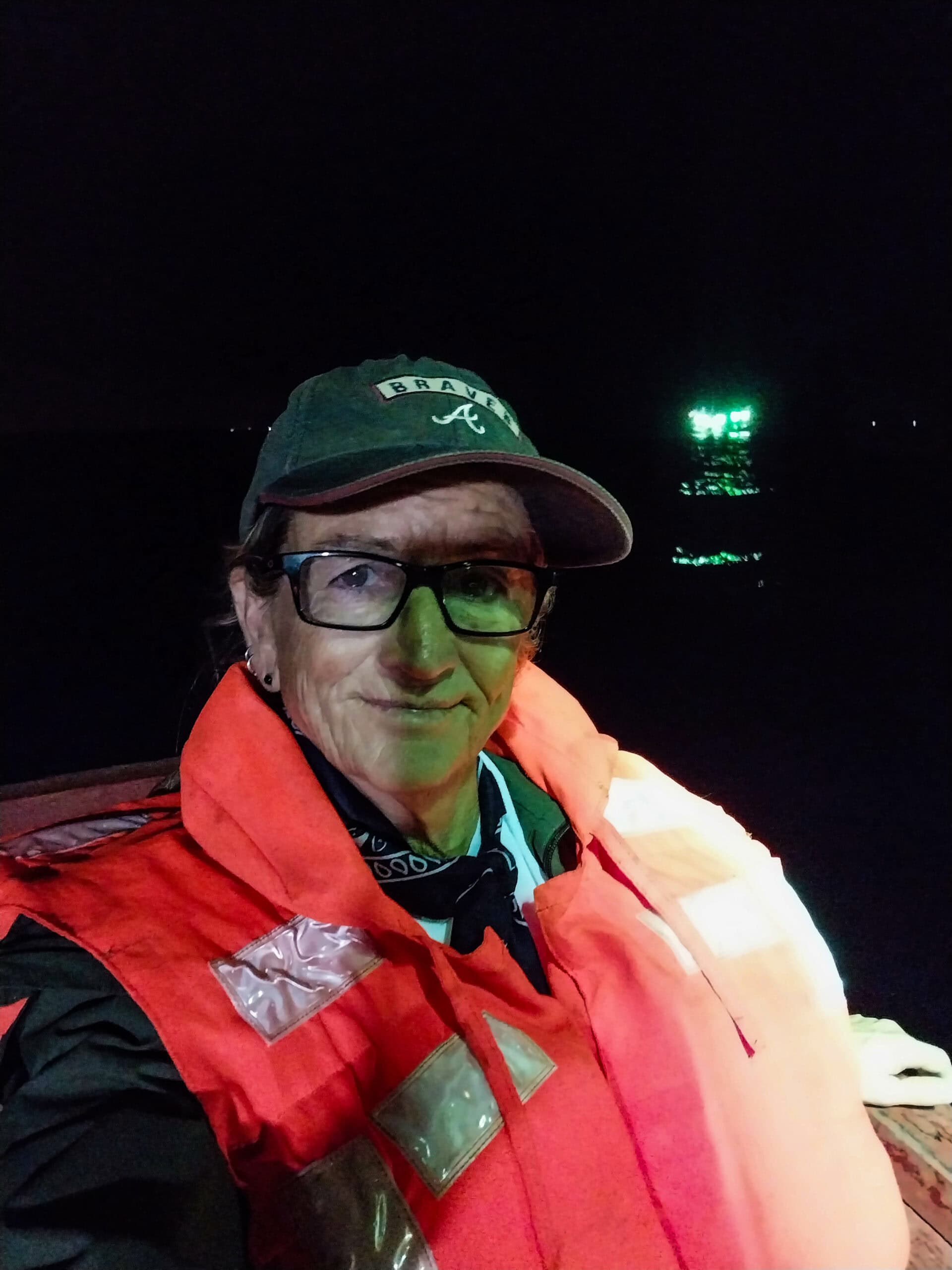
Happily, we returned to shore a bit earlier than expected, but the overall vibe was of contentment and savoring the experience. Would I want to do it again? Yes! Despite me picking apart a few things, it was a unique experience and one I wouldn’t soon forget.
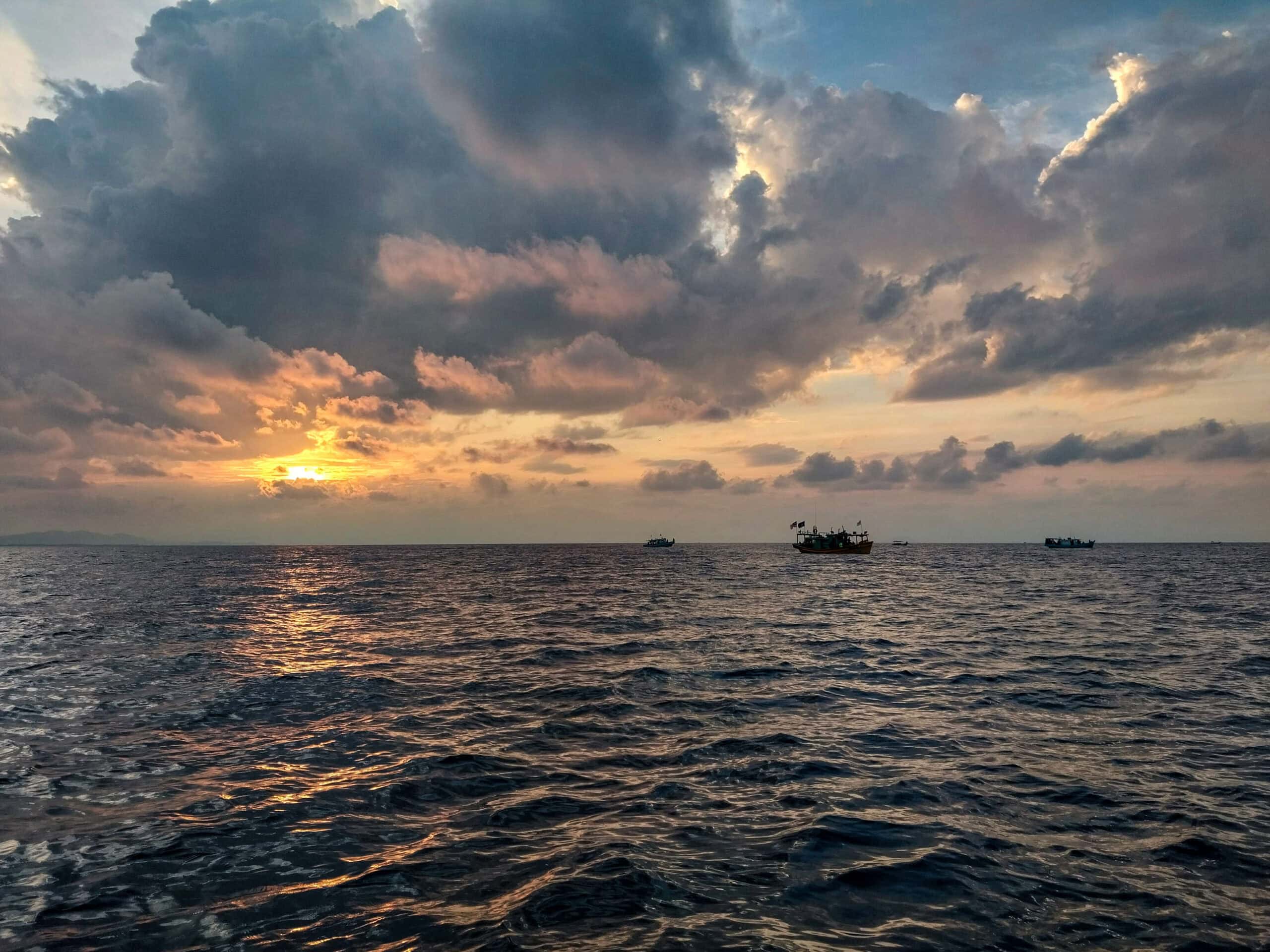
I didn’t catch any squid, but I did catch a beautiful sunset and a glimpse of a Terengganu tradition that’s rustic, real, and not for the faint of heart. If you have the opportunity to try this for yourself, I’d say go for it!
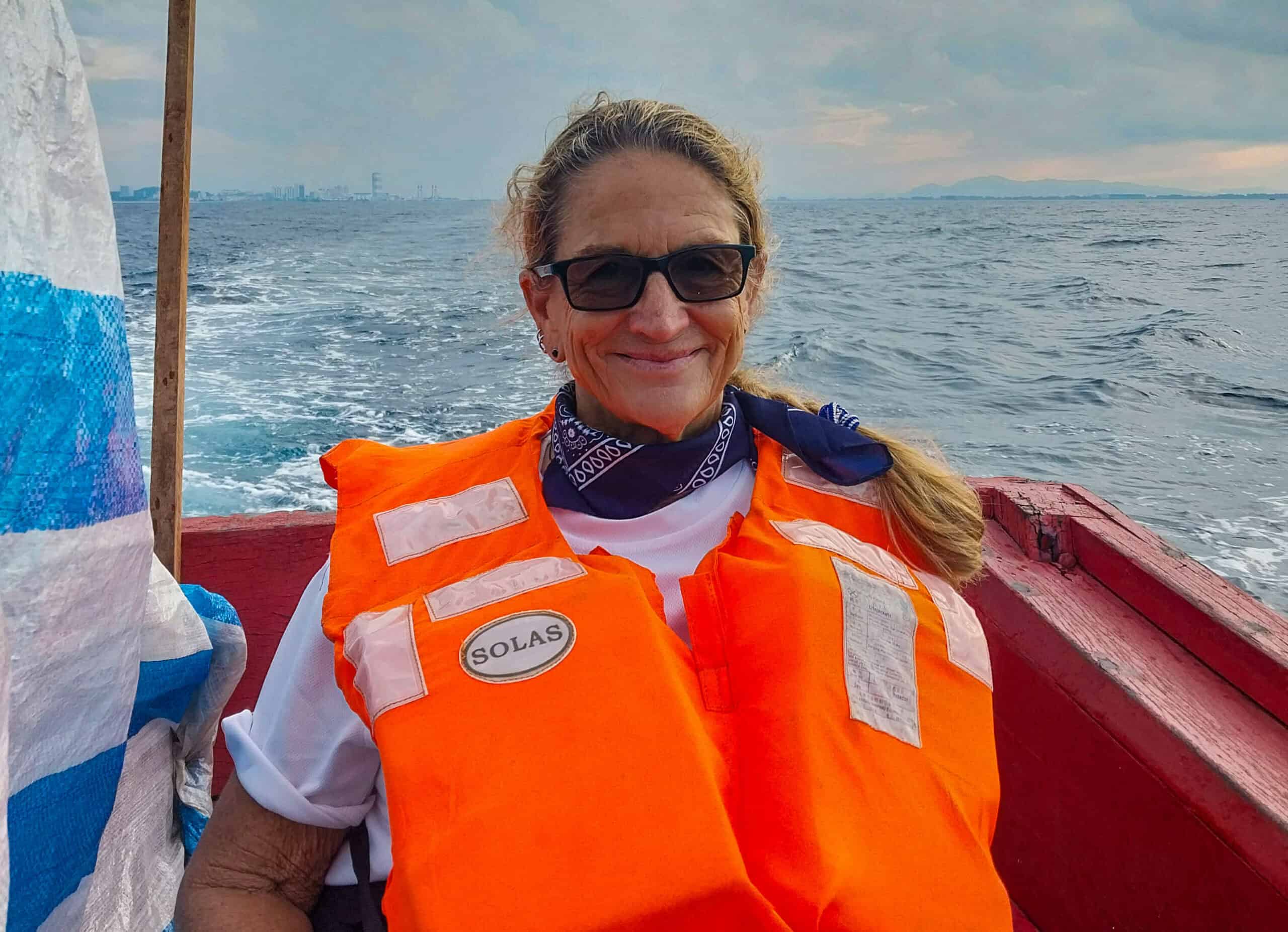
Thinking of Trying Terengganu Squid Jigging for Yourself?
March to August is the best time for squid jigging in Terengganu, but if you’re aiming for the annual Candat Sotong Festival, check in with Tourism Malaysia or Gaya Travel for the actual dates. You can also contact Jasa Teratai Holidays for seasonal tour options, at +6019-380 5754/ +6019-230 2333. Be prepared, pack smart, and bring a good sense of humor, especially if you’re not used to rustic boat life! For a few squid jigging in Terengganu tips: Squid, Sea Legs & Salty Boats: A Real Candat Sotong Experience

Eating Our Way Through Kuala Terengganu
After our night on the high seas, we spent the next two days doing a lot of eating and sightseeing. Kuala Terengganu has more to see and do than I remember, that’s for sure. First, we had another run through of the Karnival Candat Sotong’s last day and got to taste test many sotong dishes in a Pertima sponsored Sotong Cooking Contest. The Ketupat (or Tupat) Sotong was a definite standout, popular too! I also learned that sotong has many delicious possibilities (beyond fried calamari) when prepared with creativity and culinary talent.
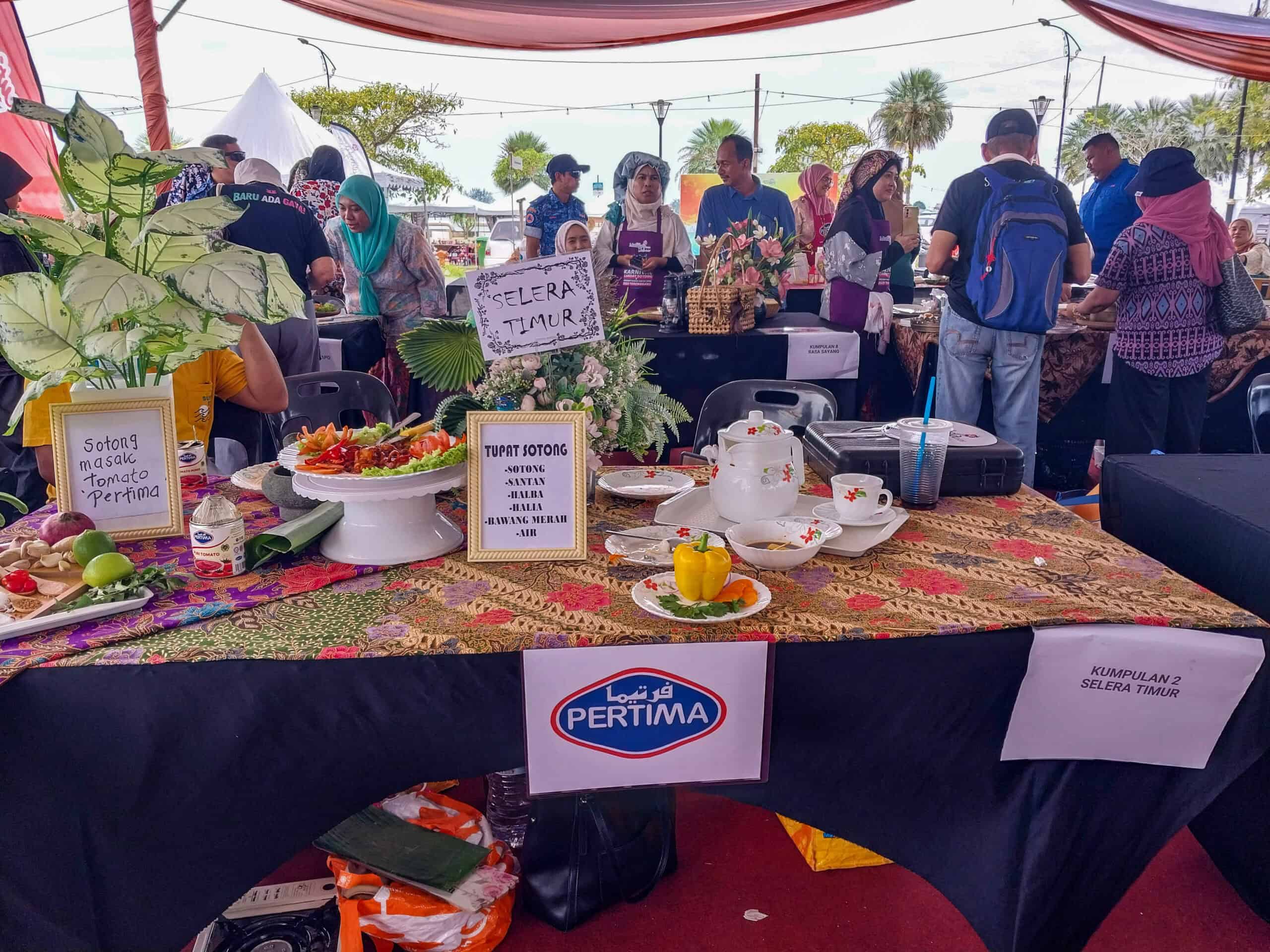
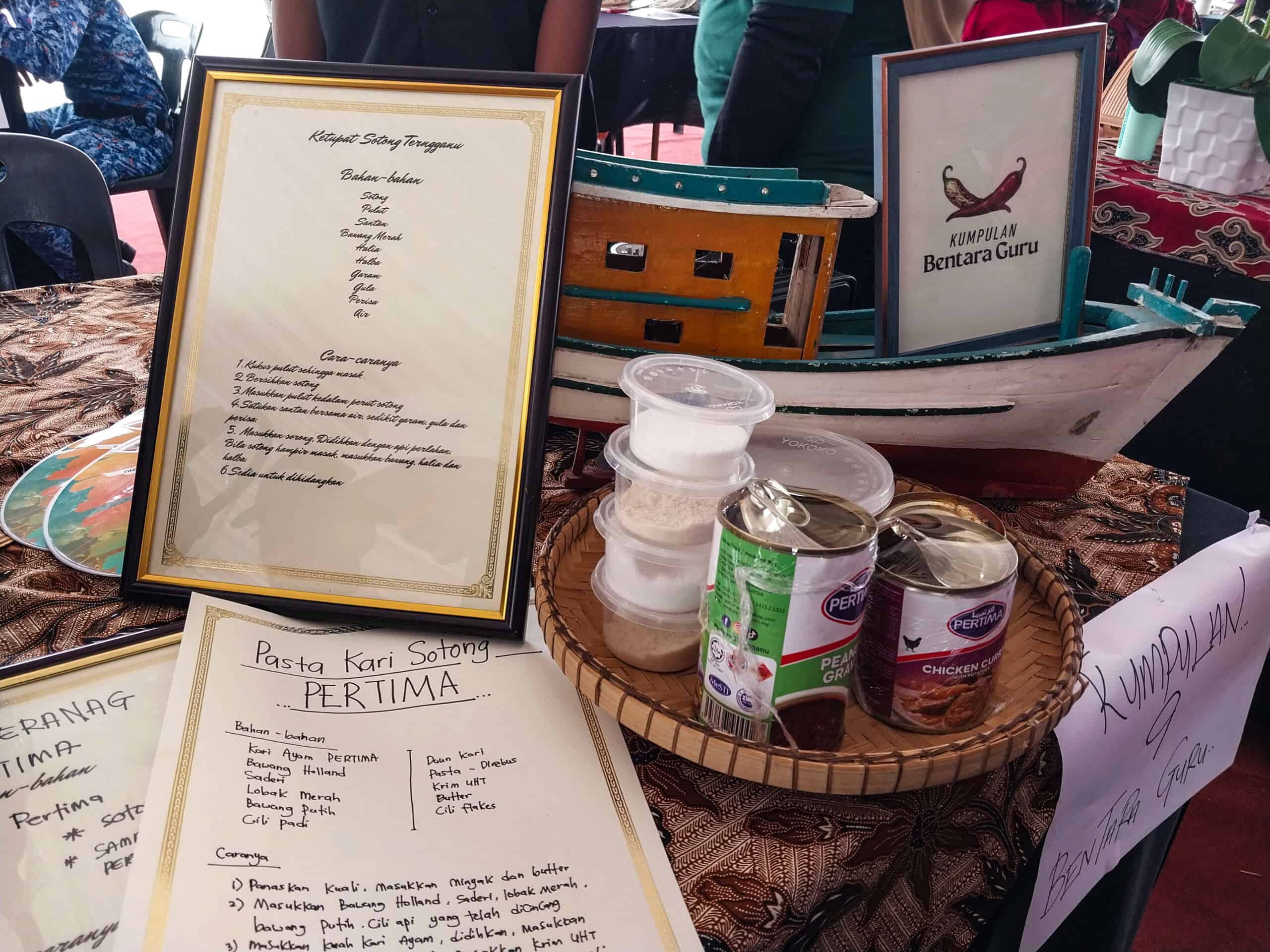
I have to say, the food scene in Kuala Terengganu was consistently inspiring. From festival bites to delicious local restaurant meals at Singgang Budu, D’Suasana Ibai and Warung Dalam Kenangan, everything was authentic, beautifully presented, and made with fresh ingredients.
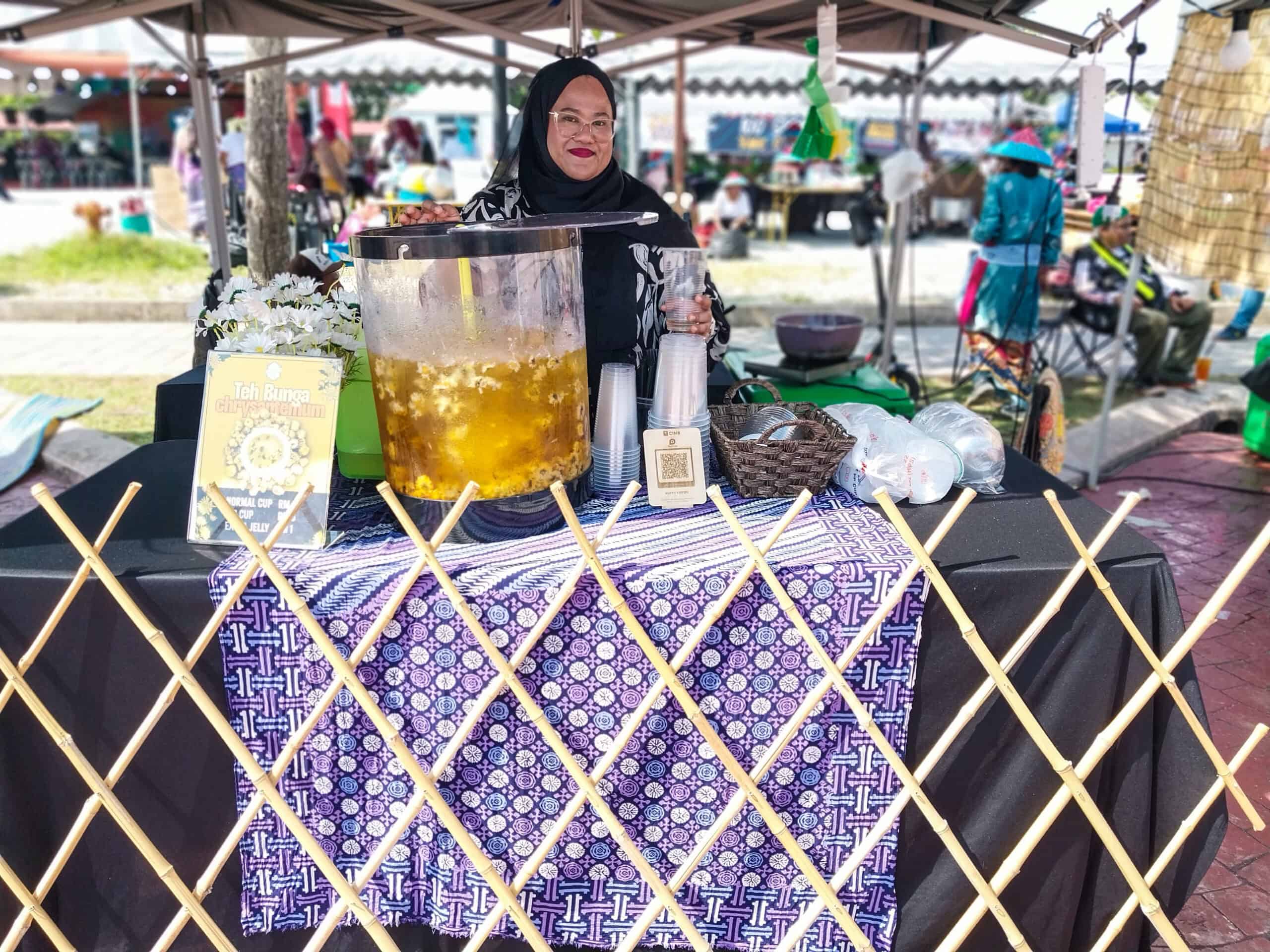
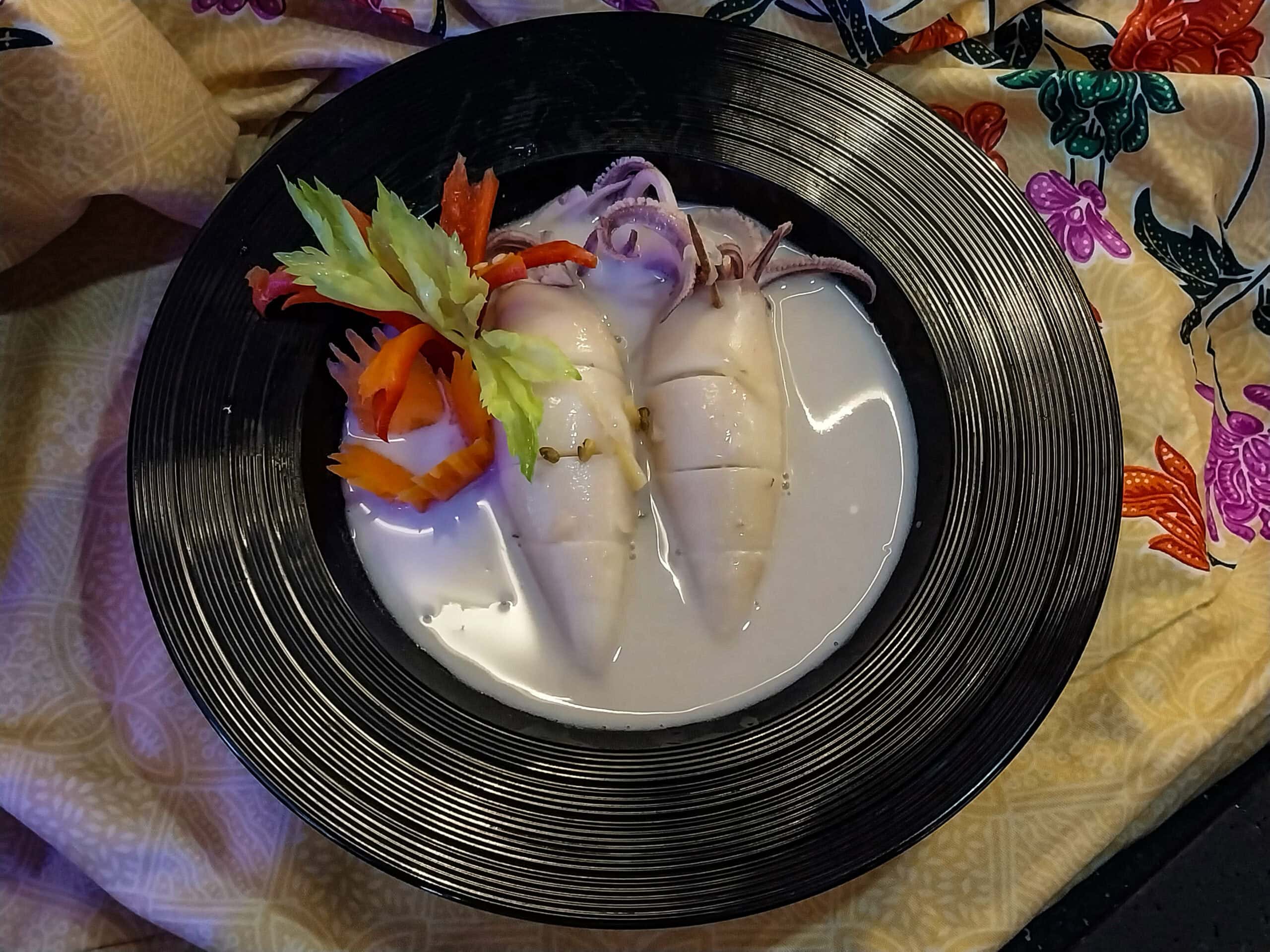
What really stood out was the focus on traditional flavors rather than generic Western fare. It was a refreshing contrast to the growing trend of new-wave cafes and fancy coffee spots popping up all over Malaysia. Eating like a local is part of the adventure for me, and Terengganu absolutely delivered on that front.
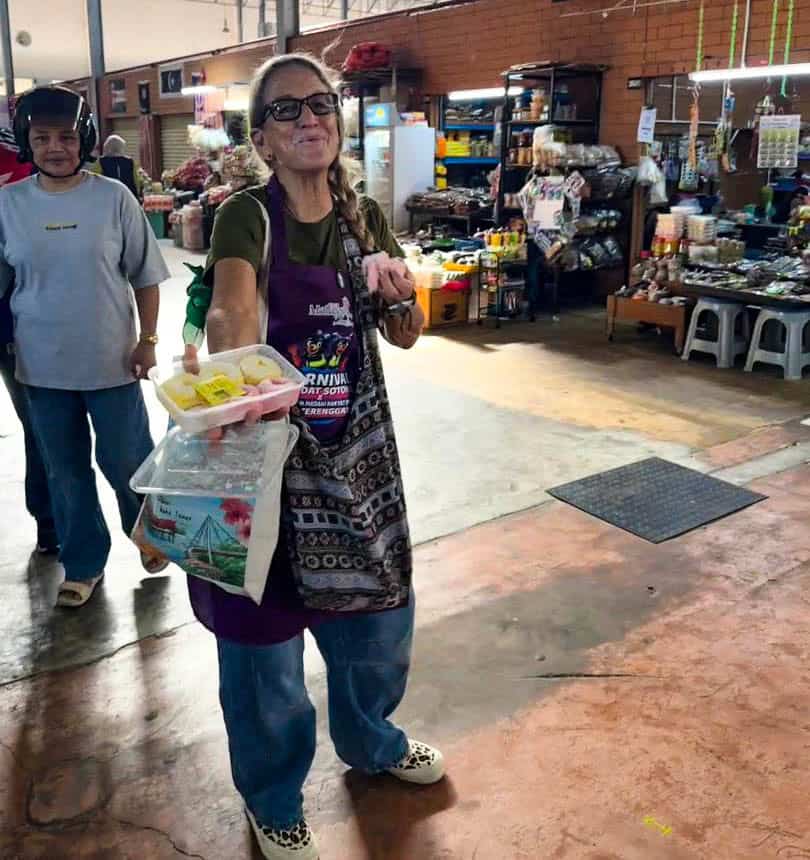
Sightseeing Highlights Around Kuala Terengganu
Of course, no media trip would be complete without the full itinerary treatment. It’s safe to say that Kuala Terengganu has plenty of interesting nooks and crannies to explore, but with limited time and our group’s main focus on the Karnival Candat Sotong and squid jigging, we only saw a few of Kuala Terengganu’s sights. But what we did see was mention-worthy. Here’s a quick peek of what else we saw (and ate).
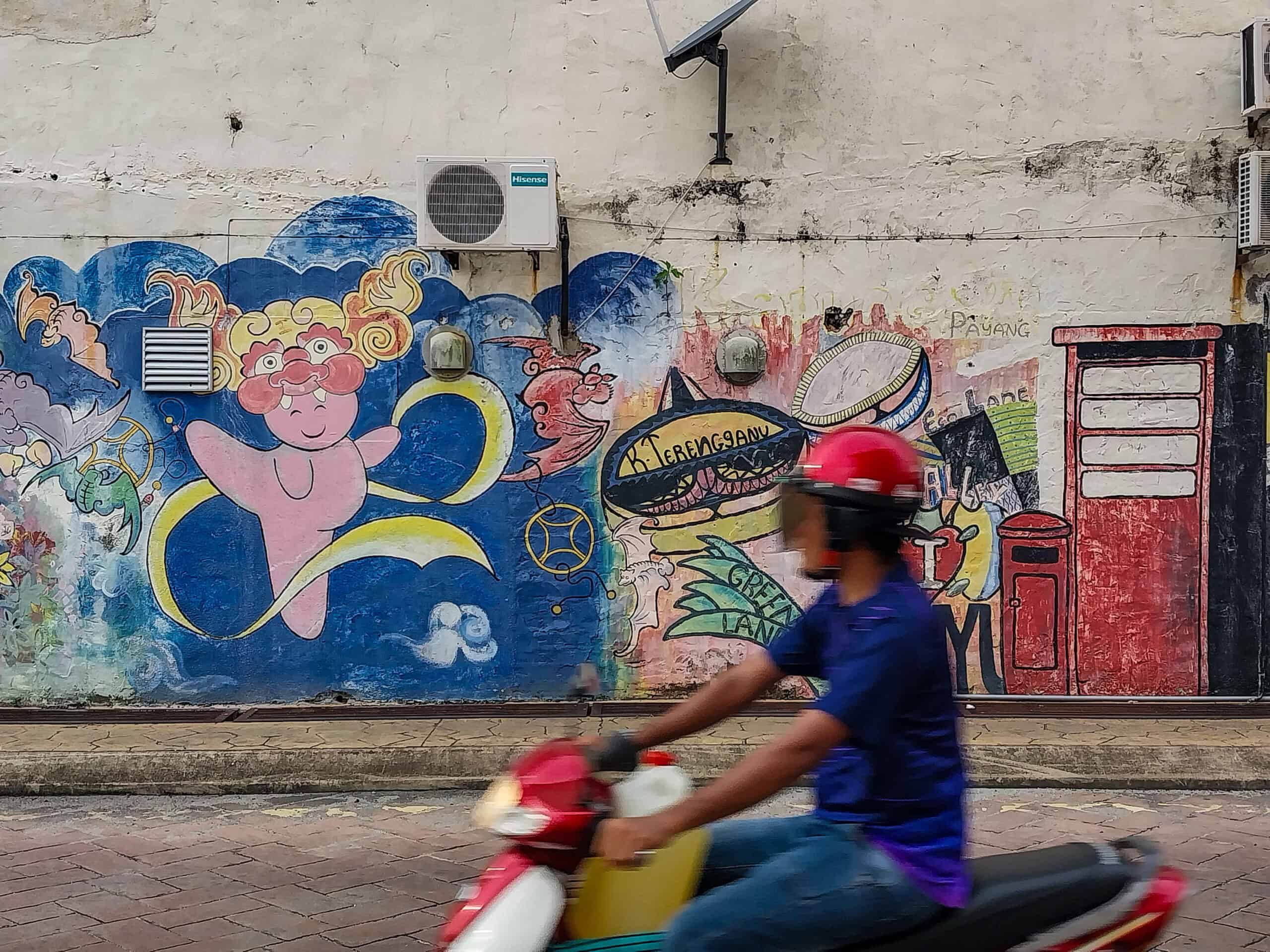
Kuala Terengganu Drawbridge: Although our scheduled tour of the Kuala Terengganu Drawbridge was canceled, we still caught great views both from a distance and while passing beneath it on our sotong boats. Officially opened in 2019, this is Malaysia’s first drawbridge, connecting Muara Selatan to Muara Utara across the Terengganu River. Inspired by London’s Tower Bridge, it features four towers, a skybridge, commercial galleries, and a glass-floored observation deck. By night, it even glows with special LED lighting and has become one of the city’s most iconic landmarks (day or night). Kuala Terengganu Drawbridge/ Open Mon–Thurs: 10am–7pm, Fri–Sun: 10am–10pm (closed Fri 12:30–2:30pm)/ RM15 Adults, RM10 Kids/Seniors
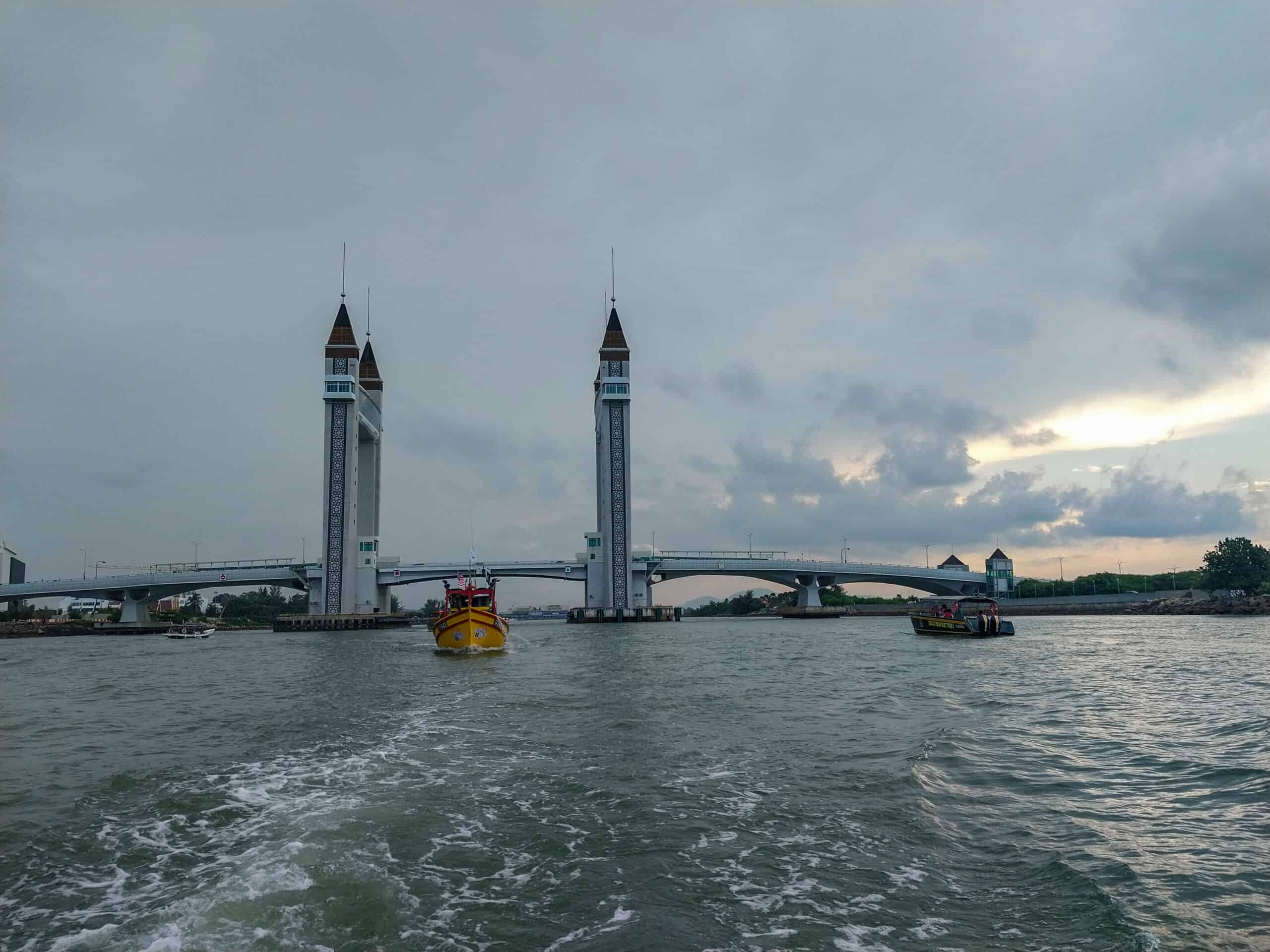
Masjid Tengku Tengah Zaharah: We visited the Floating Mosque (Masjid Tengku Tengah Zaharah), which appears to be floating on a small lagoon part of the Kuala Ibai River during high tide. Completed in 1995, it was Malaysia’s first mosque built over water and features a blend of Moorish and modern design, with white domes and a tall minaret. It’s not an especially attractive mosque (in my opinion), but the surrounding waterfront landscape is lovely. Modestly dressed non-Muslim visitors are welcome to enter, which was a pleasant surprise. Modest attire is also available at the entrance, free of charge. Tengku Tengah Zaharah Mosque/ Open daily: 5am-9:30pm
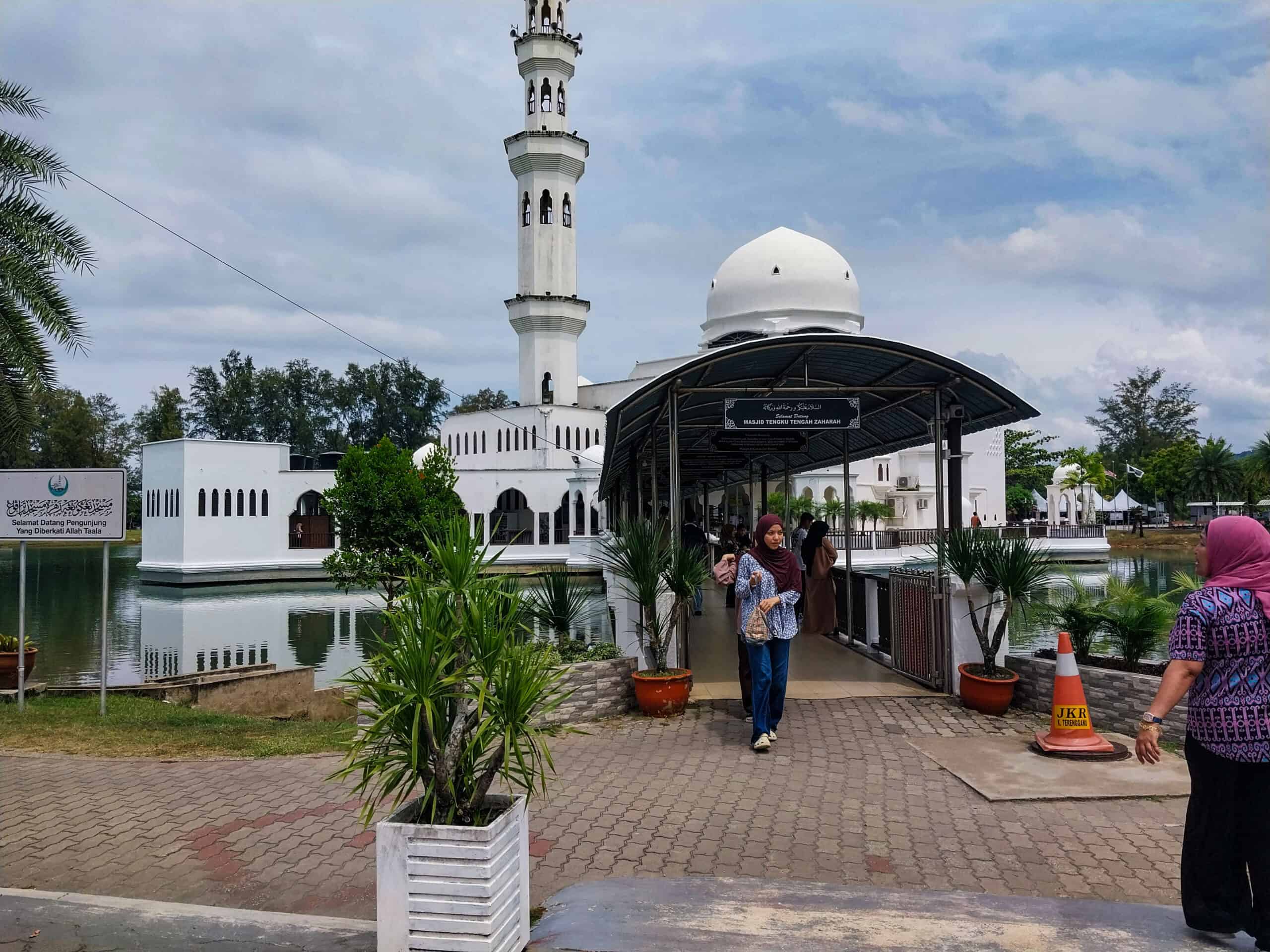
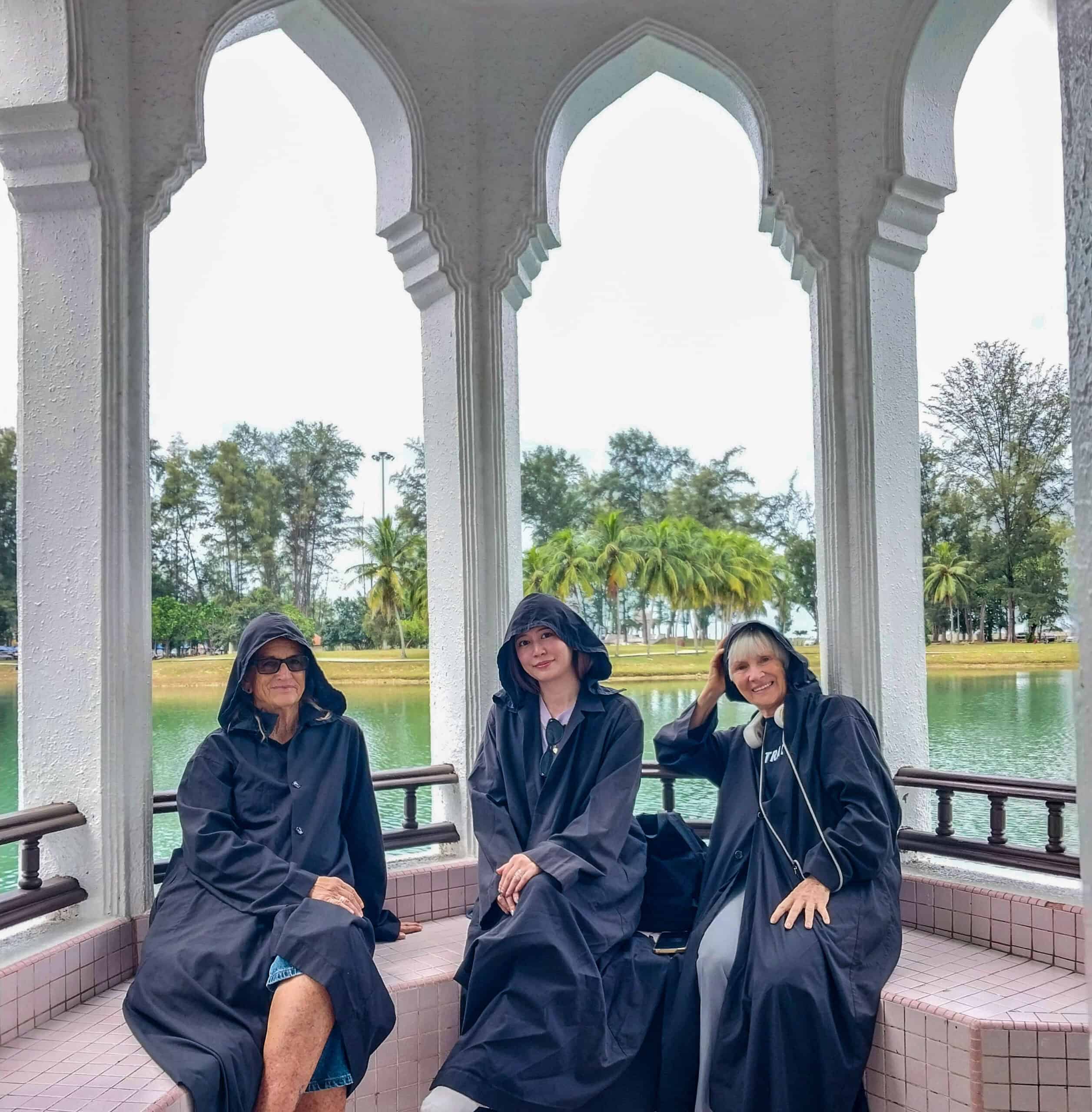
Kampung Cina: Next, we explored Kampung Cina (Chinatown), a small but colorful heritage district filled with 19th-century shophouses, ancestral temples, and a mix of Chinese, Peranakan, and Malay influences. Chinese traders first settled here in the 1700s, and much of its present-day appearance still reflects that history. It was a bit surprising, considering Terengganu had always felt predominantly Muslim to me. But again, this return trip offered plenty of eye-opening moments. Kampung Cina/ Jalan Kampung Cina
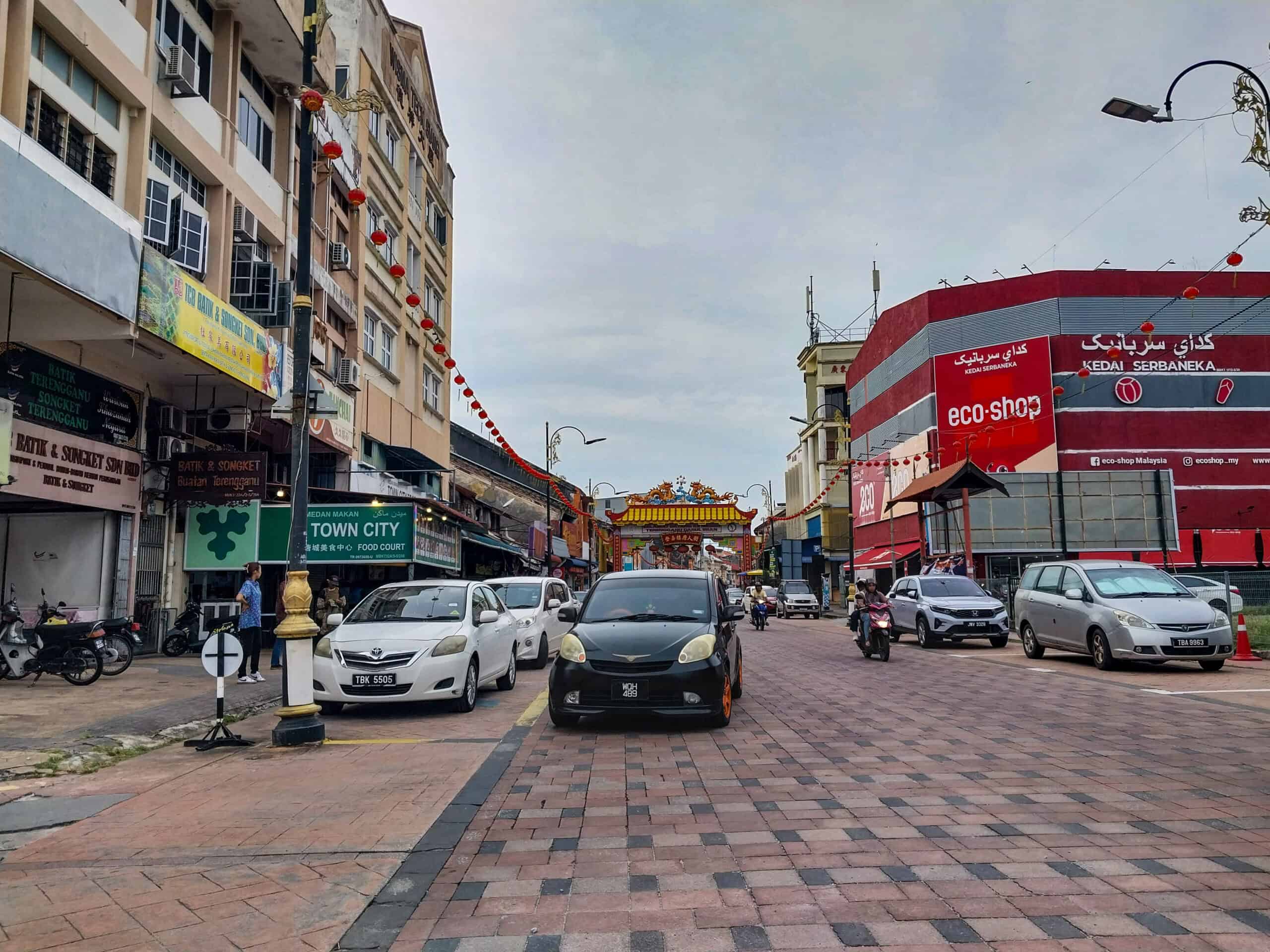
Turtle Alley: Likely due to its long, mostly uninterrupted coastline, Terengganu is one of the top nesting areas for Malaysia’s turtle population. I had read about Turtle Alley years ago, so seeing it in person was a real treat. Located just off Jalan Kampung Cina in Chinatown, Turtle Alley is a narrow pedestrian lane decorated with sea turtle–themed mosaics, small bronze sculptures, and conservation messages.
It was launched in 2010 by the Turtle Conservation Society and local volunteers to highlight the threats facing Terengganu’s turtle populations; particularly green and Leatherback turtles that nest along the coast. It’s colorful, creative, and well-marked, so it’s hard to miss. It’s also informative and full of good photo ops. Turtle Alley/ Jalan Kampung Cina/ Open daily
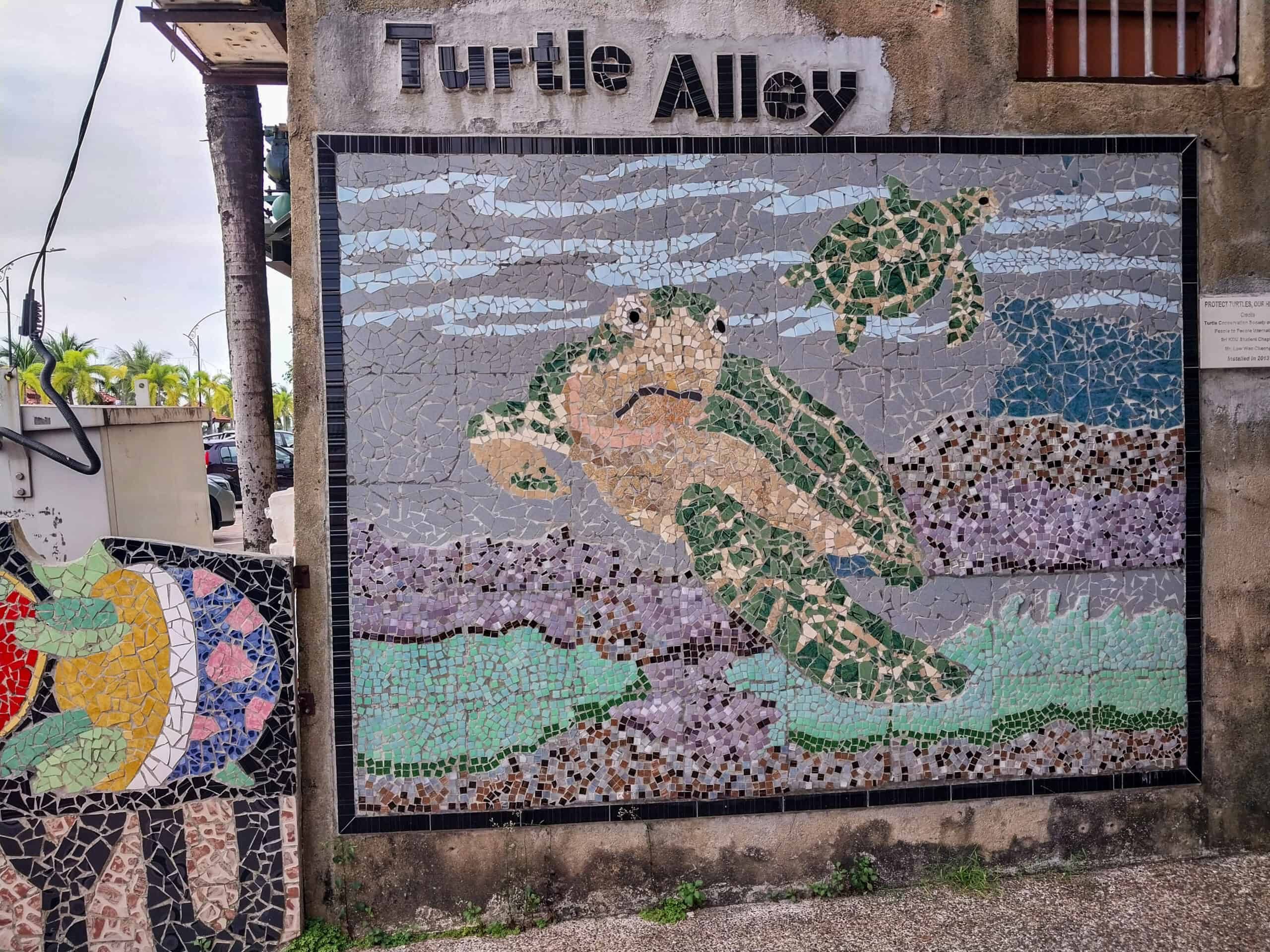
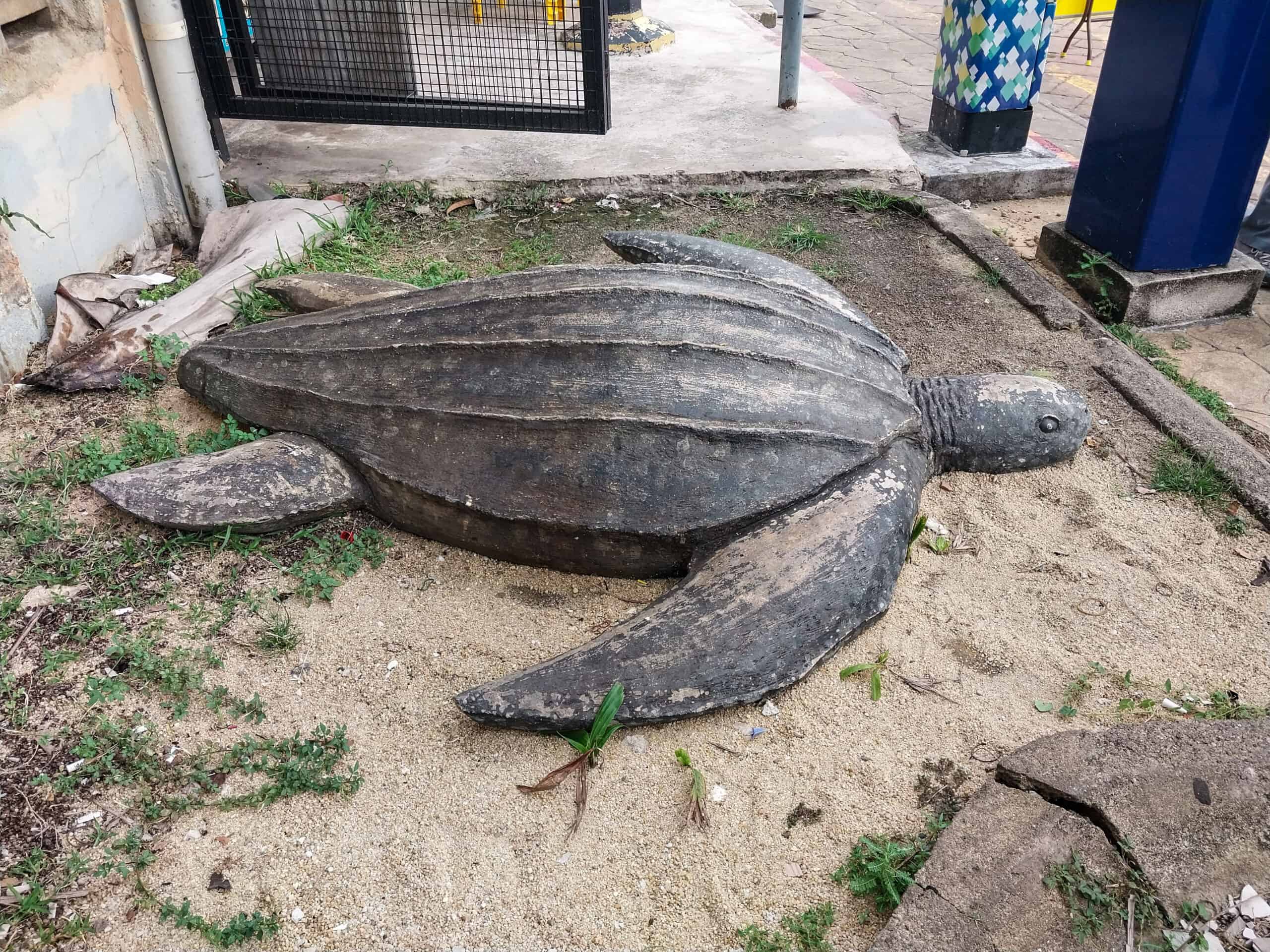
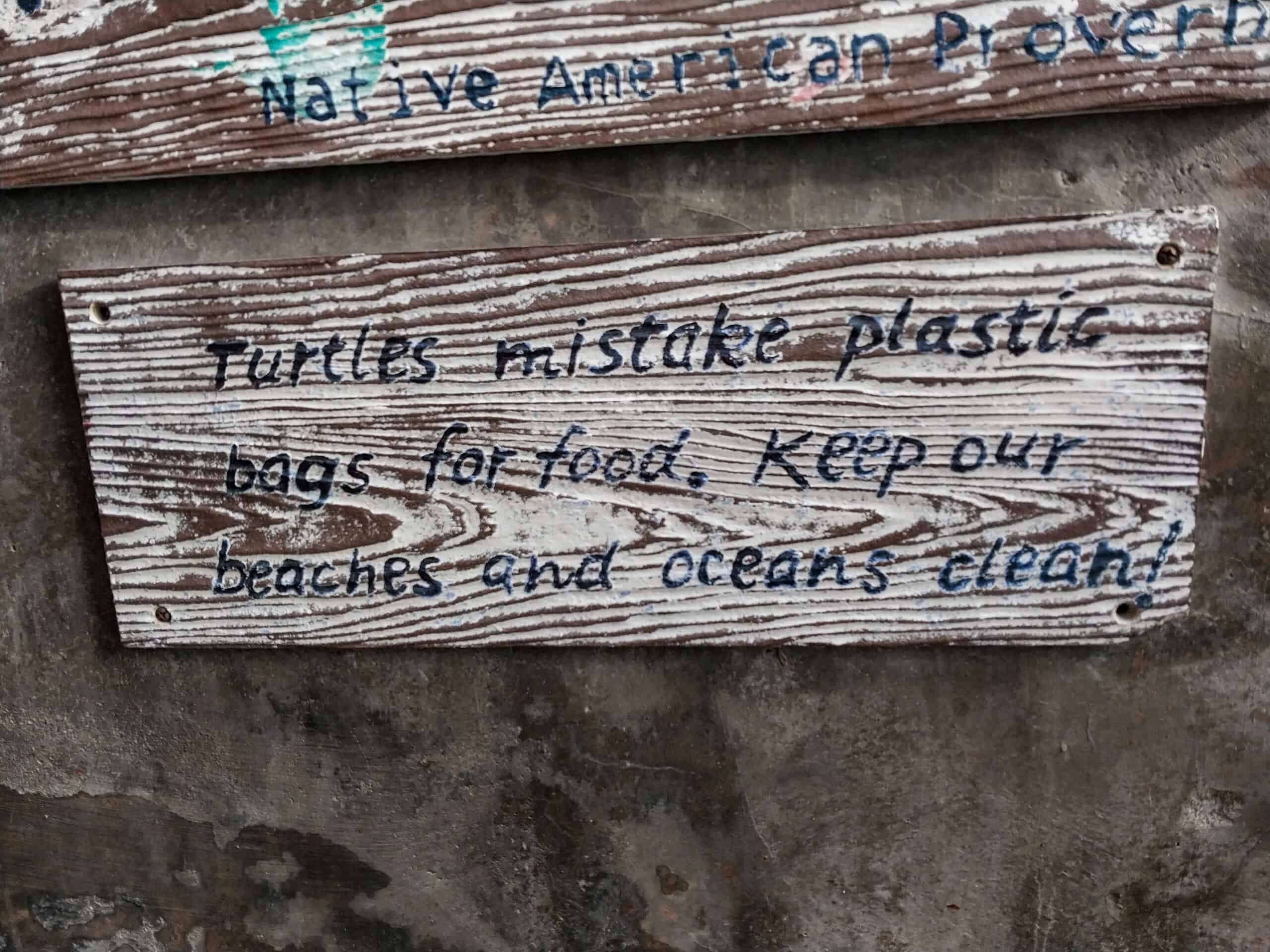
Uptown Pulau Warisan Night Market: Just across the bridge closest to Turtle Alley, is the Uptown Pulau Warisan Night Market, located along the waterfront. It was fairly quiet when we visited in the late afternoon, but I imagine it gets busier after sunset. There was a good mix of stalls selling food, clothing, batik, and collectibles. I even bought a rainbow cheese sandwich, something I’d only ever seen on Facebook. Maybe a bit silly to some, but I got a kick out of it. Worth a stop if you’re in the area. Uptown Pulau Warisan Night Market/ Jalan Kampung Cina/ Open Sat-Thurs: 5pm-12am
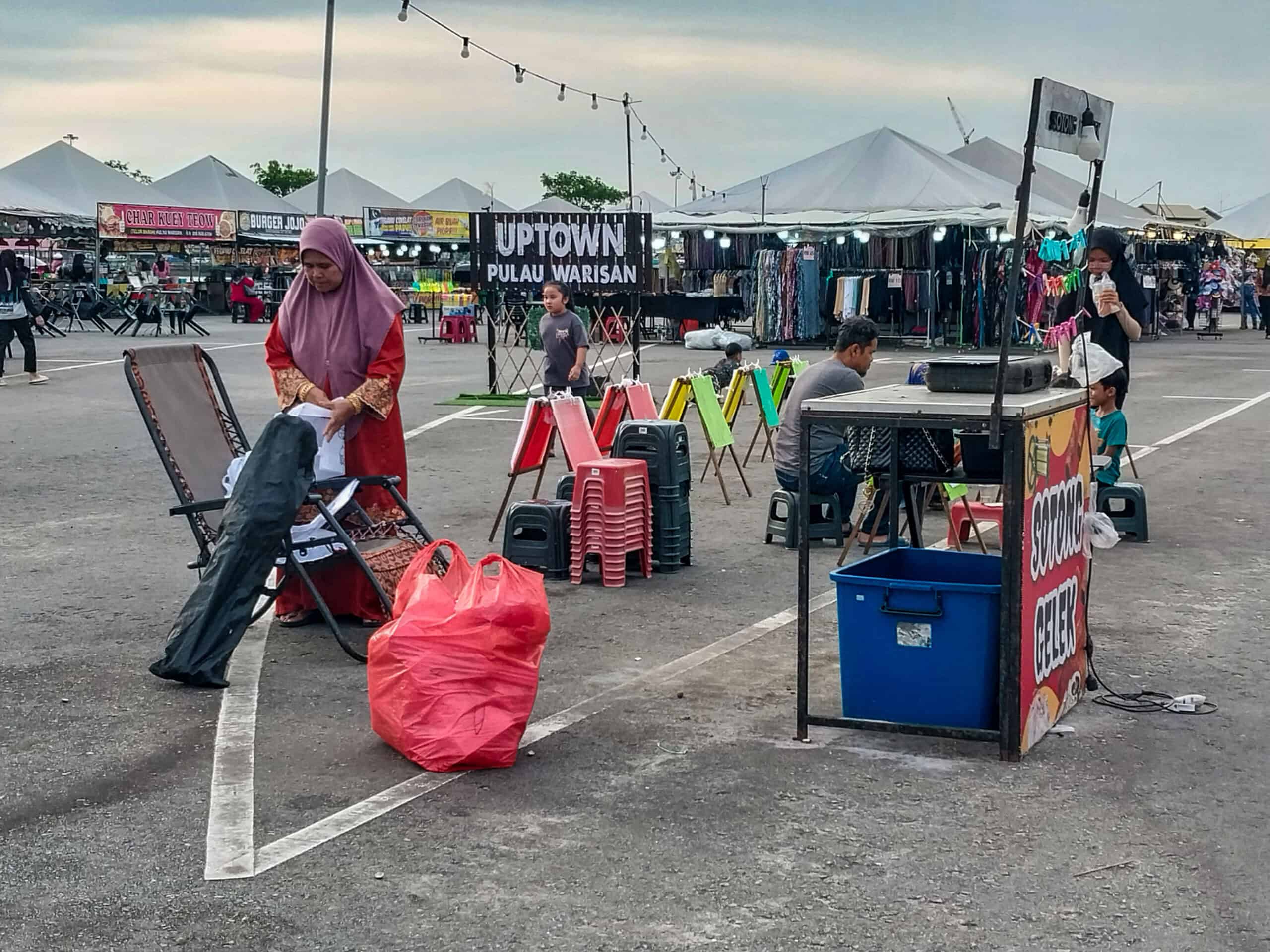
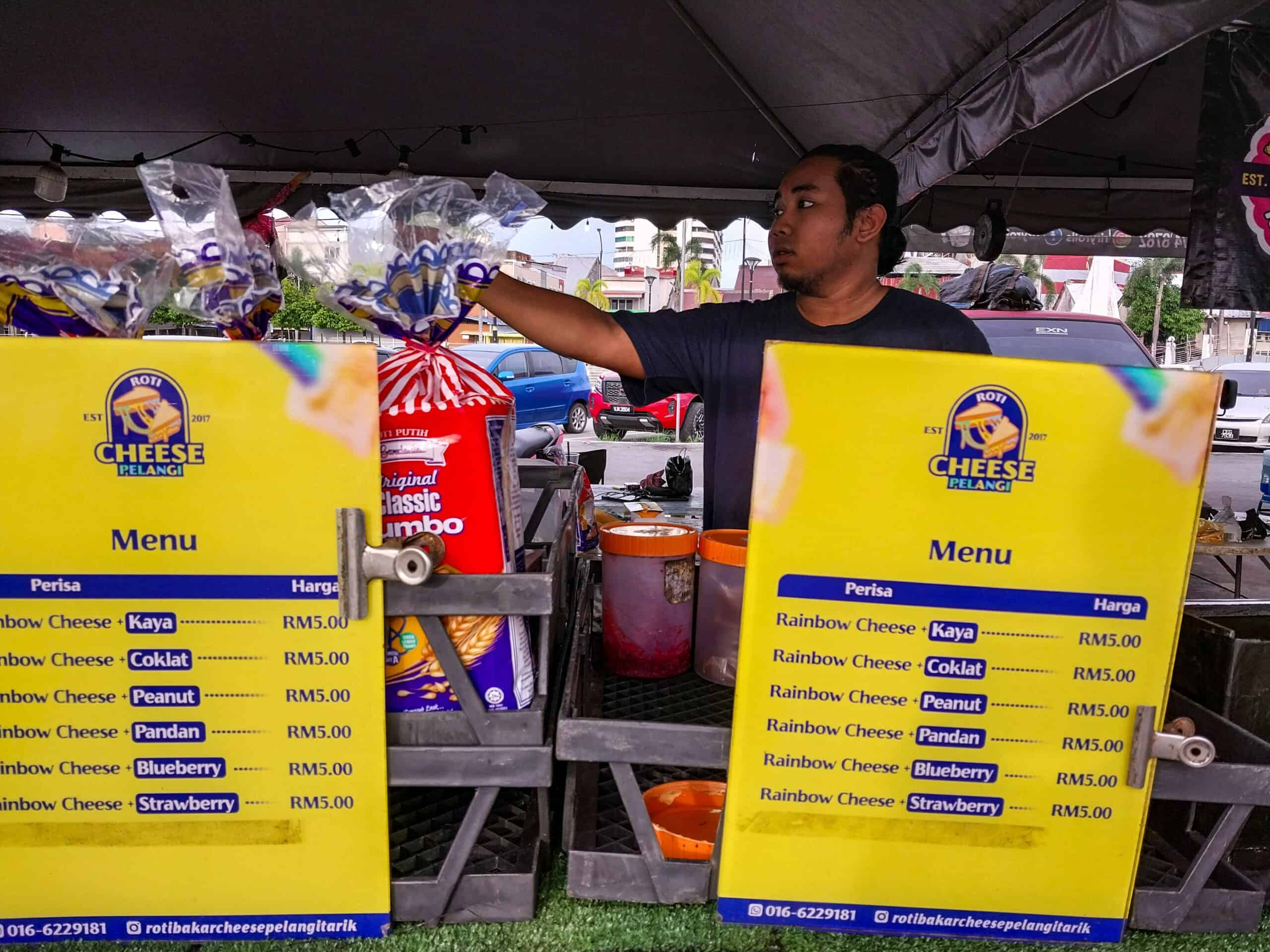
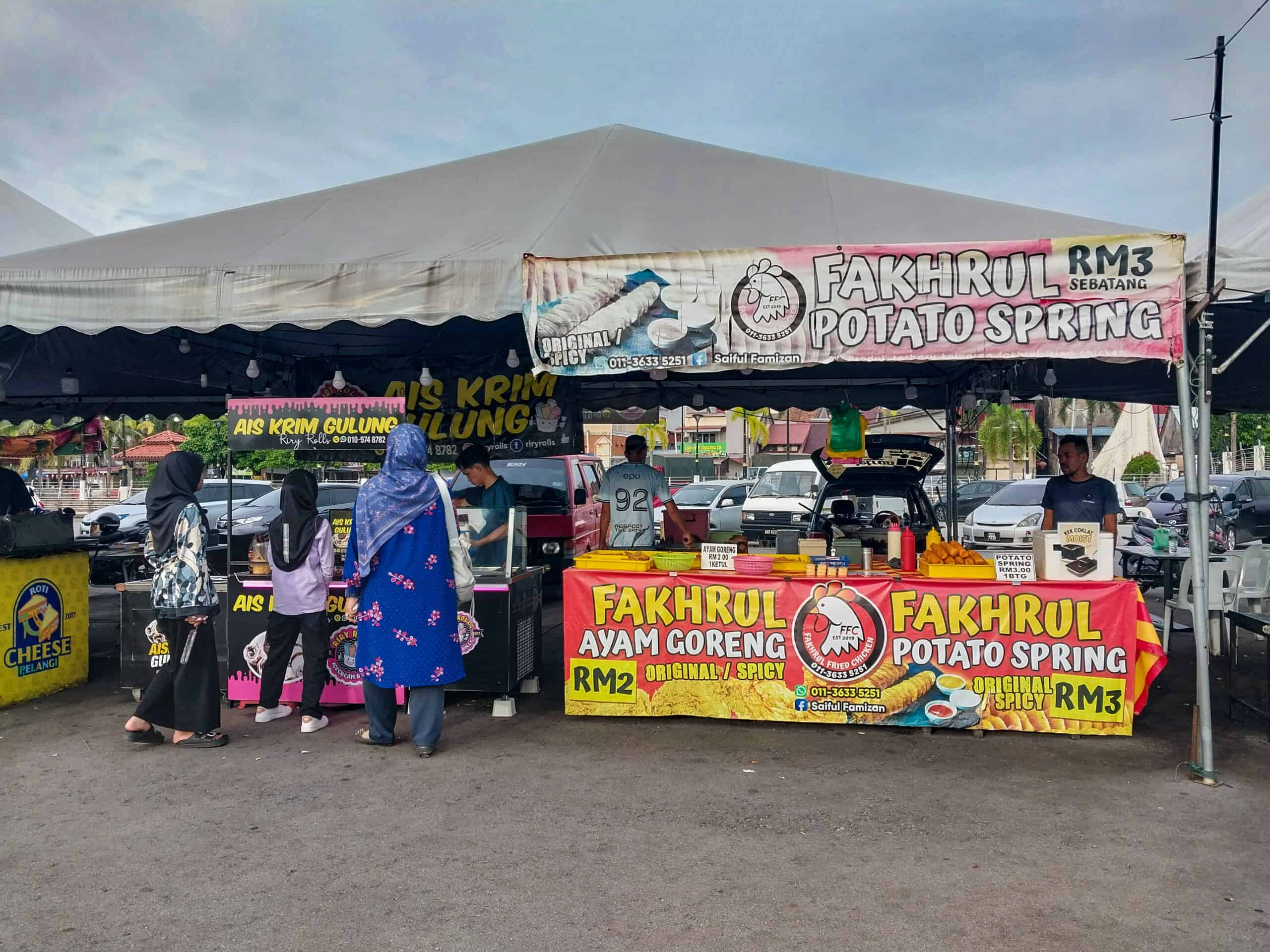
Ho Ann Kiong Temple: Also worth a visit is Ho Ann Kiong Temple, the oldest Taoist temple in the city. Built in 1801 by early Hokkien settlers, it has been rebuilt several times over the centuries due to fires and floods but remains an important place of worship for the local Chinese community. The exterior features traditional red pillars, tiled roofs, and intricate carvings, while the interior holds incense-filled altars and offerings. It’s still an active temple, so visitors should be respectful while there. It’s a quiet, low-key spot that offers a peek into the city’s long-standing Chinese heritage. Ho Ann Kiong Temple/ Jalan Kampung Cina/ Open daily
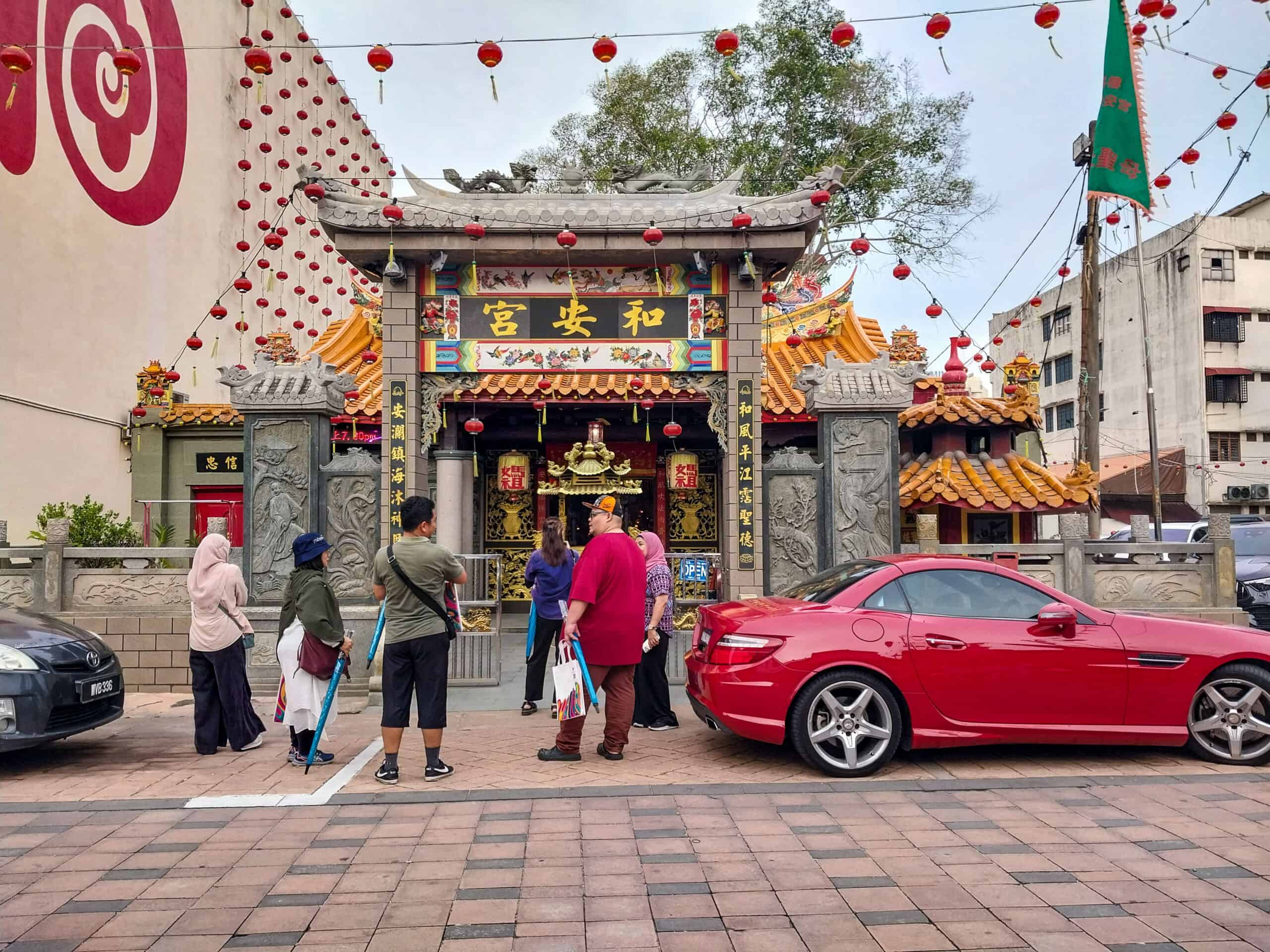
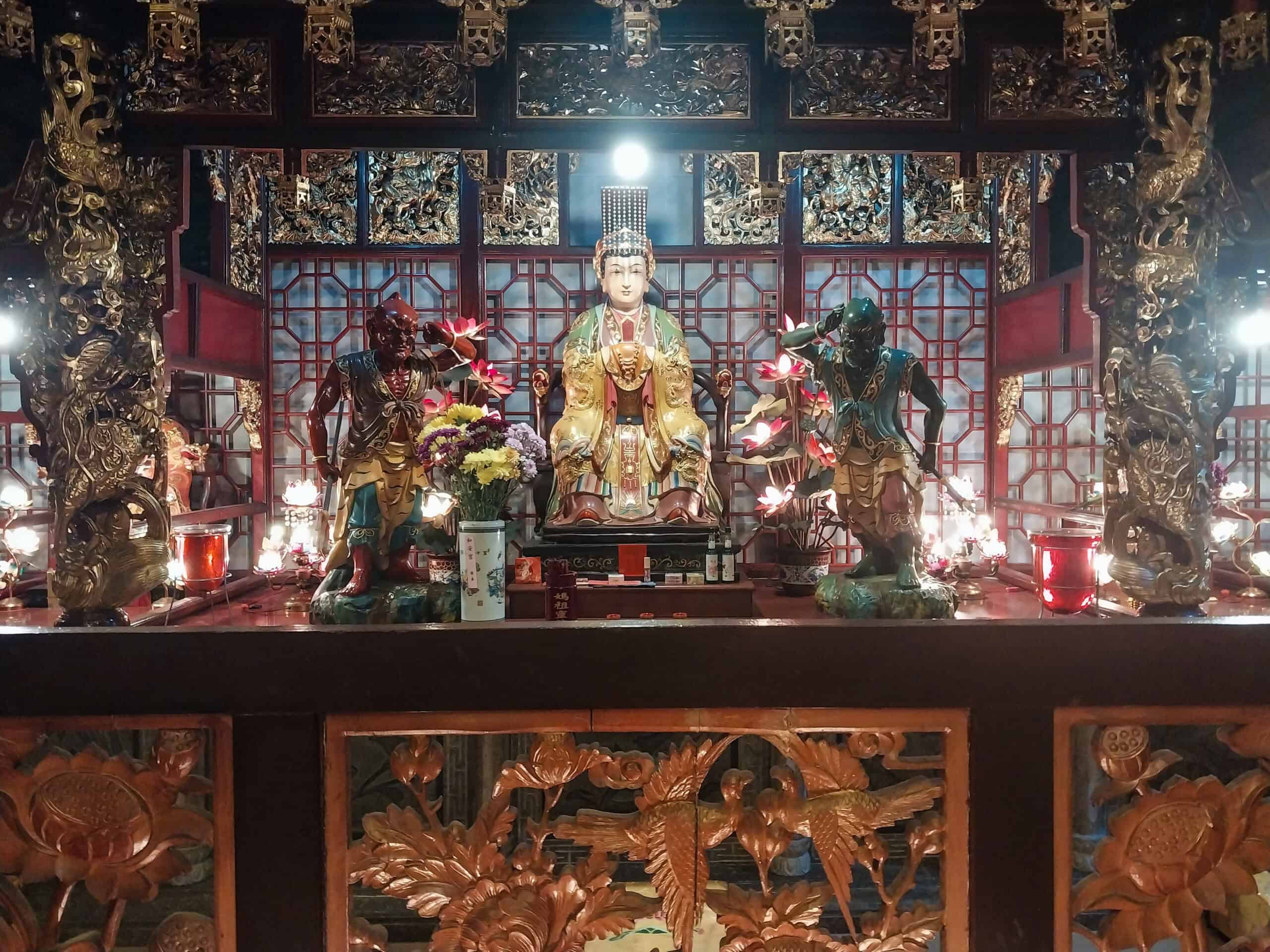
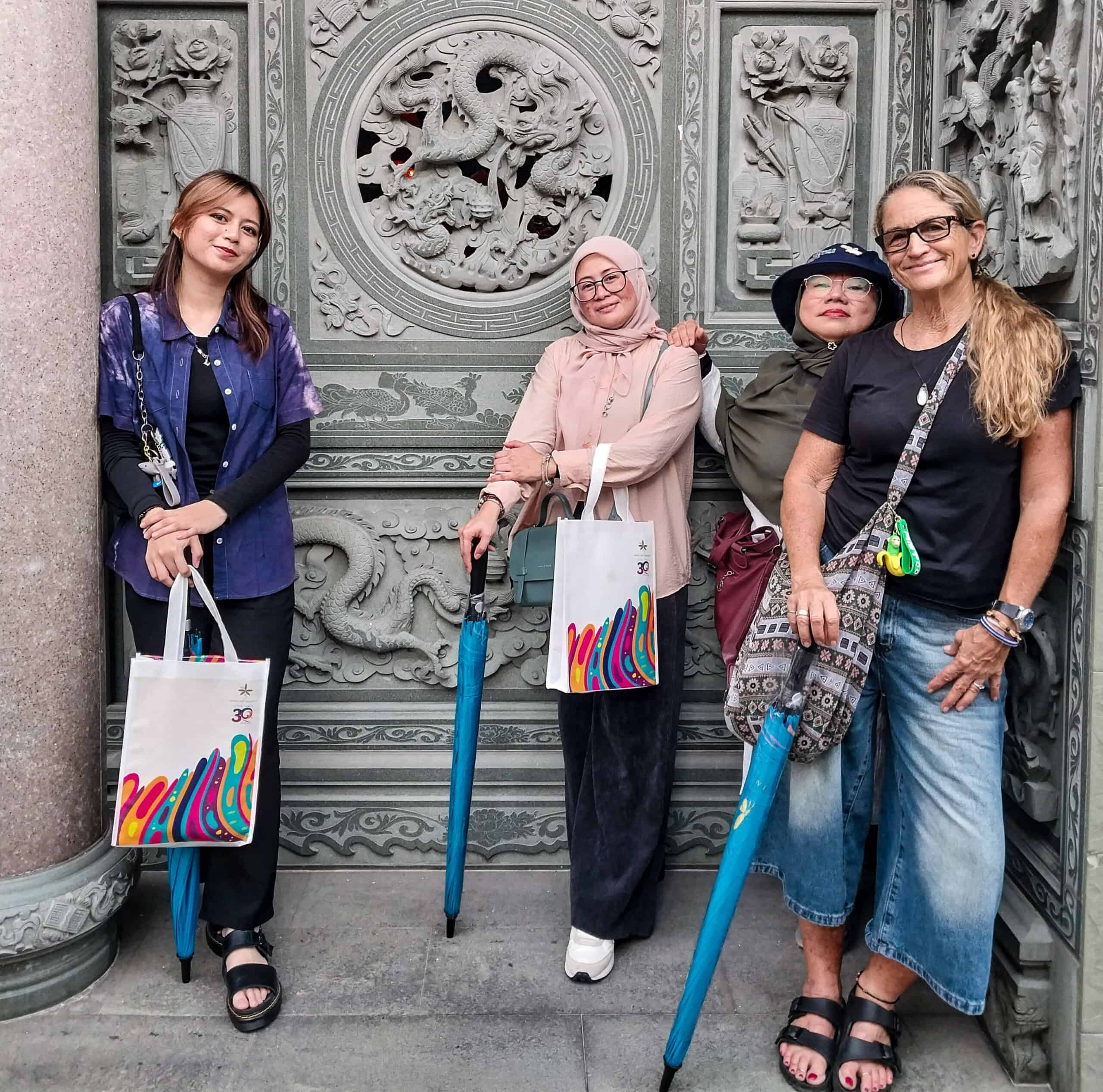
Noor Arfa Batik: On our way out of town, we stopped at Noor Arfa Batik in Chendering. The 2.5-acre complex houses over 70 batik brands, with working studios, live demos, and a large showroom. We watched artisans weave songket, and paint and stamp batik fabric by hand, tried a bit of DIY ourselves, and browsed the outlet for discounted pieces.
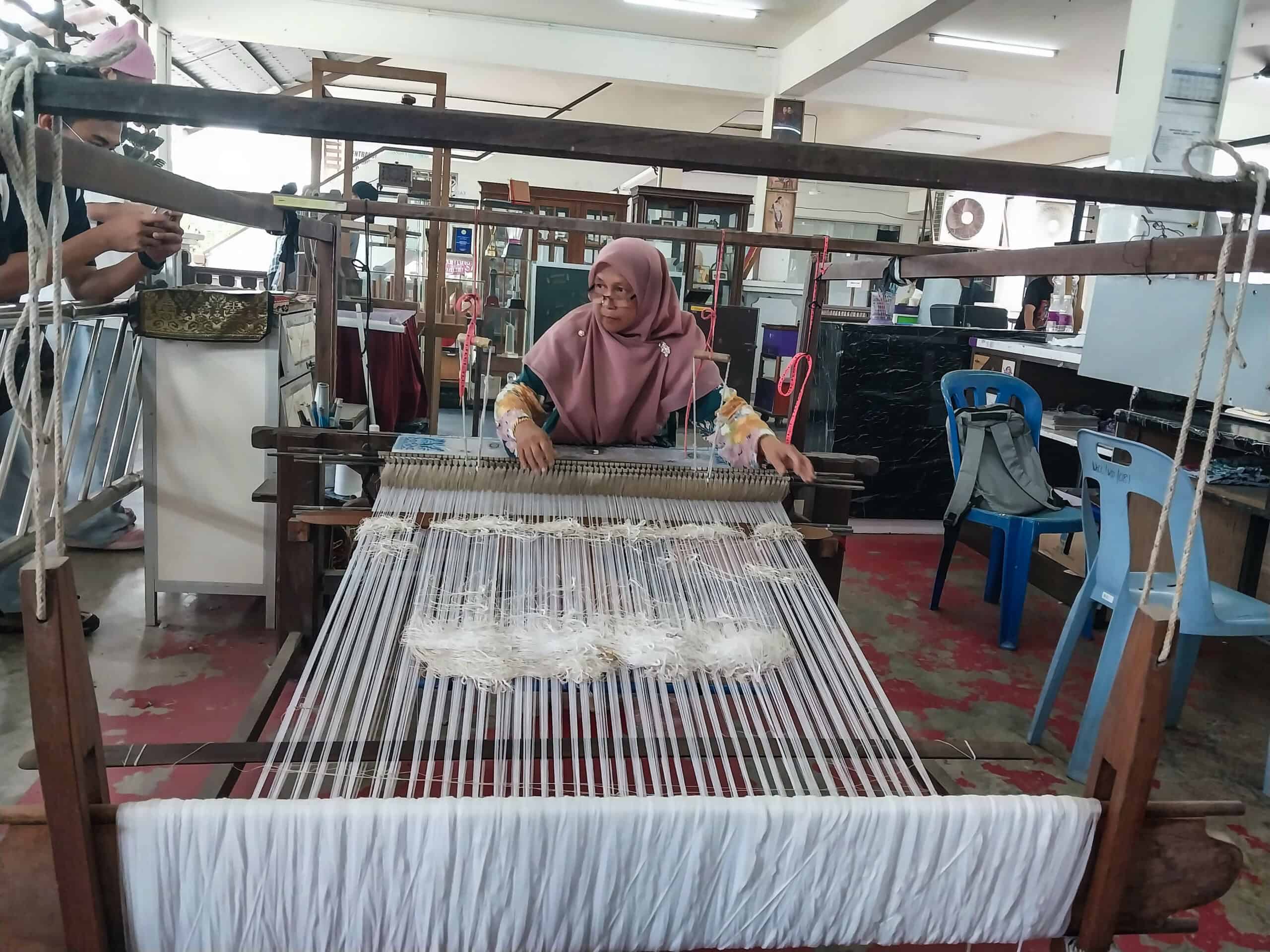
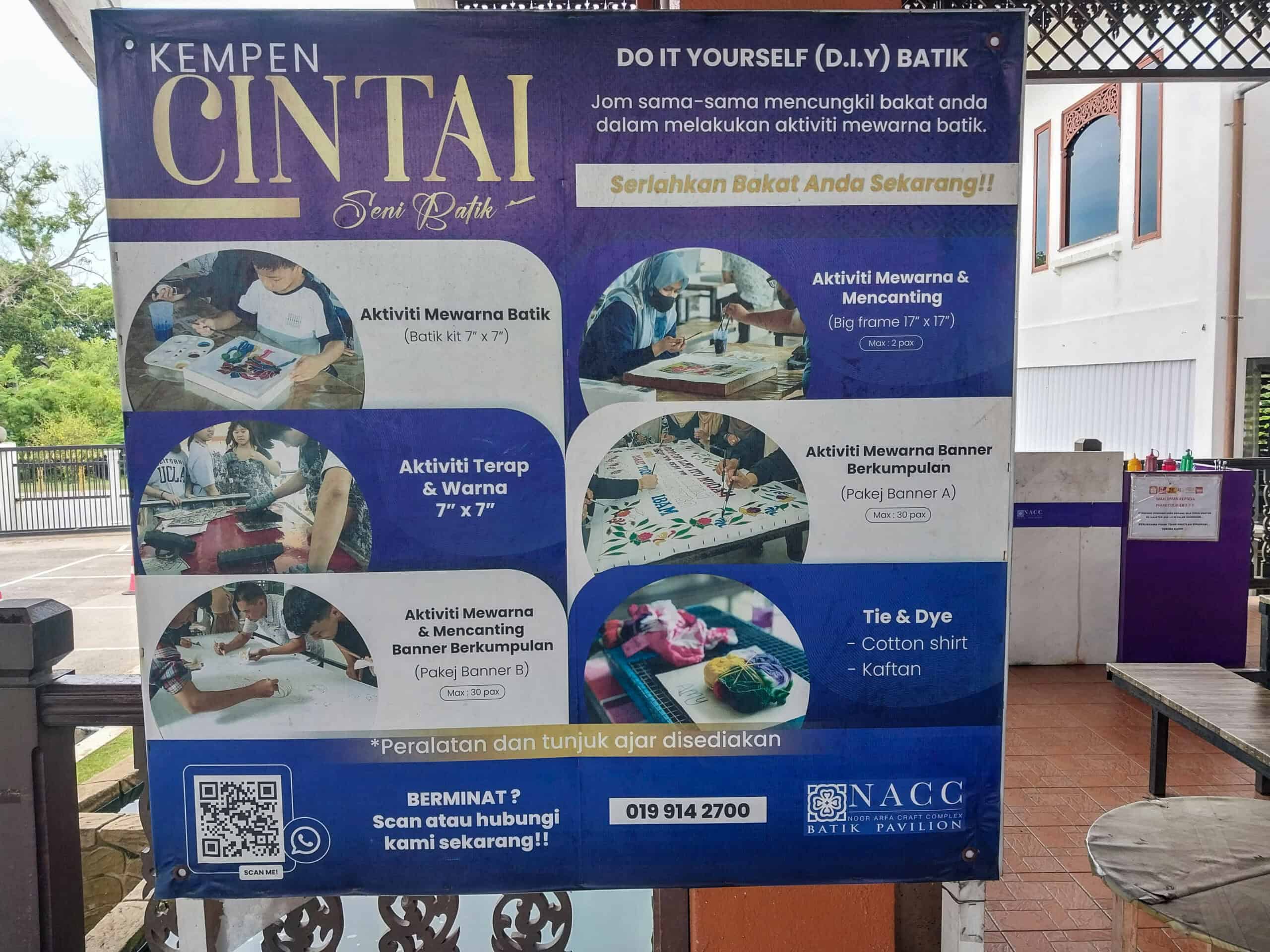
The batik and songket-making processes are detailed and time-consuming, which makes it easy to appreciate the craftsmanship behind even the simplest designs. There was also a glassblower on site creating delicate glass art, which is fascinating to watch. Definitely a worthwhile stop to see traditional textile-making in action and to pick up a unique, locally made souvenir. Noor Arfa Batik/ Kawasan Perindustrian Chendering/ Open daily: 8:30am-6pm (6:30pm on weekends)
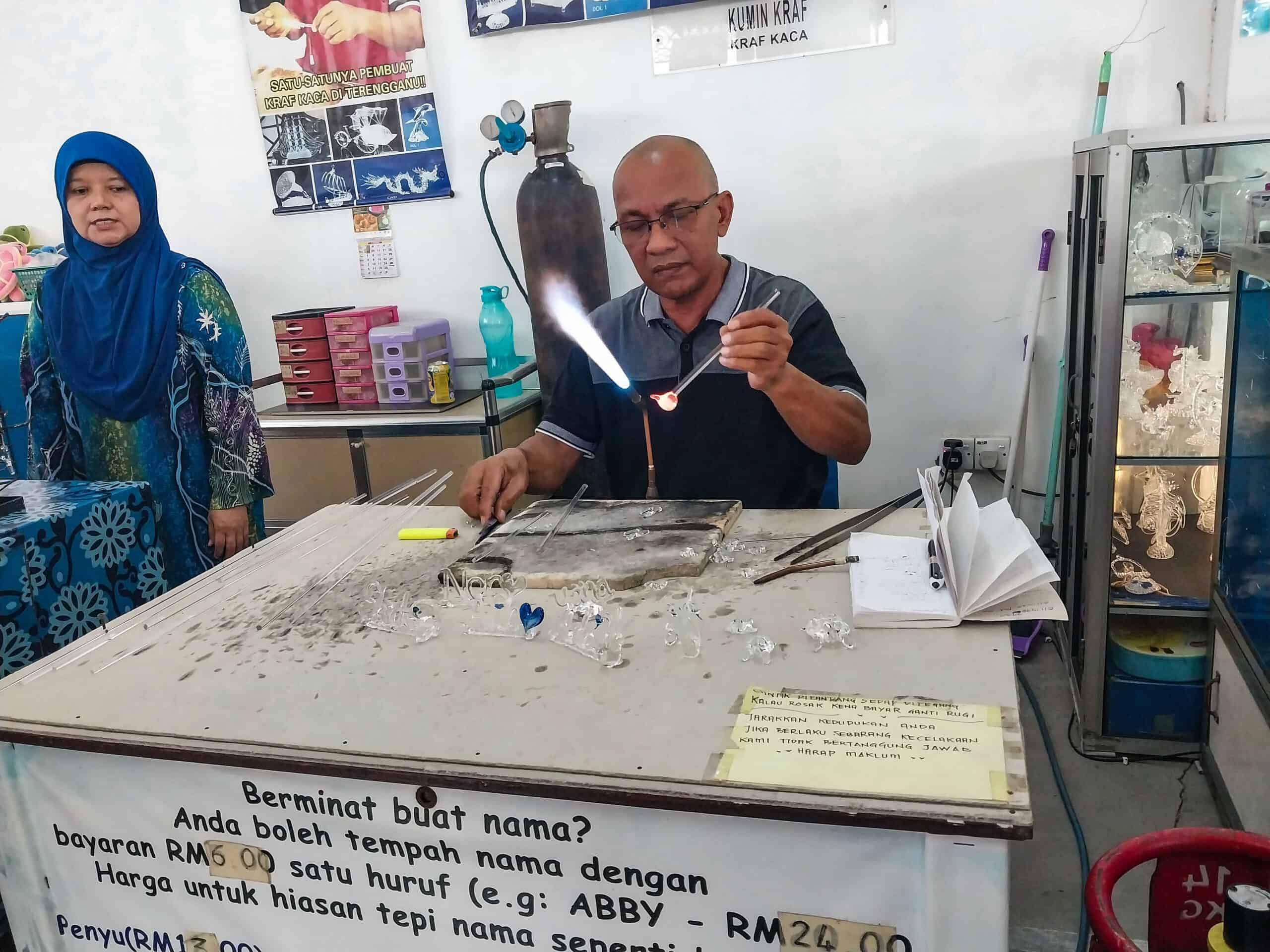
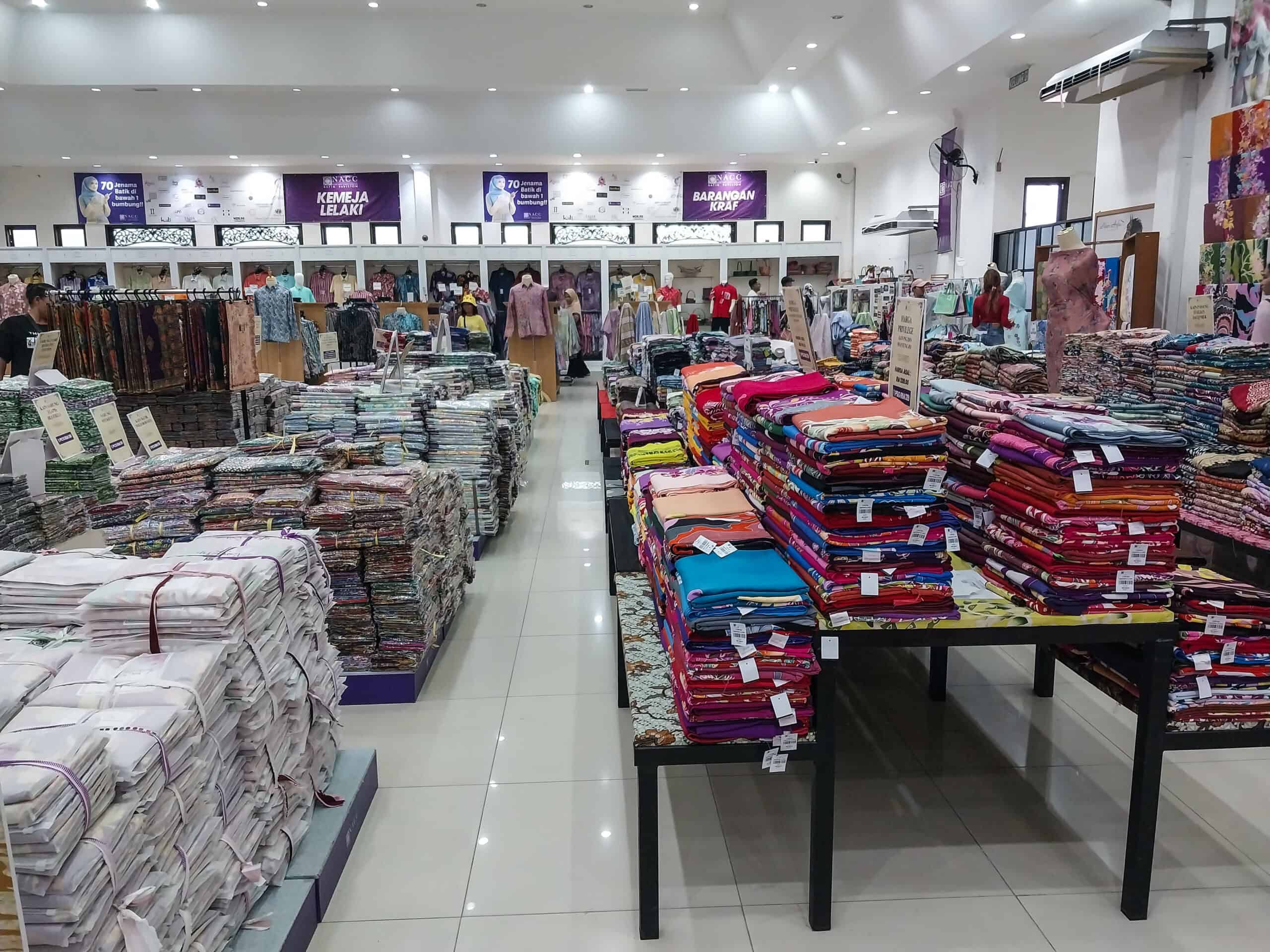
Keropok Lekor 008 Kelulut: We made one last Terengganu food stop at Keropok Lekor 008 Kelulut, just outside Kuala Terengganu, to try their famous keropok lekor. I’ve had it before in Kedah, and I can’t say it’s one of my favorite local foods, but Terengganu’s version wasn’t too bad.
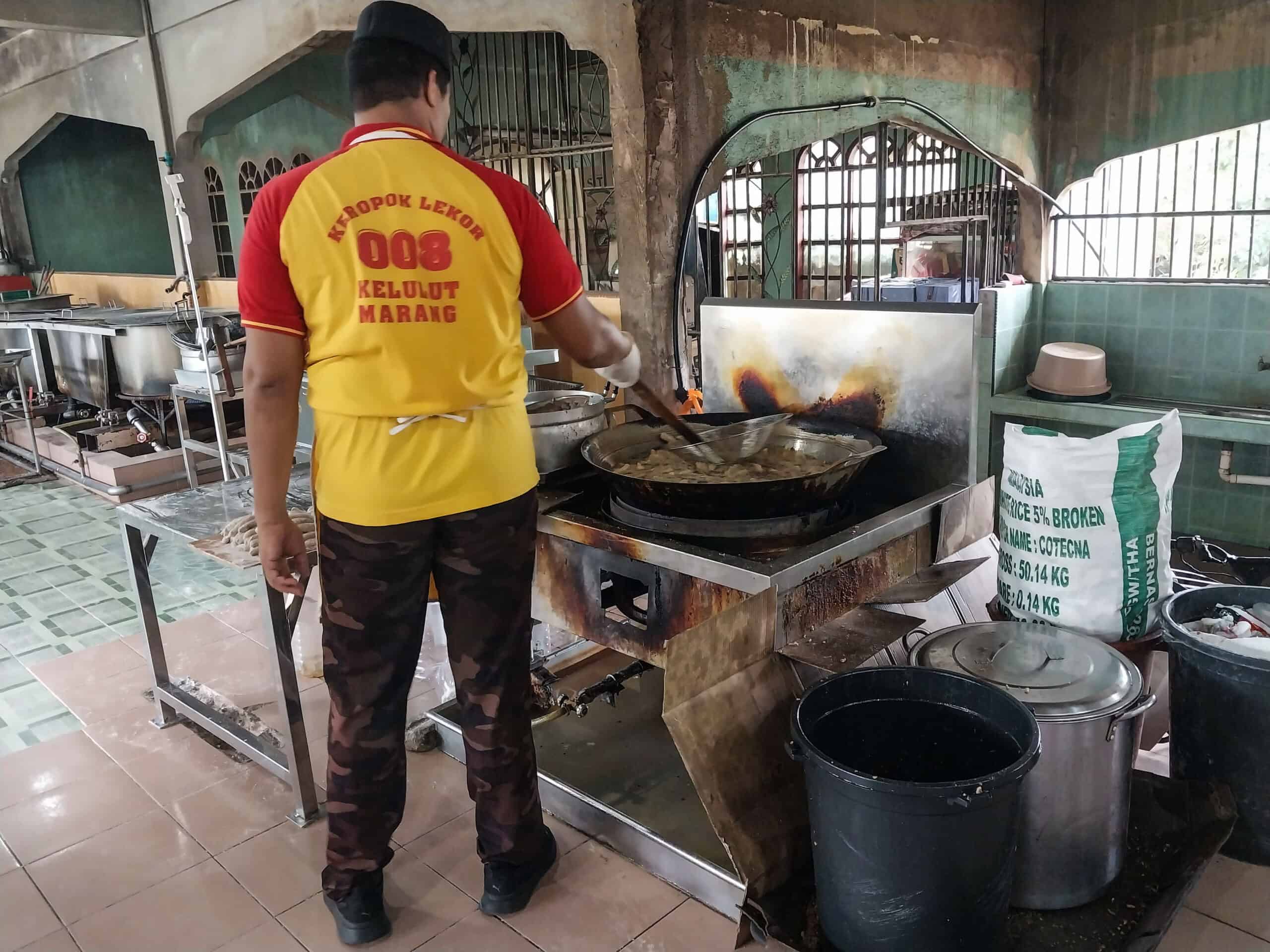
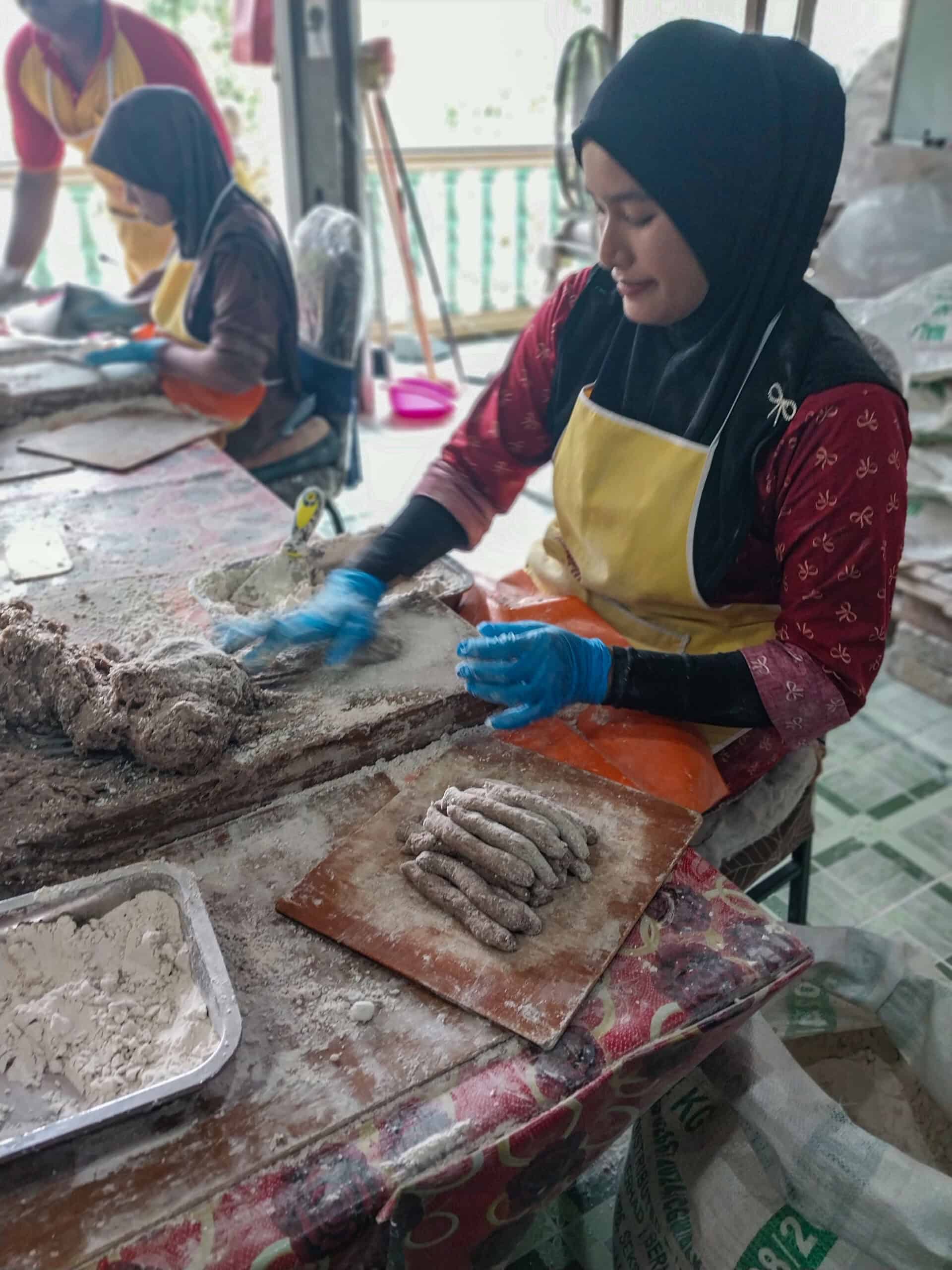
This traditional snack goes back generations and was originally developed by fishing communities to preserve excess catch, usually anchovies or sardines. The name comes from the Malay word lekor, meaning “to roll,” referring to how the fish paste is mixed with sago flour and shaped into long rolls. These are then boiled or fried. The result is dense and chewy, with a slightly fishy taste. It’s not everyone’s cup of tea, but the sweet chili dipping sauce helps balance it out.

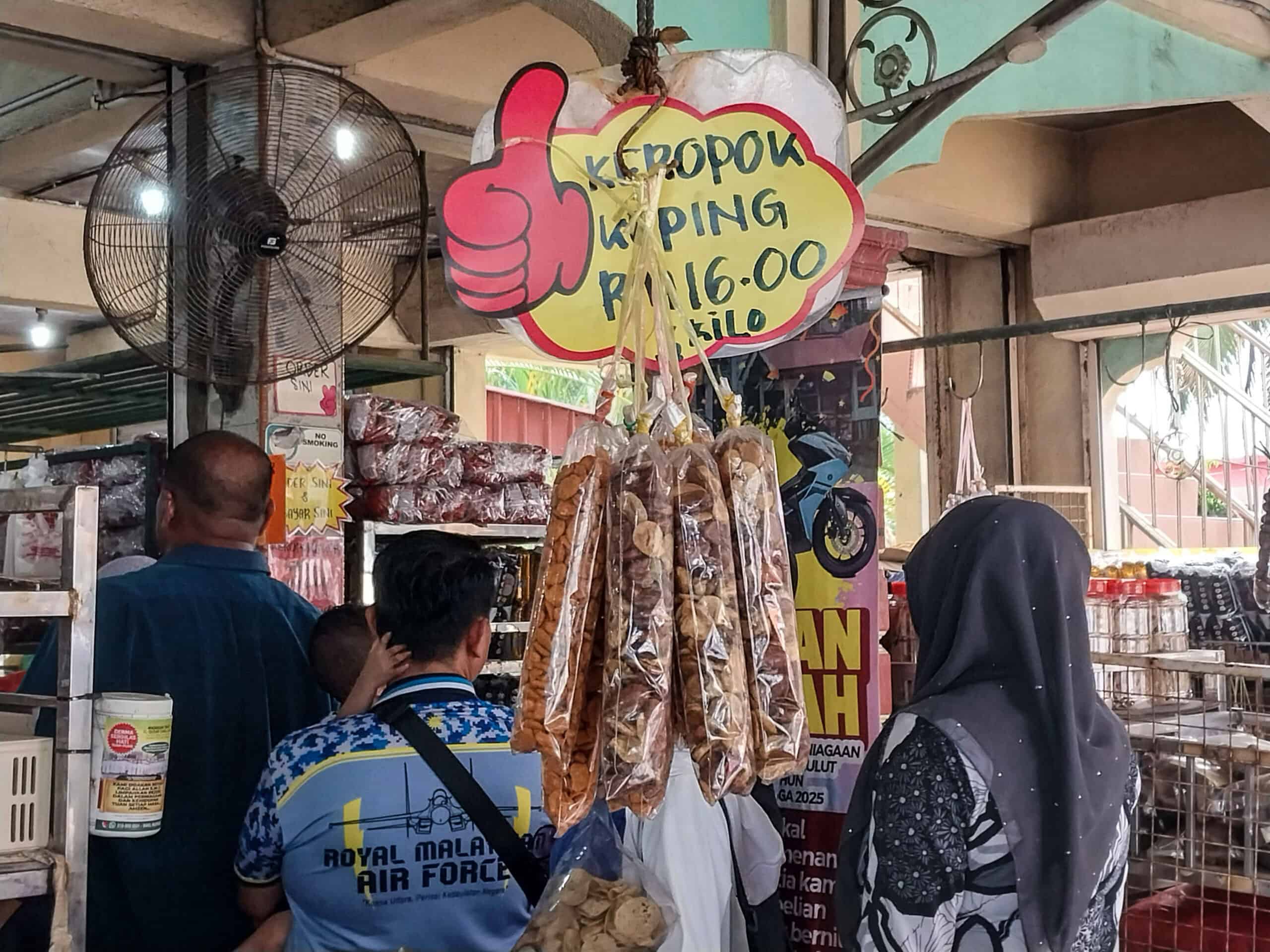
There are two common versions: rebus (boiled) and goreng (fried), with the fried version generally more popular. And if there’s any doubt about its popularity, just take a look at the line of customers outside Keropok Lekor 008 Kelulut on any given day. Keropok Lekor 008 Kelulut, near Marang / Open: Sat–Thurs: 9am–11pm
Where to Eat in Kuala Terengganu
The food I tried in Kuala Terengganu was across the board exceptional. My hats off to the following restaurants as they are all top notch.
Singgang Budu
Specializing in bold, traditional east coast dishes like namesake dishes singgang (sour-spiced fish broth) and budu (fermented anchovy sauce with raw herbs). If you’re into strong, punchy flavors and lots of selections to choose from, Singgang Budu is the place. Open daily: 10am to 5pm
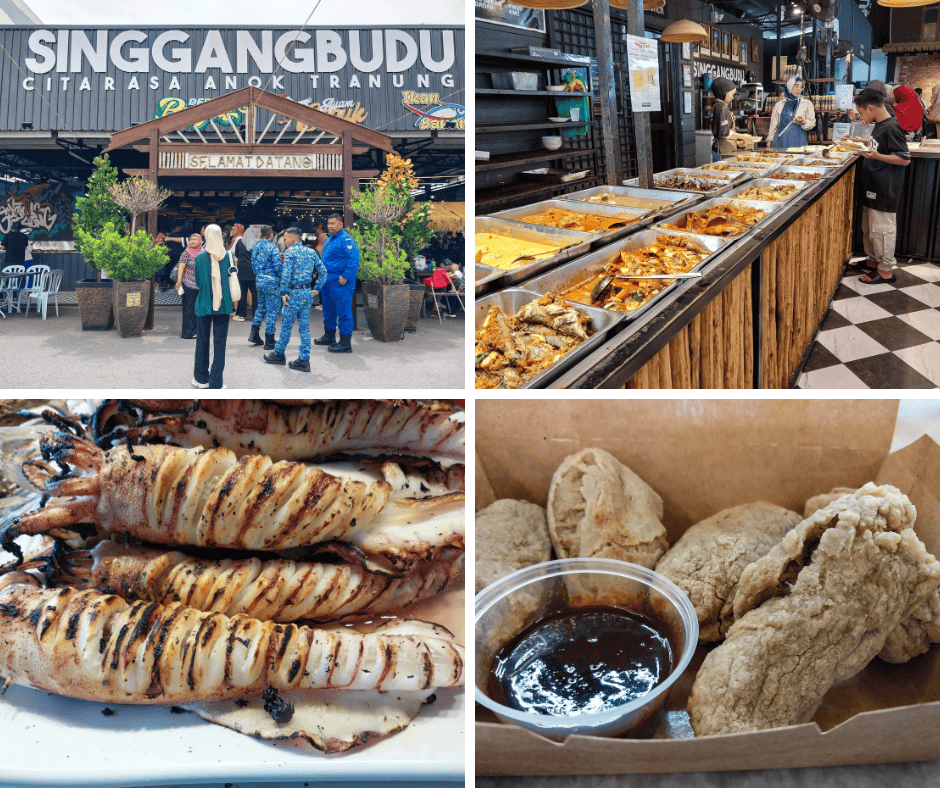
D’Suasana Ibai Restaurant
A casual open-air restaurant right by the water. Expect solid grilled fish, local gulai, and plenty of sambal. The portions are meant for sharing and the place gets busy in the evenings. Perfect for a relaxing dinner near the riverside. Open daily: 11am to 12am
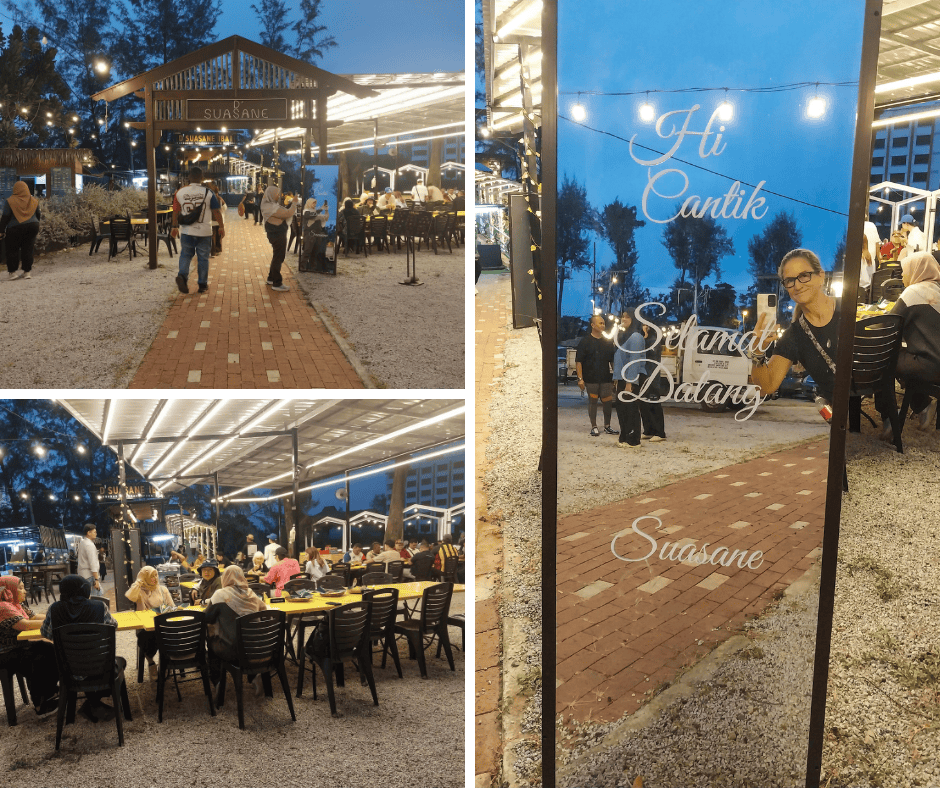
Warung Dalam Kenangan
A long-time local favorite for early meals and lunch, especially Nasi Dagang and Ikan Singgang. The red rice is soft and fragrant, paired with light curry or sour turmeric fish broth. Simple food done well, with no extras or fuss. Prices are affordable, service is quick, and regulars keep the place busy all year. Open: Thurs to Tues: 11am to 11pm
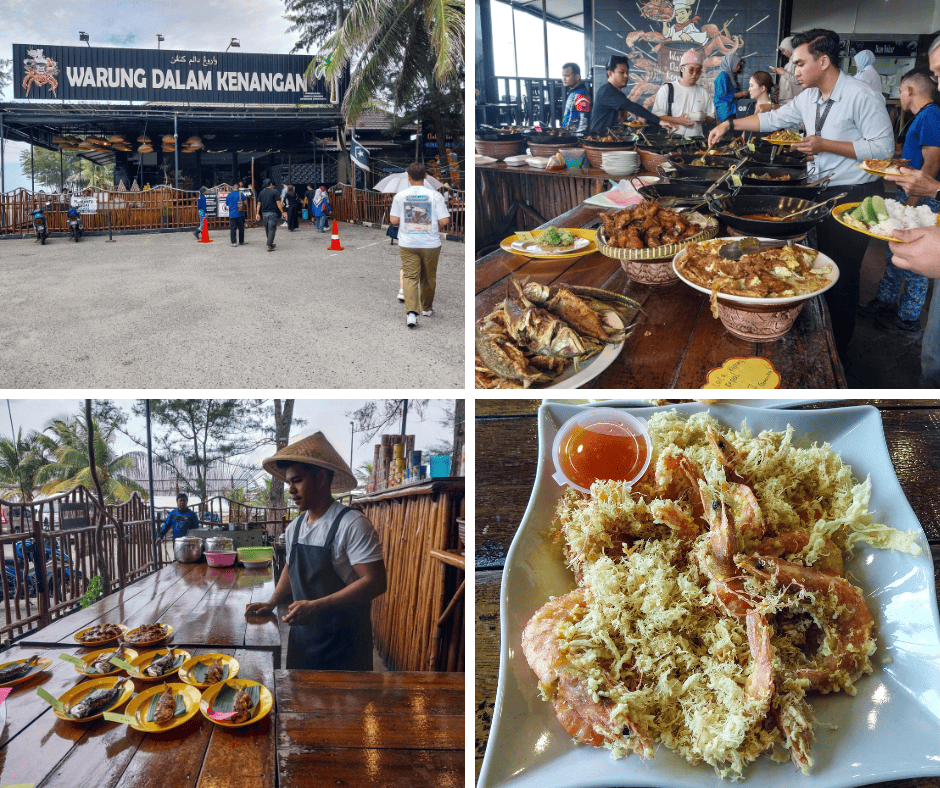
Roselle @Eleven at Paya Bunga Hotel
Inside Paya Bunga Hotel, poolside Roselle @Eleven serves a rotating buffet of traditional Terengganu dishes: grilled fish, hearty curries, rice sets, and classic desserts. Clean, spacious, and ideal for families or anyone wanting a full meal without guessing what to order. Open daily: 6:30am to 11pm
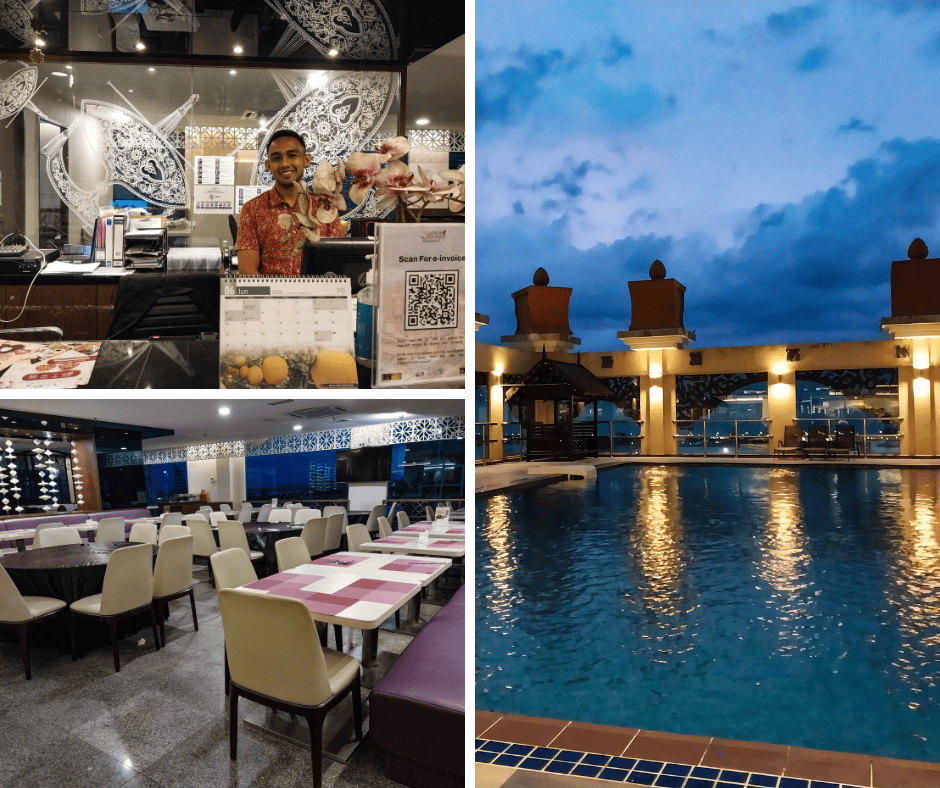
Where to Stay in Kuala Terengganu
Although we spent the duration of our media trip at the lovely Primula Beach Hotel, we did visit the other two; Hotel Seri and Paya Bunga Hotel. All three would definitely be my top choices for my next trip to Kuala Terengganu
Primula Beach Hotel: Beachfront Bliss
A beachfront stay with direct access to the sand and sea. Classic vibes with sea views, spacious rooms, and a peaceful location. Good for those who like long walks on the beach and want to relax away from the city center. A massive shopping center is just a stone’s throw away as is a lively seaside night market. www. primula-hotel.com
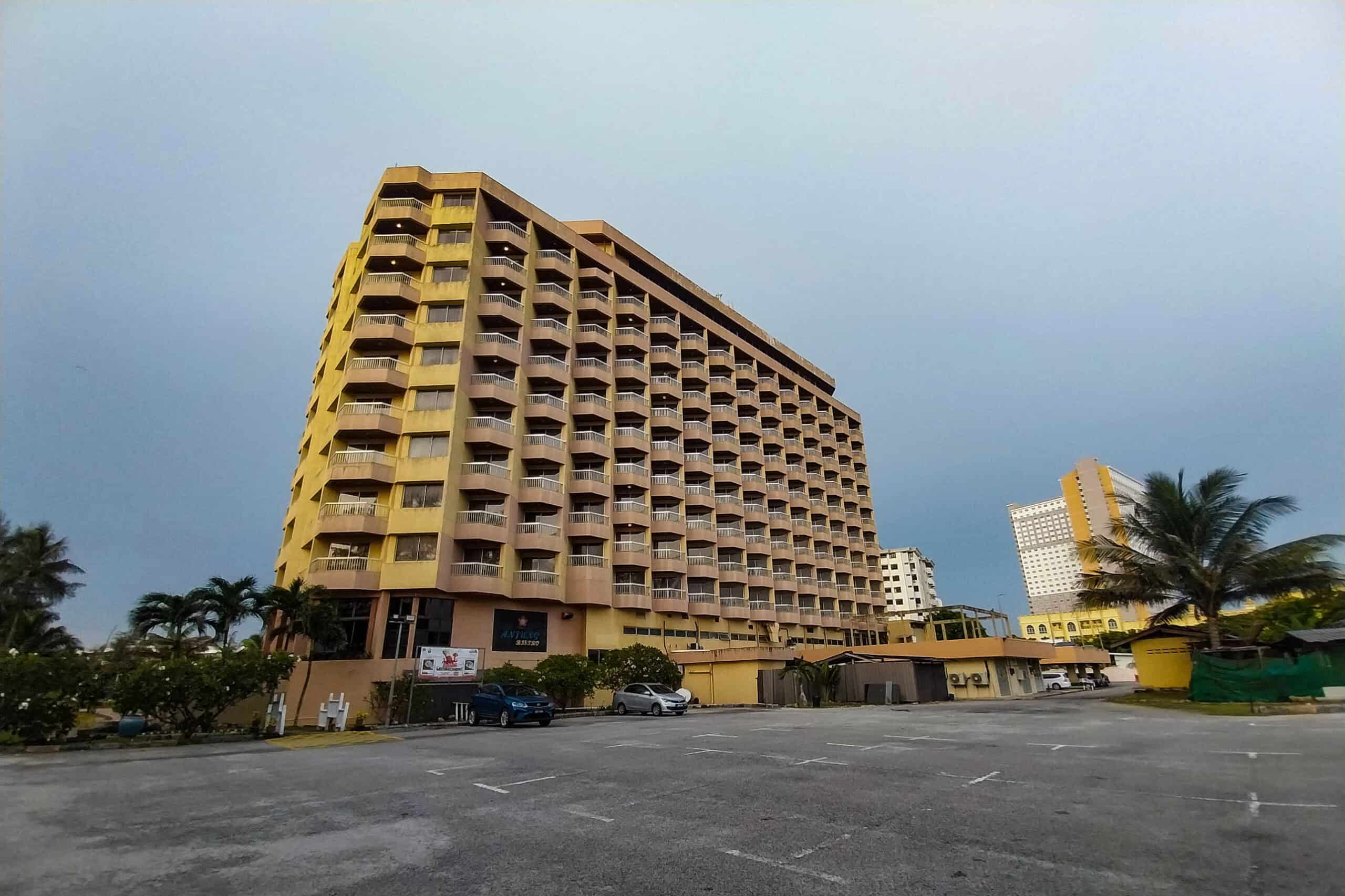
Hotel Seri Malaysia Kuala Terengganu: Convenient and Budget-Friendly
Waterfront Hotel Seri Malaysia is close to Chinatown and Uptown Pulau Warisan Night Market,. A practical choice with clean rooms, breakfast included, and easy access to local sights and shops. Good for short stays or budget travelers. www.serimalaysia.com.my
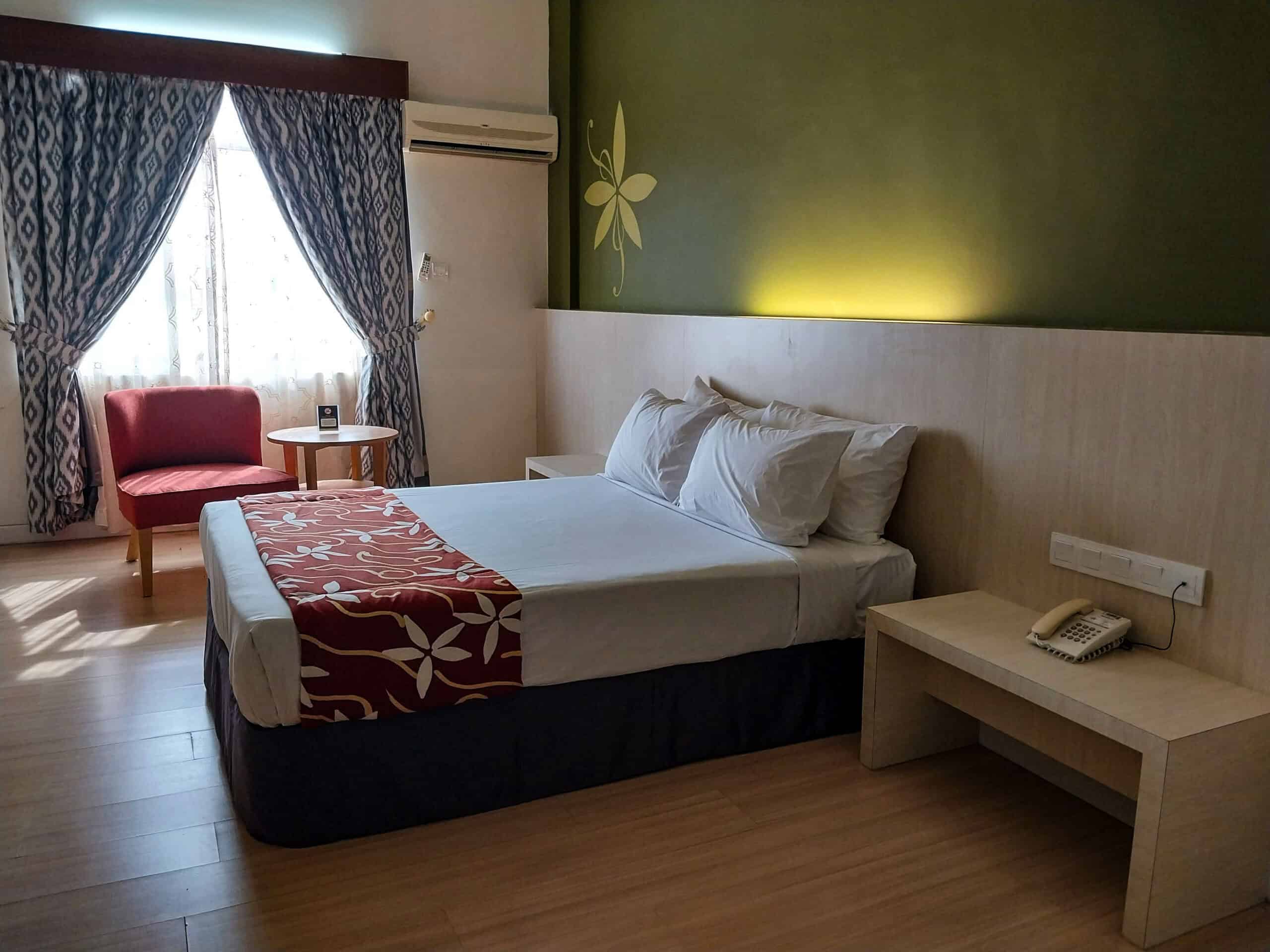
Paya Bunga Hotel : Centrally located
Located in the heart of the city, the rather cool looking Paya Bunga Hotel is surprisingly inexpensive. It’s also minutes from the iconic drawbridge and main market. Spacious rooms, friendly service, and poolside dining upstairs make it a smart, easy option. www.payabungahotel.com
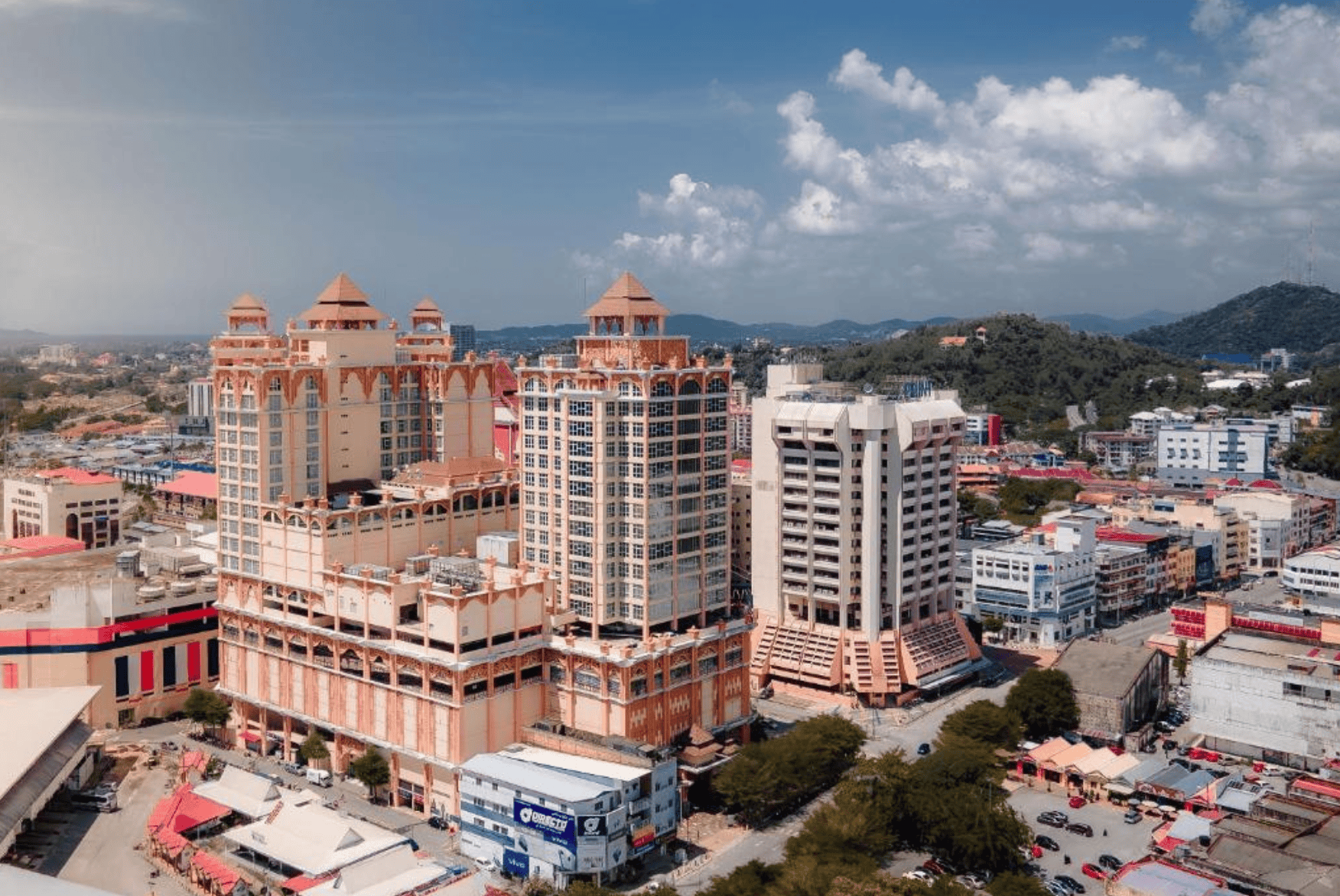
How to Get to Kuala Terengganu: Bus, Car or Flight?
As mentioned earlier, the bus to Kuala Terengganu is an almost pleasant experience. However, if you’re heading back to Kuala Lumpur (or another major city) after a long weekend, it won’t be fun. Expect heavy traffic. Midweek travel tends to be smoother, so consider that when planning your trip. Or, of course, you could always just fly back.
By air
One-hour flight from KLIA or Subang Airport to Sultan Mahmud Airport
By car
Seven to eight hours’ drive from Kuala Lumpur via the East Coast Expressway
By bus
Direct buses from Terminal Bersepadu Selatan (TBS) in Kuala Lumpur take approximately eight hours
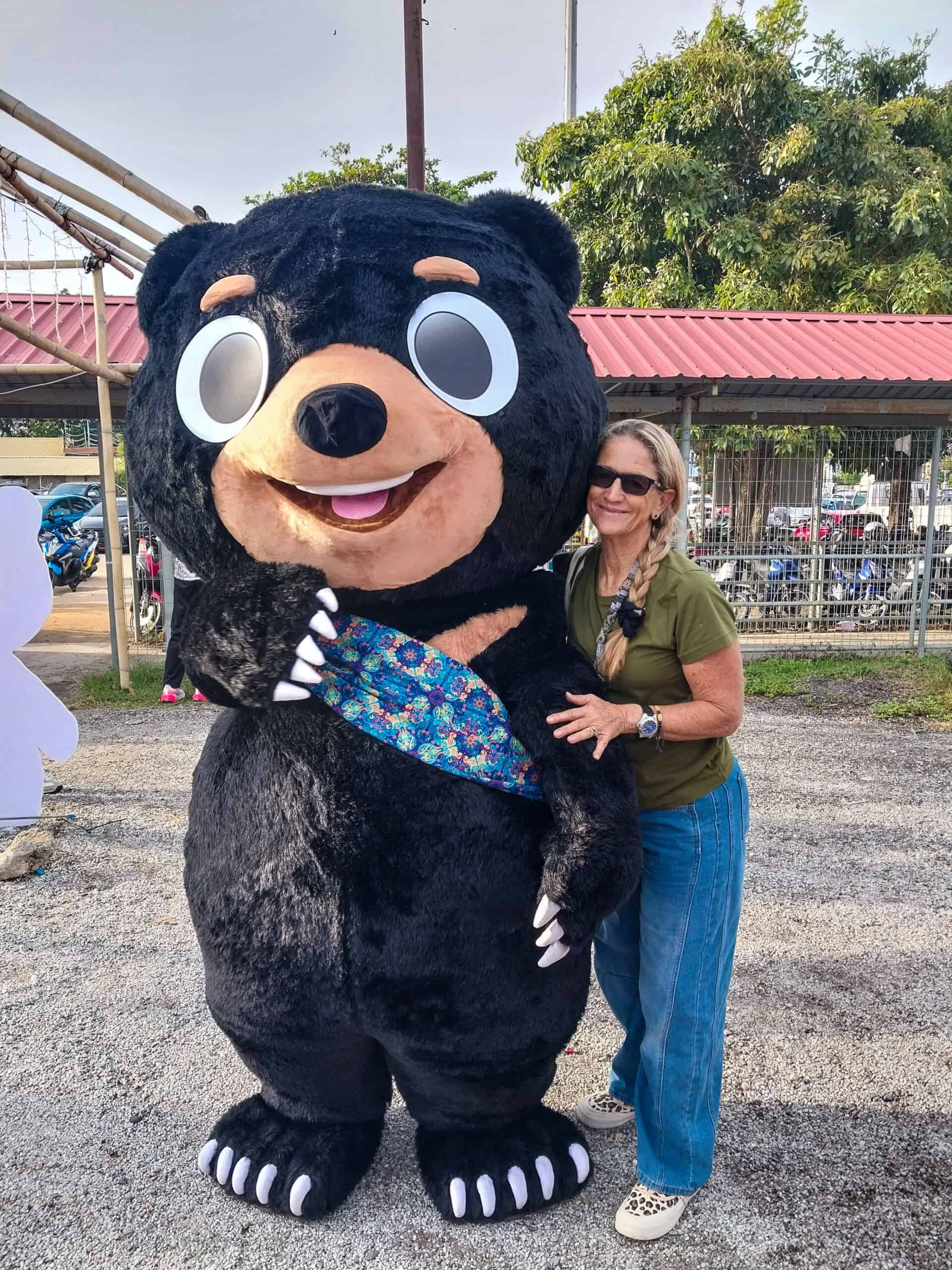
Is Kuala Terengganu Worth Visiting?
Absolutely, whether you are squid jigging or not. While often overlooked as a must-visit Malaysian destination, Kuala Terengganu offers unique cultural sites, fantastic traditional cuisine, gorgeous beaches, and even a few nearby pristine islands. It might just be that hidden gem you’ve been looking for. I’ll definitely be back.

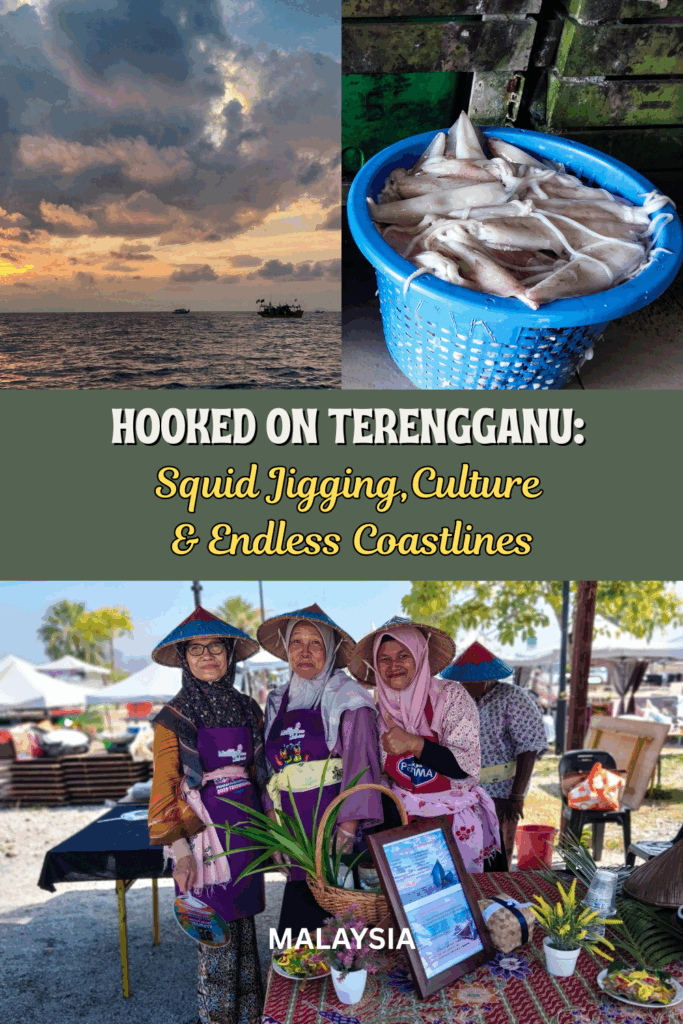
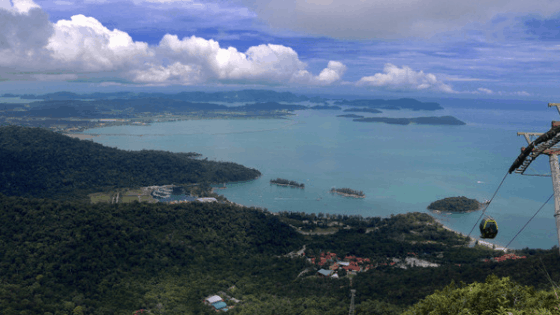
Leave a Reply